Australian
and international
exploratory
performance and
media arts
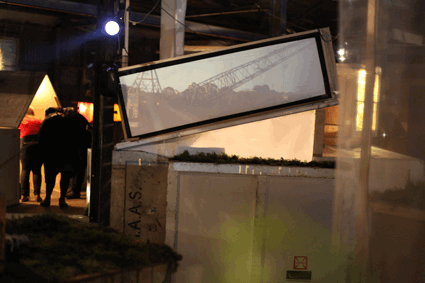
Case Study
photos Justin Harvey
Case Study
WHEN UNDERBELLY FESTIVAL DIRECTOR IMOGEN SEMMLER CASUALLY QUIPPED IN RT103, “PEOPLE LIKE GOING OUT TO COCKATOO ISLAND,” I’M NOT SURE SHE REALISED JUST HOW MUCH: AUDIENCES FOR THE FINAL FESTIVAL DAY—THE CULMINATION OF A 16-DAY DEVELOPMENT LAB—FAR EXCEEDED EXPECTATIONS, REACHING 2,200 PEOPLE.
Extra ferries had to be scheduled as the normal service became taxed, people were turned away at the entrance at times as the festival reached capacity and queues grew to Depression era proportions. Throngs of people across a broad demographic seem to be interested in the alternative arts, as long as they’re in a fascinating location.
Of course the downside was that many of the performance works were designed for a limited audience (some one or four at a time) and even the centerpiece, OJO by Strings Attached with a capacity of 500, was fully booked by the time I arrived at 4pm, so I have to admit, I failed the Underbelly challenge. However I tracked down some esteemed colleagues, Teik-Kim Pok and Sarah Miller, who had much better time management skills, to comment on some of these works. For my part, I spent my time queuing (to no avail) and taking in the installation works that inhabited the nooks and crannies of Cockatoo Island.
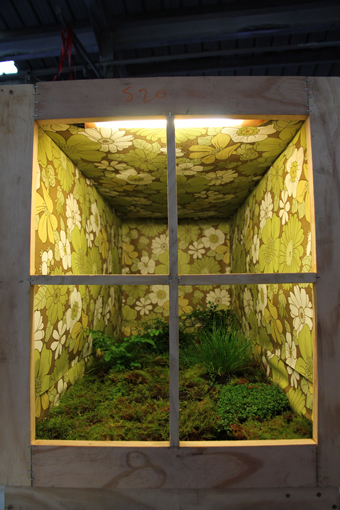
Case Study
photo Justin Harvey
Case Study
case study, [xuan] spring, pattern machine
The most impressive installation, and perhaps the most intensive process in Underbelly was Case Study in which six artists—Perran Costi, Jesse Cox, Emily McDaniel, Adam Parsons, Damian Martin and Justin Harvey—moved to the island for the 16-day lab, taking with them only a suitcase. If there were any Survivor-style power plays during the development the final installation was a picture of harmonious communal living. A series of makeshift huts and lean-tos were scattered around an old workshop, each with bedding, curtains, found objects and text curios. Some hummed with quiet sound installations and most glowed hauntingly with projected stills and videos. Plant and moss specimens from around the island adorned surfaces like miniature gardens and small assemblages were to be found in nearly every crevice. Exploring issues of inhabitation, colonisation and migration, Case Study offered a wabi-sabi micro-environment of wonderful intricacy.
![[Xuan] Spring, Ngoc Nguyen](https://www.realtime.org.au/wp-content/uploads/art/48/4854_priest_spring.gif)
[Xuan] Spring, Ngoc Nguyen
courtesy the artist
[Xuan] Spring, Ngoc Nguyen
Ngoc Nguyen also worked with ideas of domesticity in her installation, [Xuan] Spring. During the Lab she photographed the interiors of several of the abandoned houses on the island adorned with objects and elements associated with the Vietnamese Spring Festival. For the final installation the photographs were displayed in a small office/workshop, accompanied by rows of spring plants and flowers. The beautiful simplicity and intimacy of the work was reinforced by the presence of family members serving sweets and tea to visitors. Nguyen’s Spring was impressive for its subtle, yet no less integrated, use of the site
Pattern Machine was an intriguing audiovisual environment and performance by James Nichols, Dan MacKinlay, Jean Poole and Sarah Harvie. A giant inflatable wormlike object occupied one end of a vast workshop while video projections adorned the far end, glancing across a magnificent piece of old machinery. As was the case with most things in Underbelly, I didn’t catch the whole performance (I had to run to catch the ferry home), but the 20 minutes I experienced offered a rich soundscape of field recordings—flocking seagulls, machine rumbles—underpinned by sweet synthesiser tones delivered quadrophonically, with some great use of video masking to create projections that worked specifically with the architectural features.
Gail Priest
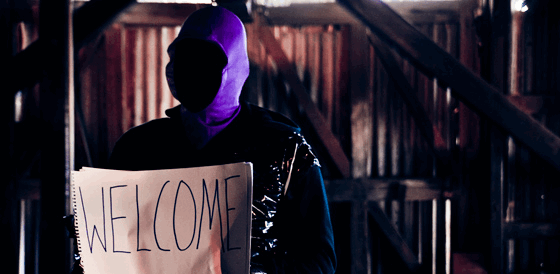
Fetish Frequency, Inflection
photos Dylan Tonkin
Fetish Frequency, Inflection
inflection, all you can stand buffet, awful literature is still literature I guess
The island’s colourful past evokes treasure hunt sensibilities and attempting to live up to this promise of adventure, some of the artists responded with works exploring audience interaction. Inflection, an “interactive theatre game,” asks us to imagine an alternate version of Cockatoo Island. Stumbling into the middle of the story, I meet a troupe of ‘facilitators’ in a low-ceilinged room in the Naval Store, black stockings masking their faces. In the centre is a mannequin torso sitting upright amongst black garbage material surrounded by photos of various sites on the island laid out in an ominous looking ring. Above this is a clue played on video loop, prompting us to carry out one of five major rituals. A few audience members hesitantly step forward to fulfill one of these tasks: “build a lover from these objects.” Unfortunately, given the nature of the event, I have to move on and fail to witness the conclusion of this action, but Fetish Frequency’s haunting mix of audience-driven storytelling and installation building/intervening is something I hope to experience in their next outing.
Next door our Underbelly experience was becoming more rumble-belly as we anticipated a feast of sorts in Butterfries’ All You Can Stand Buffet. Billed as ‘’the disfigured love child of Dante’s Inferno and Sizzler,” we are ushered in by a performer who lays out the ground rules (replete with end-of-days metaphors) for moving through the rooms—each a different buffet ‘course’—the changes signaled by the loud clanging of a steel salad bowl.
Beginning our first course we are surrounded by mounds of strewn rubbish and encouraged to sift through black garbage bags for barely edible items, among them heads of iceberg lettuce left in various states of defoliation by previous audiences. Accompanying this is a diatribe on Third World famine and an exhortation to overcome our privileged First World disgust. This prompted some in my audience, already familiar with the practice of dumpster-diving and the earnest activist tenor of the work, to respond in one-upmanship from then on, to which the Butterfries team struggled to respond. Subsequent courses included being force-fed bread rolls, served minestrone soup out of a cling-wrap lined toilet, a makeshift abattoir with a row of raw chickens impaled on a wall overlooking a blood-soaked floor and a dinner party where two performers’ strained exchange invited my restless audience group to weigh in, escalating the action into a food fight. While Butterfries’ audience-wrangling strategies need bolstering, their efforts to visually reference the aesthetic of disgust is a worthwhile achievement for their first collaborative effort.
I choose to decompress from the gastronomic challenge by visiting the Festival Bar for some mulled wine while taking in one of the more relaxed offerings, Applespiel’s Awful Literature is Still Literature I Guess. At this point, surrounded by towers of books, they regale us with a series of abject confessionals which segue into an ironic promotion of books considered obscure and questionable in literary merit completing the bar’s role as a sensory pit-stop for the traumatised, exhilarated and perplexed among us island-hopping conceptual treasure hunters.
Teik-Kim Pok
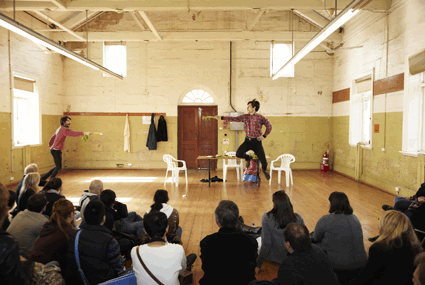
Whale Chorus, Rhapsody, Paul Blenheim, James Brown, Janie Gibson
photos Josh Morris
Whale Chorus, Rhapsody, Paul Blenheim, James Brown, Janie Gibson
rhapsody, ojo, v
Whale Chorus took the idea of the musical and broke it right across their collective hootenanny kneecaps in Rhapsody. Even at this early stage of development, this short work-in-progress was performed with panache by Matt Prest, Janie Gibson and Paul Blenheim. It was silly, smart, kitsch and funny.
Referencing everything yet nothing I could quite put my finger on, Rhapsody evoked moments of Oklahoma but also Deliverance, Seven Brides for Seven Brothers and Psycho, not to mention various high school musicals, segueing from popular culture to irreligious cult. The costuming for Paul Blenheim and Matt Prest—red checked shirts and tight black pants—was inspired while Janie Gibson’s deadpan Doris Day provided a great counterpoint to boyish petulance, blokey bravado and dang-crazy angst.
Whale Chorus “aims to borrow techniques used for creating music to create theatre” and the effect of translating musical concepts such as polyphony and dissonance into theatrical manoeuvres leads them into some hilariously unlikely places. Matt Prest’s delivery of the Beatles’ “Taxman,” and Janie Gibson’s attempts to get two reluctant lads to sing the Judy Garland standard “Good Morning” reminded me of classic comedy—think Marx Brothers or Laurel and Hardy without the pratfalls. Kazoo, celery, song, story and hypnotism were brought together in an absurd narrative to create something utterly idiosyncratic and funny.
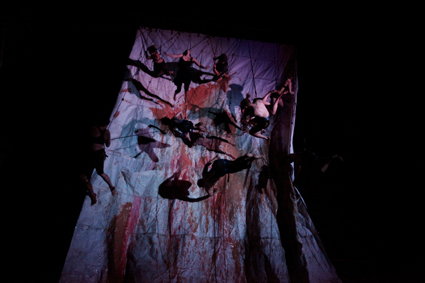
OJO, Strings Attached & Younes Bachir, Underbelly
photo Catherine McElhone
OJO, Strings Attached & Younes Bachir, Underbelly
At the other end of the emotional spectrum was OJO created by Strings Attached and Younes Bachir, previously a collaborator with La Fura dels Baus. Brought to Australia by Deborah Leiser-Moore, Artistic Director of Tashmadada (Melbourne), Bachir worked with a large group of highly skilled physical theatre performers as well as emerging practitioners.
Performed at one end of the cavernous Turbine Hall, the work begins before the audience enters the space, with a single performer hoisted high in the air, flailing and spitting words at the gods. On the other side of a large curtain, the audience stumbles across bodies sprawled or curled foetus-like on muddy, wet concrete floors amidst the wreckage and detritus of modern industrial society. The imagery is apocalyptic, the performers intense, edgy and focused. I’m reminded of Nietzche’s dark “primordial unity” that seeks to awaken our Dionysian nature through an evocation of the primal, ritual, extreme physicality and chaos as a means of bringing us to harmony.
Anyone old enough to experience the 1989 production of La Fura dels Baus’ Suz/o/Suz at the Hordern Pavilion will remember the massive spectacle and ritualistic nature of the work: blinding lights, cacophonous noise, water and mud, sex, birth, festival, sacrifice and death, combined with a fantastic physicality and extraordinary aerial work. Audience members ran for their lives as huge machines and implacable performers bore down on them.
OJO worked with similar materials and themes, albeit stripped back, and without elaborate or expensive sets, but the experience was no less intense. One of the most thrilling moments occurred when the performers manually dragged the huge machinery high in the ceiling of the Turbine Hall from one end of the performance area to the other. The horrifying yet compelling momentum of the industrial machine—Blake’s “dark satanic mills”—and its devastating impact on the natural world was powerfully evoked.
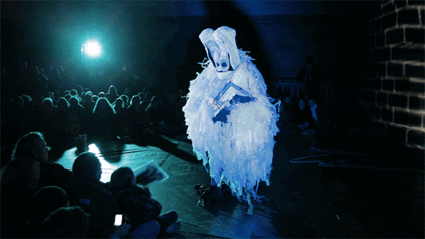
Justin Shoulder, V
video stills Sam James
Justin Shoulder, V
From darkness into light, the strangely weird and fantastical creature that is V emerges from an old, sandstone house in the convict courtyard, one of the oldest sites on the island. White gridlines shimmer and pulsate like visible electricity as this urban demon appears swaying from side to side, carrying a large book with the word V on its cover. An apparition, alien or the ancient ancestor-spirit of Cockatoo island—I have no idea—but that doesn’t stand in the way of my enjoyment of this work. An audiovisual spectacle, this is a huge collaborative effort devised and performed by Justin Shoulder, directed and produced by Jeff Stein in collaboration with composer Nick Wales, a founding member of Coda, video and lighting designer Toby Knyvett working with Sydney Bouhaniche, Cheryle Moore of Frumpus fame and that wizard of theatre spectacle, design and contraption-making, Joey Ruigrok. It was a great end to my Underbelly day.
Sarah Miller
lab work
With the culmination of activities in one big bonanza there is a danger of losing perspective on the developmental status of many of the works in Underbelly, some of which began a mere 16 days before. However audiences could visit the island in the weeks prior to watch the artists right in the midst of the thorny business of artmaking. I regret that I didn’t take up this opportunity, as I may have been able to make a one-on-one appointment with J Dark in Joan of Arc is Alive and Well and Living on Cockatoo Island by Triage Live Art Collective or have the drive-in experience of Julie Vulcan, Ashley Scott and Friends with Deficits’ Spotlight Bunny.
After a smaller-scale festival in the streets of Chippendale last year, the 2011 Underbelly, thanks to its site and more rigorous programming, reached a whole new scale and level of engagement with audiences and artists. If the event continues on Cockatoo Island, it feels as though it would be best to expand to a two-day final event in order to satisfy its eager audience. GP
Underbelly Arts 2011; Case Study, Perran Costi, artists Jesse Cox, Emily McDaniel, Adam Parsons, Damian Martin, Justin Harvey; (Xuan) Spring, artist Ngoc Nguyen; Pattern Machine, artists James Nichols, Dan MacKinlay, Jean Poole, Sarah Harvie; Fetish Frequency, Inflection, artists Jimmy Dalton, Lucy Parakhina, James Peter Brown, Skye Kunstelj, Aimee Horne and Amelia Evans; Butterfries, All You Can Stand Buffet, artists Damien Dunstan, Jennifer Medway, Kirby Medway, Tessa Musskett; Applespiel, Awful Literature is Still Literature I Guess, artists Simon Binns, Nathan Harrison, Nikki Kennedy, Emma McManus, Joseph Parro, Troy Reid, Rachel Roberts, Mark Rogers; Whale Chorus, Rhapsody, artists Matt Prest, Janie Gibson, Paul Blenheim, James Brown; Strings Attached & Younes Bachir, OJO, Younnes Bachir, artists Alejandro Rolandi, LeeAnne Litton, Dean Cross, Kathryn Puie, Angela Goh, Matt Cornell, Mark Hill, Kate Sherman, Carolyn Eccles, Gideon PG, Robbie Ho, Matt Rochford, Elisa Bryant, Charlie Shelly, Julia Landery, Victoria Waghorn, Cameron Lam, Craig Hull, Leanne Kelly; V, artists Justin Shoulder, Jeff Stein, Toby Knyvett, Sydney Bouhaniche, Nick Wales, Cheryle Moore, Joey Ruigrok; Underbelly artistic director Imogen Semmler, executive director Clare Holland; Cockatoo Island, Sydney; Lab July 3-12, Festival July 16; http://underbellyarts.com.au/
This article first appeared in RT e-dition august 23.
RealTime issue #105 Oct-Nov 2011 pg. 5
© Gail Priest & Teik-Kim Pok & Sarah Miller; for permission to reproduce apply to realtime@realtimearts.net
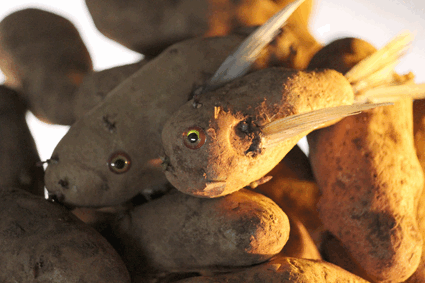
Samantha Scott, Man Made Hybrid
courtesy the artist
Samantha Scott, Man Made Hybrid
we are what we eat
In Samantha Scott’s Man Made Hybrid, potatoes have eyes, actual eyes, and, uhhh… fins. Scott’s delicate and sometimes whimsical assemblages offer wry speculations on the possible ramifications of genetically modifying biology, exploring “the natural imperative of genetic information; the instructions that control how living things grow, develop and carry out life processes and survive (press release).” Scott’s exhibition is part of Craft Victoria’s Craft Cubed Festival 2011 themed HYBRID, offering a month long series of activities including exhibitions, professional development workshops, open studios, a market and an online portal. While you might have missed Adele Varcoe’s iFOLD technique in which she shapes human skin (still attached) into temporary garments, there’s still time to appreciate Tessa Blazey and Alexi Freeman’s Interstellar Gown made from 600 metres of gold plated chain. Man Made Hybrid, Samantha Scott, Aug 23-Sept 3, Heronswood, 105 Latrobe Parade, Dromana, Melbourne; http://craftvic.org.au/craft-cubed/satellite-events/exhibitions/man-made-hybrid; Craft Cubed Festival 2011, various venues across Melbourne, Aug 4-Sept 3; http://craftvic.org.au/craft-cubed
action fashion
public fitting, Mark Titmarsh, Todd Robinson. See Vimeo for full credits
Keeping up the fashion theme is Public Fitting at MOP Projects in Sydney, a collaboration between painter and video artist Mark Titmarsh and former fashion designer now artist Todd Robinson. In a live performance on the opening night, fashion and painting will literally collide in an action painting fashion catwalk free-for-all. The results will be exhibited as garments, videos and paintings exploring the intersection of the artists’ practices. Public Fitting, Mark Titmarsh, Todd Robinson, MOP Projects, Aug 18-Sept Chippendale, Sydney; www.mop.org.au/
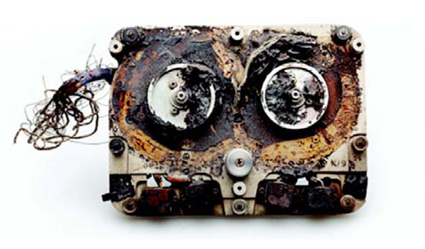
Phoography, Max Lyandvert, George Poonkhin Khut & NIDA Production Students
courtesy the artist
Phoography, Max Lyandvert, George Poonkhin Khut & NIDA Production Students
brainwaves, soundwaves
Max Lyandvert, well known for his dark and haunting soundscapes for theatre, is currently artist-in-residence at NIDA courtesy of the Seaborn, Broughton & Walford Foundation. Collaborating with second year Properties, Costume and Production students Lyandvert has dreamt up the sound installation Phonography, which will inhabit the evocative environment of the Paddington Reservoirs with a “forest of hanging, waterlogged garments fed by currents that turn the clothes into speakers (press release).” The sounds of adjoining Oxford Street will also be fed into the caverns to “make it seem as though the audience is hearing the street sounds above from underwater.” The installation will also feature the work of George Poonkhin Khut further developing his investigations into biofeedback audio installations as he captures people’s brainwaves to create a score for musicians to play. (Read about Khut’s Cardiomorphologies here and here) Phonography, August 24-25, 5-7pm, Paddington Reservoir Gardens, Paddington, Sydney
a room of one’s own
In response to the thriving independent theatre scene in Sydney, The New Theatre has instigated The Spare Room initiative presenting the work of four new-ish local companies. The season kicked off earlier in the year with Dirtyland, a new Australian play by Elise Hearst, and the Australian premiere of UK writer Philip Ridley’s Piranha Heights. The final two shows are coming up starting with Katie Pollock’s A Quiet Night in Rangoon, presented by subtlenuance, telling the story of an Australian journalist in Burma in 2007 during the Saffron Revolution. The final work is Lucky, a physical theatre piece poetically exploring the issue of human trafficking, by Dutch writer Ferenc Alexander Zavaros and presented by IPAN International Performing Arts Network. The New Theatre is currently calling for submissions for its 2012 The Spare Room program with a deadline of September 30. The Spare Room: A Quiet Night in Rangoon, subtlenuance, Aug 18-Sept 10; Lucky, IPAN International Performing Arts Network, Oct 6-22; The New Theatre, Newtown, Sydney; www.newtheatre.org.au
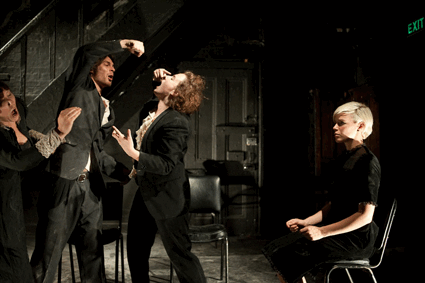
The Hamlet Apocalypse, The Danger Ensemble (Melbourne production)
photo Morgan Roberts
The Hamlet Apocalypse, The Danger Ensemble (Melbourne production)
the end of the world as we know it
La Boite has also been showcasing the Brisbane independent theatre scene through its Indie Series. The final installment is by The Danger Ensemble presenting The Hamlet Apocalypse (to be reviewed in RT105): a group of six actors performing Shakespeare’s Hamlet on the eve of the end of the world. The Danger Ensemble is made up of artists from diverse performance backgrounds including Butoh, physical theatre and experimental cabaret. Director Steven Mitchell Wright writes: “We have gone down the path that leaves the work the most open, where time is broken and glimpses of truth and experience can be accessed by the audience in a non-literal and anti-theatrical way (director’s notes).” While Mitchell believes the work “will polarise audiences,” the production was very well received at the Melbourne Fringe Festival in 2010. La Boite Indie, The Hamlet Apocalypse, The Danger Ensemble, Aug 26-Sept 11, La Boite Theatre, Brisbane; www.laboite.com.au; www.dangerensemble.com
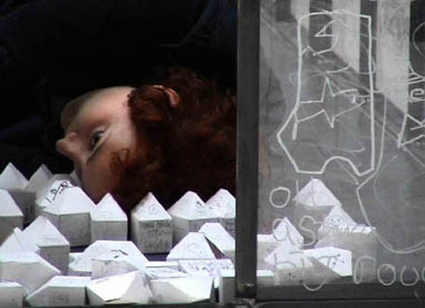
Quiet Time workshop with Reckless Sleepers
courtesy the company
Quiet Time workshop with Reckless Sleepers
a bit of shush
CIA Studios in Perth is calling for participants for Quiet Time, a workshop with Mole Wetherell from the UK/Belgium group Reckless Sleepers. Quiet Time will bring together 10 artists from a range of artform areas to explore the “the city as a basis for research and stimulus(media release).” Reckless Sleepers formed in 1988 and often work with a research and residency model to create cross-disciplinary, site-specific works that are “installed rather than presented (company website).” The workshop will take place in December, with applications closing August 29. Participant stipends and interstate travel allowances are available to assist artists to attend the Lab. For more information or to be sent an application form email kate@pvicollective.com; www.ciastudios.com.au/
RealTime issue #104 Aug-Sept 2011 pg. web
© RealTime ; for permission to reproduce apply to realtime@realtimearts.net
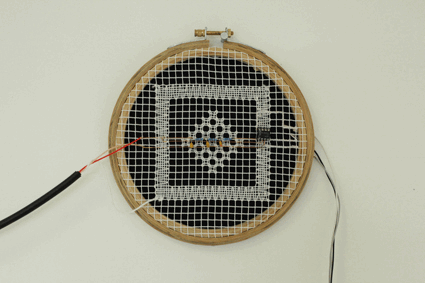
Emily Morandini, filet électronique
photo Kusum Normoyle
Emily Morandini, filet électronique
ON THE LEAFY FRINGE OF CAMPERDOWN PARK, I.C.A.N.’S (INSTITUTE OF CONTEMPORARY ART NEWTOWN) NEWEST SHOW ADDS A LAYER OF ANACHRONISM TO THEIR TRADEMARK INCONGRUITY. FILET ÉLECTRONIQUE/ISLAND IS A GENTEEL COLLECTION OF POST-SUBURBAN ARTEFACTS IN THE VERY URBAN FRINGE. A CONTEMPORARY SALON APOCALYPTICISM, OR SOME FUTURE ARCHAEOLOGICAL RECONSTRUCTION UNSTUCK IN TIME—WHATEVER… THIS SHOPFRONT STANDS OUT FROM THE BROWN AND IMPERTURBABLE LINE-UP OF DECENT LIFE LIKE MAD MAX IN CRINOLINE.
Emily Morandini’s piece is the filet électronique and has the virtue of a completely self-descriptive name. Round filet lace nets are threaded with copper needlework, punctuated at the ends by batteries and speakers, emitting a treble whine. Yep, networks, right angles, minute interconnected fibres—craft had ’em before mass electronics. Check, check and check. You remember the Hyperbolic Crochet Reef (created by Christine and Margaret Wertheim, http://crochetcoralreef.org) where dainty handicraft recalls raw nature? This is the yang to that yin, a stitched homage to circuitry over coral, courtly handicraft for the post-technological parlour.
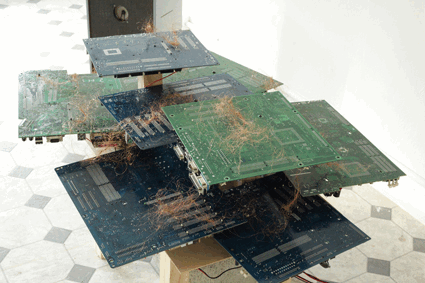
Peter Blamey, Island
photo Kusum Normoyle
Peter Blamey, Island
Two octaves below, Peter Blamey’s Island also hums, and occasionally squeals. This originates in a different future, long after the Anthropocene. It’s not needlepoint, or anything else from CRAFT magazine. Blamey liberates himself from the conventions of traditional handicraft by participating in the plastic, evolving genre of repurposing illegally dumped crap off the street.
A bouquet of found circuit boards opens leaf-wise, with machine-drilled pores and copper-etched capillaries. This is one part robotic Ikebana to two spontaneously generated silicon organisms. The surface is dusted with a faint fuzz of copper floss, moving in the air currents, and it squeals as you brush it, like an electric touch-me-not.
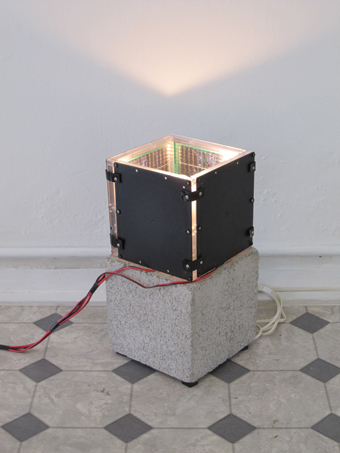
Peter Blamey, Island
photo Kusum Normoyle
Peter Blamey, Island
The piece itself is embedded in the flows of that neo-ecology—mineral waste digesting in the urban metabolism—its body scrap accretions of once-were appliances. This assemblage of motherboards and speakers is powered parodically and circuitously: electricity is derived from a solar panel lampshade which wraps around an incandescent light bulb, a ‘detrivore’ feeding off oil in a travesty of photosynthesis. Conductive cilia wave in the ambient radio fields, recycling electromagnetic waste into mindless warbling.
Where the connectivity in Morandini’s piece is punning, verbal and personal, Blamey’s work is direct, physical and inhuman, the waste fields of a million appliances made audible. The sound from those speakers is the unfiltered interference from the ad hoc antennae of the circuit-boards, performed it seems, for ears other than ours: the secret life of circuits, played out on an Earth after us.
Here are two sardonic takes on the DIY resurgence. Post-consumerist transposed into post-consumer in a world where DIY has been associated as often with fertiliser bombs as with handicraft; where survivalism and tree changing vie for fertile land; where going back to the land may lead you to an open-cut pit, or a strip mall, but you decide to stay there and till it yet.
Emily Morandini & Peter Blamey – filet électronique/island, ICAN, Sydney; July 22-Aug 7; http://interlaps-overlaces.tumblr.com/; http://icanart.wordpress.com/2011/07/19/july-2011-electronique-filet-island/
RealTime issue #104 Aug-Sept 2011 pg. web
© Dan MacKinlay; for permission to reproduce apply to realtime@realtimearts.net
{$slideshow} MARTHA GRAHAM WROTE, VERY BEAUTIFULLY, “TO UNDERSTAND DANCE FOR WHAT IT IS, IT IS NECESSARY WE KNOW FROM WHENCE IT COMES AND WHERE IT GOES” (MARTHA GRAHAM, PRINCETON UNIVERSITY PRESS, 1966).
Some theorists, such as André Lepecki, make a big deal out of the melancholy of the dance critic, imbuing the experience of writing about movement with a sense of loss (however unintentionally) that I have always found melodramatic. But the question of remembrance is related to culture, to fashion, to fame, to legacy and as such is more interesting to the critic and to the choreographer than to the dancer. To dance is to revel in the now.
Dance improvisation has to be understood as something very different from finished choreography. Choreography is to movement what a play is to stage presence: a set of directions, located outside particular time and space; universal and thus generic. Says William Forsythe: “The purpose of improvisation is to defeat choreography.” All the arguments made in Performance Studies, in favour of presence over representation, apply.
To witness an improvisational dance performance requires the observer to look beyond the movement itself. It cannot be judged as choreography, because it is deeply unrefined, unedited movement: at best serendipitous, often cacophonous. To watch improvisation is to watch a performer shed layers of performance until, if lucky, we are left with a body moving as if for the first time; a raw and vulnerable, unpredictable life; pure presence. As Paul Romano, one of the Little Con organisers, says, “Improvisation is living amplified.” In that sense, improvisation is more thoroughly dance than any other kind.
At The Little Con special, the audience sits in a cross-shaped line of chairs, dividing the performance space into four rectangles, each with a different 'curator.' The one closest to the entrance is animated from the start: Fiona Bryant and Lucy Farmer are engaged in frenzied movement anchored in a recognisable social reality, like over-caffeinated secretaries. At five-minute intervals, other rectangles join in. After an hour, they similarly fade out.
Different quadrants expand on different areas: Bryant and Farmer present a poppy, humorous and very accessible exploration of states under pressure. Tony Yap and his two dancers, on the other hand, explore both ritual movement and voice, using the tools of the Malay shamanistic trance dance tradition: singing on the very border of inarticulation accompanies movement. Peter Fraser, whose background is in Bodyweather, and his three dancers, work strongly as a cohesive team of bodies, splattering across the walls, chairs and floor of their quadrant, but always extraordinarily attuned to each other's presence. In this wealth of movement around me, literally around me, I am only vaguely aware of what is happening in the last rectangle, occupied by Alice Cummins, practitioner of Body-Mind-Centering®, and collaborators.
As they increase, some collisions are very satisfying: Cummins' presence electrifies the interrelations of Fraser's quartet. Some are more disruptive of the precarious balances created. There appear at least glimpses of every pitfall of improvised performance: competition for attention, imitation as a means of achieving a semblance of unity, a certain aloofness as a vehicle for comedy. But interaction is sometimes hilariously consonant: as Tony Yap delivers a long, focused shamanistic gargle of sorts, Fiona Bryant, in a red dress, with scissors and shoulder pads, climbs on a chair and starts screaming in response.
The key to it all is the extraordinarily heightened presence of the performers, and the accordingly sharpened concentration of the audience. Since the movement cannot be predicted, there is no arc to any gesture. Except for the final 15 minutes, the absolute absence of structure creates an experience without horizon. Much of the joy comes from watching audience members respond with great focus to interaction the ending of which they cannot anticipate: two boys slowly leaning to one side of their chairs as Farmer appears to be attempting to walk over them. In another moment, Cummins shifts across the floor, but ends up thoroughly immersed in picking through my frilly skirt.
Only once it is over do we notice that the space has assumed the temperature and humidity of a Turkish bath. It has been an exhausting, exhilarating hour. There is simply no melancholy to this experience, no sense of loss. As Martha Graham elaborates, the dance comes from the depths of man's inner nature, and inhabits the dancer; when it leaves, it lodges itself in our memory. In The Little Con, this trajectory is revealed on stage from slow start to exhausted end. The mystery of the choreography, a finished thing which appears out of nowhere and is gone, is something quite different from movement that rises like a roar from the core of the dancer, levitates suspended and then slowly closes onto itself. These have been some of the most intensely focused minutes I have had as a performance audience, not unlike trance, or meditation. Who would have thought that our concentration span could be so long?
The Little Con is a monthly dance improvisation organized by a dedicated collective since 2005. It is hosted by Cecil Street Studio, the home of Melbourne's improvisation community, but has also appeared at Deakin University and elsewhere. Sometimes it is free form, but throughout the year there are special, curated events, such as this one from curator Paul Romano.
The Little Con, curator Paul Romano, performers Emma Bathgate, Brendan O’Connor, Tony Yap, Lucy Farmer, Fiona Bryant, Peter Fraser, Kathleen Doyle, Alexandra Harrison, Jonathan Sinatra, Gretel Taylor, Alice Cummins; Dancehouse, Melbourne, Aug 6, www.thelittlecon.net.au.
RealTime issue #104 Aug-Sept 2011 pg. web
© Jana Perkovic; for permission to reproduce apply to realtime@realtimearts.net
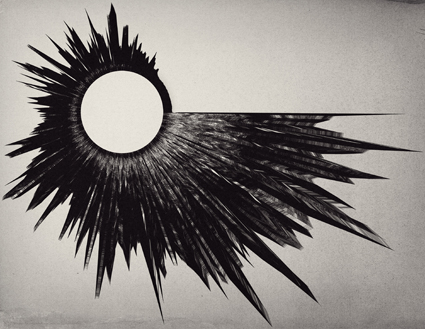
Untitled, 2010, sound generated digital still, Riley Post, ANU graduate
DARREN TOFTS ONCE DESCRIBED THE PREHISTORY OF TECHNOLOGICAL TRANSFORMATIONS OF CULTURE AS “EVERYWHERE FELT BUT NOWHERE SEEN IN THE TELEMATIC LANDSCAPE OF THE LATE 20TH CENTURY.” AS WE MOVE INTO THE SECOND DECADE OF THE 21ST CENTURY, THE AFFECTS THAT TECHNOLOGICAL TRANSFORMATIONS PRIVILEGED IN CULTURE AND ART IN THE LATE TWENTIETH CENTURY—INTERACTIVITY, INTERACTION, IMMERSION—APPEAR NOW TO US AS COMMONPLACE AND THEIR USE IN ART AND MEDIA TAKEN FOR GRANTED. IT IS EASY THEN TO FORGET JUST HOW VIBRANT THE MEDIA ARTS SCENE HAS BEEN IN AUSTRALIA SINCE THE 1980s. MEDIA ARTISTS’ ENGAGEMENT WITH THE TECHNOLOGICAL INNOVATIONS OF THAT TIME CAN, LIKE A KIND OF FORGOTTEN PREHISTORY, ALSO BE SAID NOW TO BE EVERYWHERE FELT BUT NOWHERE SEEN (WELL, RARELY).
The restructuring of the Australia Council boards in 2005, which included the replacement of the New Media Arts board with the Inter-Arts Office and the transfer of funding for a significant portion of media arts practice to the Visual Arts Board (VAB) and the Music Board, was meant to reflect the subsumption (or is it sublimation?) of media arts practices to the mainstream. According to the Media Arts Scoping Study produced in 2006, these changes did not reflect a failure by media arts to consolidate itself as a set of stand-alone practices. Rather, it was testament to the success of these artists that what was once a discrete field was now something that arts practitioners from all fields were incorporating into their practices.
Similarly, media arts as an academic discipline seems to be settling back into more established disciplines—Fine Art, Media and Communications, Design, Creative Arts and Science and Technology—no longer a monstrous hybrid struggling to find its place in the gallery or the museum. Again, whether this is indicative of subsumption or sublimation is hard to tell. Certainly, in a post-Bradley Review tertiary education environment, university managements prefer disciplines that are recognisable and established (not to mention attractive to the mainstream).
One sure outcome (for this writer at least) is that it makes the whole question of the Australianness of the media arts curriculum quite difficult to answer. Of the 10 academics that I spoke to, only two, Kathy Cleland (The University of Sydney) and Darren Tofts (Swinburne University), placed a pointed emphasis on Australian media art in their curriculum. Interestingly, both of the subjects that they teach approach media arts from a predominantly theoretical perspective and use Australian media artists as case studies. Tofts’ interest in the historical trajectory of media arts in Australia is evident in his response to the question of the importance of using Australian examples:
“In focusing on Australian artists there is an immediate context for students to ground media art practices; but more importantly it is valuable for students to be aware of the crucial contribution Australian artists have made and continue to make to the international media arts scene. For instance, cyberfeminism as an international formation, movement, arts practice and concept is impossible to think of outside the contributions made by VNS Matrix, as well as the subsequent, individual arts practices of its founding members (Francesca da Rimini, Josephine Starrs); or for that matter the crucial, pro-active curatorial/critical work and advocacy of Julianne Pierce and Virginia Barratt.”
Brogan Bunt and Lucas Ihlein (University of Wollongong) pointed out that their main engagement with local context is through regular guest lectures. “We have recently had artists like Wade Marynowsky, Deborah Kelly, Louise Curham, Lucas Abela, Mike Leggett and Lynette Wallworth give lectures to our students. We try to incorporate at least two guest lectures by local practitioners in each Media Arts studio subject each session. We also have strong commitment to contributing to local Media Arts culture. Apart from dialogue with local Wollongong artist run spaces (Project Contemporary Art Space, 5 Crown Lane, and so on), we have also been building links to relevant festivals/events/groups in the Sydney metropolitan area.”
Other practitioner academics such as Ross Harley (COFA, UNSW), Martine Corompt (RMIT), Oron Catts and Ionat Zurr (SymbioticA) and Troy Innocent (Monash University) all commented that while they would use Australian examples where appropriate and available, the necessary resources were not always available to make that possible. As Zurr noted: “…our programme focuses on art and science and furthermore, predominantly on art and the life sciences. Therefore, our teaching is focused on artists (Australian or non-Australian) who engage in working with life, living materials and biotechnology (rather than generally media art or art and technology). There is a growing number of artists within Australia who are working within this field but publication wise—the majority of books (scholarly or not) magazines, journals etc are produced overseas without emphasis on the ‘Australian’ aspects.”
The question of access to resources certainly recurred in many of the responses. The accessibility of the artworks themselves and the scarcity of critical responses to the art, as well as the lack of documentation and poor archiving of media artworks have presented challenges to academics working in the field.
Kathy Cleland noted that as a result of her experience as a curator over the last 10 years, she has a lot of documentation of Australian media art works which she uses in her course. She also pointed out, however, that there are not that many books specifically focusing on Australian new media art (Darren Tofts’ Interzone: Media Arts in Australia is one of the exceptions) and that “books published internationally don’t tend to mention many Australian artists with the exception of Stelarc who is in everything!”
Darren Tofts pointed to John Conomos’ Mutant Media which examines the convergence of media arts, film and video art as a key text. “Stephen Jones’ recent Synthetics is also an important contribution to the field, evidencing the robust longevity of Australia’s contribution to the international scene.” Both Cleland and Tofts pointed to RealTime as “invaluable” with Tofts’ noting that “the Australian media arts scene is unthinkable beyond the support and stewardship of Keith Gallasch and Virginia Baxter.” All of the respondents agreed that more online magazine/journal resources focused on media arts would be welcome.
Norie Neumark, in her role as Director of the new Centre for Creative Arts at La Trobe University argued that “it would be useful to have more and varied material and critical analysis of Australian media arts, including online resources, DVDs and CDs. However it is also vital to see Australian media artists included in broader publications, both about contemporary Australian art and about international media and contemporary art. In my own recent publication, my co-editors and I were particularly keen to include Australian media artists in a routine way in an international publication.” (Norie Neumark, Ross Gibson, and Theo van Leeuwen eds,Voice: vocal aesthetics in digital arts and media. MIT Press 2010; reviewed in RT103)
As Martine Corompt noted, the difficulty of accessing artworks continues to plague media arts: “I used to have a great collection of early interactive works, on CD and floppy disk, but of course they are all unplayable now due to changes in operating systems. Even some of my own old work also can’t be played.” The platform-specific nature of many media artworks is compounded by the difficulties they present to collections managers and archivists. This is not, of course, specific to Australian media artworks. However, more needs to be done to preserve what is left if the impact of Australian artists is to continue to influence the local curriculum. Paul Thomas (COFA and Curtin University) has been instrumental in drawing attention to this pressing issue through his involvement in the Media Arts Scoping Study (MASS) and the National Organisation of Media Arts Database (NOMAD). Similarly, the ARC funded research project, Reconsidering Australian Media Art History in an International Context, led by Ross Harley, Anna Munster, Sean Cubitt, Michele Barker, Paul Thomas, Darren Tofts and Oliver Grau aims to create a foundational online resource which will “provide future artists and curators with a cohesive overview of Australian media arts’ recent milestones and developments, crucial to making significantly innovative new work.” (See http://bit.ly/pu9f6z)
As a discrete discipline, the sound arts continue to have only a tenuous hold in academia. Their public profile, in contrast, is maintained by a robust (and youthful) underground of practitioners (see Julian Knowles, “Sound art and the extended university,” RT80). As Knowles points out, “it is clear that, despite its fragility, the contemporary sound and experimental music performance scene is significantly intertwined with the small network of university departments who embrace this area of practice and that the best students have developed into exceptional practitioners through this informal collaborative network.” It is in this context that he argues for the importance of the practitioner/teacher in universities: “Staff who work at these institutions, though now small in numbers, are often highly active as practitioners in the field with substantial profiles. They are also active as organisers of events and festivals that provide both a modest infrastructure for established and emerging practitioners and an opportunity for students to immerse themselves in the exceptionally rich and diverse sound culture in Australia.”
This probably explains why all of those whom I tried to interview for this article were unavailable. But the point is well made and supported by Norie Neumark: “The role of the Australian artist who is also an educator is crucial. In the current climate, where creative practice as research has been recognised through ERA [the Excellence in Research for Australia initiative], artist educators are particularly well placed to contribute both to the research environment and to provide direct inspiration and models to students. And working with students, from undergraduate to postgraduate, is energising and stimulating for the artist educators themselves. I see artist educators as vital in bringing theory and practice together in a vibrant way, both in their own teaching and in collaboration with others.”
Australian media arts may not be as discretely visible inside and outside the academy as they seemed to be during the 1990s but there is room for cautious optimism about its future. The new centre at La Trobe is particularly promising and the work being done to preserve a history of Australian media arts is invaluable. But vigilance is required to ensure that the sublimation of media arts practices to the mainstream does not result in their subjugation.
RealTime issue #104 Aug-Sept 2011 pg. 36
© Lisa Gye; for permission to reproduce apply to realtime@realtimearts.net
RUMOUR HAS IT THAT AVANT-GARDE CINEMA CONTINUES TO THRIVE AROUND THE WORLD, BUT LOCALLY ONE MIGHT SUPPOSE THAT THE MEDIUM WAS AS DEAD AS VAUDEVILLE. SO THE AUSTRALIAN INTERNATIONAL EXPERIMENTAL FILM FESTIVAL HAS THE APPEAL OF A CONSPIRACY AGAINST THE PRESENT—CONDUCTED, FOR THE SECOND YEAR IN A ROW, AT THE BACK DOOR WAREHOUSE IN DEEPEST PRESTON, OUT ON THE FABLED 86 TRAM LINE FAR BEYOND THE BOHO HANGOUTS OF HIGH STREET, NEAR THE DECAYING INDUSTRIAL PRECINCT WHERE PHILIP BROPHY SHOT HIS DYSTOPIAN NORTHERN VOID (2007; RT 78, P27).
Best to be honest: here in Australia—at least, for those of us who aren’t regularly able to scoot off to specialist events overseas—it is hard to get more than the faintest first-hand impression of the state of play in the experimental film arena. That’s one reason AIEFF deserves celebration, even if this year’s eclectic program felt more assembled than curated and even if 90% of the “films” were screened, in accordance with their makers’ wishes, on video.
While for the individual viewer this matters or doesn’t, from a strict artisanal perspective the two media remain as distinct as pottery and robotics: one lesson to be taken from the AIEFF program is that film, at this budgetary level, is still easily the superior format for artists concerned with what are imprecisely termed the “material” qualities of light and colour. This could be observed even in works as fragile and ephemeral as Irene Proebsting’s Super-8 Harmonic Ghosts—where faintly Gothic images brush against each other like dry, blown leaves—or as unabashedly decorative and “girly” as Jodie Mack’s 16mm Posthaste Perennial Pattern. It was good to see Tony Woods, the most persistent Super-8 filmmaker in Melbourne, return with Colour, Glass and Chrome, which, as ever, seeks out redemptive beauty in fragments of the mundane: in this case, the play of light on shards of glass found in a rubbish skip.
Film transmutes, it’s still tempting to suppose, whereas video only records. In fact, festival entries in both media showed alternate impulses to demystify and remystify the image, a dialectic also evident in the two prevailing approaches to sound design: on the one hand, the crunches and rustles of ‘raw’ or deliberately distorted sound, the aural equivalent to queasy, handheld camerawork; on the other, gloopy electronica akin to passing through a New Age carwash, intended to put you in a receptive trance.
Overlapping with this was the old battle between the representational and the abstract—between the moving image as a document and the screen as an open field where unforeseen forms can emerge. On the ‘abstract’ side were fireworks displays such as Simon Payne’s Vice Versa Et Cetera and Paul O’Donoghue’s Phasing Waves—both on video, the latter oddly culturally specific in its nostalgic deployment of clunky 1980s technology. At the other end of the spectrum, Erica Scourti’s Woman Nature Alone is a performance piece not a million miles removed from the hijinks of a ‘twee’ comedian like Josie Long, with Scourti herself enacting a half-hearted charade of communing with the environment: romping across parkland, hugging trees and eventually dropping off to sleep.
The aim might be to satirise outworn romantic postures, including a need to occupy the spotlight—but Scourti, like Long, does not escape the perils of studied cuteness. By contrast, Charles Fairbanks pointedly erases himself from Wrestling With My Father, a conceptual one-shot that really works. Fairbanks Snr is filmed head-on as he (apparently) watches his son fight it out in the ring; a burly fellow in a cap, he sits with his legs wide apart, drums his fingers during lulls, and shifts back and forth on the bench to follow every detail of the unseen action. Fairbanks’ equally successful The Men is a close-up essay on a related subject, with a mini-camera attached to a wrestler as he grapples with a bearded opponent; the fragmentary images are redolent of eroticism as much as combat.
Implicitly, such ventures put quotation marks around the notion of the personal, an unavoidable problem for artists without the alibi of commercial cynicism: how far are captured images to be understood as mirrors of consciousness, as opposed to raw material manipulated from a more-or-less ironic distance? AIEFF had its share of ‘diary’ works reliant on the idea of the camera operator as a semi-domesticated flaneur—gazing out an apartment window at dawn or wandering idly round the city, offering spiritual sympathy to beggars, watching trains go by. Taking a couple of steps back, an alternate option is to dedicate yourself to re-processing old home movies, with the passage of time as part of the point, as Mike Leggett does in his beautiful Bosun’s Chair. Or you can simply borrow from the communal archive: the ultimate example of this tactic, Bob Cotton’s ZeitEYE flashes across the history of modern graphics from Futurism to the Wii, with fleeting captions suggesting a media arts version of “We Didn’t Start the Fire.”
Speaking to many of these issues, Steven Ball’s Personal Electronics is a study in paranoia composed of deranged clips lifted from video-sharing sites: the sources are mainly American, though the wry bemusement implied by these juxtapositions is British to the core. A figure slumped on a couch twitches violently, like an extra from Paranormal Activity (2008); a woman lectures us in voiceover on the esoteric import of a purple shaft of light which seems to emanate from a parked car. Acknowledging that some will perceive this “directed energy weapons ray” as visual noise, she instantly rejects the possibility: “These are very clearly lasers…Lens flares are not so concentrated, for one thing, they’re more diffuse.” In context, it’s a parody of hermeneutics: the artist striving to impose significance on ‘found’ material, the viewer labouring to decode that intention from the other side. Madness awaits us all, as we struggle to make meaning from what we see.
2011 Australian International Experimental Film Festival, The BAck doOR, Melbourne, April 29-May 1
RealTime issue #104 Aug-Sept 2011 pg. 35
© Jake Wilson; for permission to reproduce apply to realtime@realtimearts.net
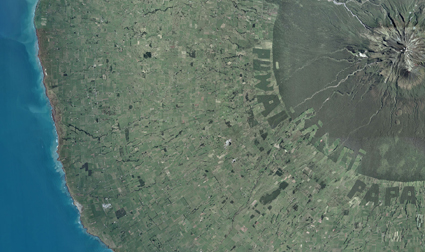
Starrs & Cmielewski, Incompatible Elements at Moving Image Centre, MIC Toi Rerehiko, Auckland
AS GOVERNMENTS RELUCTANTLY ADMIT TO THE EXISTENCE OF A CLIMATE CRISIS BUT DO LITTLE ABOUT IT, MANY MEDIA ARTISTS ARE RESPONDING TO THE EVIDENCE OF THE ECOLOGICAL DISASTER THAT IS CLEARLY ALREADY HAPPENING. JOSEPHINE STARRS AND LEON CMIELEWSKI’S PROJECT INCOMPATIBLE ELEMENTS (2010-2011) PRESENTS THE INTENSE VISUALITY OF REGIONS OF THE ASIA-PACIFIC THAT HAVE BEEN HIT BY EXTREME WEATHER. WHILE HUMAN ACTIVITY IS ABSENT IN THE DIGITAL SATELLITE-SCAPES, THE HUMAN MIGRATION FORCED BY WEATHER EVENTS IS IMPLIED IN THE POETRY, LYRICS AND ORATORY THAT INSCRIBE THE VIDEO WORKS.
The work’s fusion of text and topographical landscape presents a challenge to the separated or incompatible categories of ‘nature,’ ‘environment’ and ‘culture.’ Incompatible Elements was first exhibited at Performance Space in Sydney in 2010 followed by MIC Toi Rerehiko in Auckland in March 2011.
An ‘incompatible element’ is a term in geochemisty used to describe mineral properties in rare earth and in the oil industry. ‘The elements’ also refers to weather forces producing effects that are becoming more and more incompatible with human life. Starrs and Cmielewski tell stories on behalf of future “climate refugees” as part of their ongoing concern with migration stories. They used data maps in earlier work such as the interactive screen-based work Seeker (2008) to reveal the politics of forced migration due to conflict over resources such as diamonds, titanium and oil. Incompatible Elements also recognises the largely unquantified human migration resulting from climate change—of people often seen as incompatible with national immigration policies. As philosopher Bruno Latour urges, the artists recognise that ecological issues include the social, political and cultural as opposed to perpetuating the Modernist ‘human/nature’ divide.
The four video landscapes presented at MIC are composited satellite images of the flooded planes of the Ganges, the former dust bowl of Australia’s Murray-Darling basin, the dry banks of the Coorong in South Australia and the erosion of Mount Taranaki in New Zealand. Accompanying light boxes provide the micrographic complement to the remote satellite pictures as detailed photographs of the dry earth. The artists present the polar extremes of drought and deluge: the predicted and increasingly manifesting extremes of weather-induced disaster in regions of Australasia. By encouraging us to examine their finely stitched topographical images closely in the defamiliarised context, even the normally detached gaze of the Google-Earth browser is politicised.
In Incompatible Elements, the leisurely paced pan of the fly-over satellite map is incrementally modified by lines of text that grow out of features of the landscape itself. After a while, streams or fields become words that slowly creep into the frame, inviting comparison to the relentless anthropogenic expansion across the Earth. The sources of the animated words include the environmentalist poetry of Australian Judith Wright, her line “And the River was Dust” curls out of the Murray-Darling basin’s tributary streams while the lyric “days like these” from the John Lennon song “Nobody told me” emerges from the watery arteries of the Ganges. A phrase in the Ngarringjerri language, “A Living Body,” creeps out of the dusty banks of the Coorong and “Puwai Rangi-Papa,” the words of a Maori elder encircle Mount Taranaki.
Starrs and Cmielewski direct attention to Maori and Aboriginal people and the fate of migrants through their use of their language. The perspective of the satellite drifting through space is often described as an omniscient view of a detached observer, but this perspective is also a familiar way of charting territory in traditional aboriginal cultures. Theorist Lisa Parks notes that Aboriginal people have incorporated “satellite dreaming” into their symbolic narratives of cultural identity in artwork and in independent television programming. Both indigenous citizens and migrants occupy a border zone where they are particularly vulnerable to extreme weather events. Maori are traditionally ‘people of the land’, often living in coastal regions, while migrants living in temporary structures are prone to weather-borne disaster.
For the MIC version of Incompatible Elements Starrs and Cmielewski added a video element to the suite of works called Puwai Rangi-Papa. This phrase was translated for the artists as “waters of the radiant sun and earth mother” by Taranaki kaumatua (elder) Dr Te Huirangi e Waikerepuru. Te Huirangi introduced this term to the artists on their SCANZ digital art residency that began at the Owae marae (meeting house) on the West coast of New Zealand in January 2011. Taranaki locals themselves suggested to the artists that they make a work around the erosion of the dramatic peak of Mount Taranaki. The ‘Fuji’ shaped mountain dominates the geography and weather system of New Zealand’s North Island. Rock fall and erosion have increased since violent storms have intensified on the west coast to the extent that local inhabitants are now threatened with the loss of their homes. Analysing aerial photographs of water and soil shifts on Taranaki and its waterways, scientists estimate that more than 14 million cubic metres of the mountain have collapsed since the late 1990s. Huge rock falls and debris have caused blockages in waterways, along with floods that send more boulders down the river, widening the banks. The soundtrack of Puwai Rangi-Papa includes the tumbling of stones that keeps residents who live on the edge of Taranaki awake at night. In Maori terms the ‘mauri’ (life-force) of the mountain is being eroded by the changing climate along with its iconic physical form.
The video images for Puwai Rangi-Papa are created from four Land Information New Zealand satellite images that are seamlessly brought together. The viewing position tracks around the uncannily perfect circle of the satellite map of the mountain and after several minutes the words “Puwai Rangi-Papa” emerge from the fields around Taranaki’s perimeter. According to the artists, this is nature and culture “collapsing into each other.” Using the ubiquitous format of Google Earth and GPS applications on iPhones and cars that has changed our relationship to maps in only a few years, Starrs and Cmielewski are trying to slow down the way we view this satellite imagery to give pause for reflection on the implications of a landscape transfigured by weather.
Many pakeha (white) artists in Aotearoa-New Zealand avoid the use of Maori concepts as the conceptual underpinnings of their work because of the sensitivity around the appropriateness for citizens who are not tangata whenua (people of the land). However when permission is granted by an elder of the region for a story to be told and te reo (Maori language) to be used, the artists are provided with a place from which to transmit important messages across cultures. If settler cultures can shift from conceiving landscape or weatherscape as inert matter ‘to-be-looked-at’ to living bodies encompassed in Maori terms such as ‘mauri’ then we come closer to ecological reconciliation. Puwai Rangi-Papa could signal an important shift in articulating a reconfigured political ecology where Western environmentalism and indigenous cosmologies might join in restoration and care of the land.
An artwork like Incompatible Elements is not propaganda or politics, yet the artists are unwilling to leave socio-political questions to designated experts. The cumulative effect of Incompatible Elements is not alarmist, rather human responsibility is implicated in the large-scale geo-physical changes to our world that the artists represent. The work encourages reflection on the impact of cumulative weather events that are difficult to conceptualise as statistical data or scientific warnings.
Incompatible Elements, MIC I Toi Rerehiko, Auckland, New Zealand, March 4-25
Australian media arts watchers will be interested to know that “MIC Toi Rerehiko promotes a dynamic and growing culture of interdisciplinary media-arts practice in Auckland and New Zealand, supporting an environment of innovation, in which fusion of art and technology is developed and nurtured. Based in the heart of Auckland, MIC Toi Rerehiko has a new art gallery on Karangahape Road, and a live performance/screening venue at Galatos. We exhibit a continuous program of international and New Zealand artists working across contemporary film, video, digital media, installation, music and live performance.” www.mic.org.nz. Eds.
RealTime issue #104 Aug-Sept 2011 pg. 39
© Janine Randerson; for permission to reproduce apply to realtime@realtimearts.net
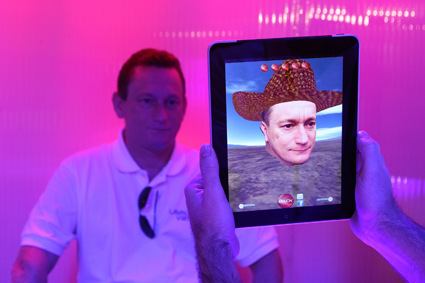
DigitEYEzer, Laval Virtual 2011
photo Jean-Charles
DigitEYEzer, Laval Virtual 2011
THE LAVAL VIRTUAL INTERNATIONAL CONFERENCE AND EXHIBITION ON VIRTUAL REALITY AND CONVERGING TECHNOLOGIES IN FRANCE, IS ONE OF EUROPE’S LARGEST GATHERINGS OF VIRTUAL REALITY AND NEW TECHNOLOGY ENTHUSIASTS. THIS YEAR, OF THE 85 EXHIBITS PRESENTED AROUND 30% WERE FROM PLACES OTHER THAN FRANCE, INCLUDING AFRICA, JAPAN AND NORTH AND SOUTH AMERICA. THIS GLOBAL SPREAD DELIVERED AN ECLECTIC MIX OF INTERNATIONAL AND TRANSNATIONAL EXHIBITS.
I had never been to such an extensive industry convention before, especially one with a dedicated stream on virtual art. Not knowing what to expect, I armed myself with a detailed presentation, designed for those who could not speak English (lots of big images) and one that contextualised the Australian media art scene in more detail than I would present at home.
It was with great surprise then I discovered that all conference delegates had to present and were mostly conversant in English (also my second language) and that Australia’s contribution to media arts internationally was well known and understood by many present at the event.
Setting the context for the conference was renowned media arts theorist Erkki Huhtamo, Professor of Media History and Theory at UCLA. In his keynote titled “Hand Screens, Wrist Watches and iPads: an Archaeology of Wearable Media,” Huthamo asked the numerous artists, technologists and engineers at the conference to reflect for a moment on the history of mobile and immersive media.
This reflection illuminated a fascinating history of wearable and portable media devices, with objects such as pocket watches, cameras and hand-held personal fans seen as precursors to modern day hand-helds. In particular, fans were not only used for cooling, but also as symbols of social status and as print mediums for portable artwork and maps.
With evolving genres such as Device Art (think Bitman by Ryota Kuwakubo and Maywa Denki, 1998), this convergence of technology, art and design can be seen as an extension of those historical origins of portable media. By understanding the origins and symbolic meanings of these devices, Huhtamo suggested, contemporary artists and technologists are in a much better position to tap into their cultural legacy, and therefore be more successful in deploying them artistically and commercially.
Commercialisation was certainly the main driver for most exhibitors at Laval. The three projects I look at in this article—IFace 3D, Haption Exoskeleton and Invoked Computing—were all commercial with no particular focus on media arts, but like many of the exhibitors at Laval, were keen to harness the creative energy of users, including artists, for their inventions.
iface 3D— digitizer (france)
DigitEYEzer exhibited their recently released smartphone application iFace 3D, the first 3D face scanner available for mobile phones. With iFace 3D, users create 3D, lifelike models of themselves or their friends or anything close at hand, by shooting moving images on their phones and sending them to a 3D reconstruction server online. After a few minutes the user is then sent back the 3D model, ready for printing or publishing on the net. These 3D representations can be downloaded into virtual games or sculpted into physical 3D models with 3D printers. Staff at the booth displayed an arresting 3D generated, colour sculpture of their Sales and Marketing Manager, Didier Sy-Cholet, something that’s possible for all users to do once they have their own scanned data (and access to a 3D printer).
The interest in photo-realistic self-representation in virtual games and social media is certainly there, so it will be interesting to see how artistic engagement with this application evolves. I wonder for instance, how Australian augmented reality projects such as Warren Armstrong’s (Un)seen Sculptures (2011) or Thea Bauman’s Digital Culture Fund project Metaverse Makeovers (2011) might engage audiences with these new tools in times to come.
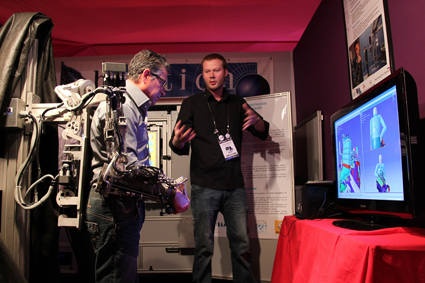
Haption, Exoskeleton Demonstration Booth, Laval Virtual 2011
photo Jean-Charles
Haption, Exoskeleton Demonstration Booth, Laval Virtual 2011
haption exoskeleton (france)
Haption’s force-feedback exoskeleton was one of the more intriguing exhibits to play with at Laval. Established in 2001, the company develops high performance haptic [touch-based] instruments and programs involving force-feedback in virtual reality, for both industrial and academic purposes.
Stepping into the exoskeleton at the booth, I felt a bit like Ellen Ripley from Aliens (without the sweat and the attitude), but instead of killing an acid-spitting critter, I had to put a virtual peg in a virtual hole.
The feedback system in the exoskeleton was fantastic, as it provided force-feedback on all six degrees of freedom (translations and rotations), which is essential for a realistic interaction with 3D objects. I was so mesmerised by the actual physical feedback that I never got the peg near the hole.
In terms of haptic feedback systems and Australian arts practice, I could imagine artists such as Keith Armstrong (Intimate Transactions, 2008), Jonathan Duckworth (Embracelet, 2007), Margie Medlin (Personal Space, 2007) or Stelarc (Exoskeleton, 1998) having great fun exploring the force-feedback systems linked to virtual space.
A recent haptic focused ARC Linkage grant supported by the Australia Council, bringing together artist Paul Brown, Dr Ben Horan from Deakin University’s School of Engineering and Saeid Nahavandi, Director of Deakin’s Centre for Intelligent Systems Research, could also be situated in this context. The three-year grant aims to help visually challenged people ‘see’ artworks through haptic vibrations; force-feedback systems such as these could add a dynamic new dimension to future projects.
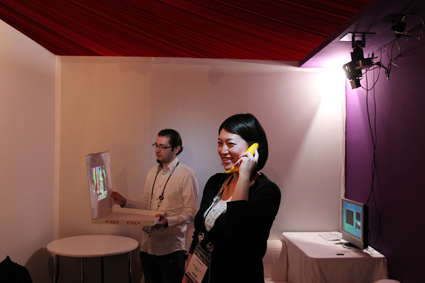
nvoked Computing, Laval Virtual 2011
photo Jean-Charles
nvoked Computing, Laval Virtual 2011
invoked computing (japan)
One of the most innovative and, to my mind, potentially game-changing projects to emerge at Laval this year was Invoked Computing. Developed by Alexis Zerroug (France/Japan), Alvaro Cassinelli (Uruguay/France/Japan) and Masatoshi Ishikawa (Japan) through the Ishikawa Komuro Laboratory at the University of Tokyo, the project explores a “ubiquitous intelligence” capable of recognising specific human actions and projecting sound and images onto objects linked to these actions.
The example shown at Laval involved taking a banana and bringing it closer to the ear, with the gesture triggering directional microphones and parametric speakers hidden in the room. These devices then made the banana function like a phone. Not only would the banana ring, but you could talk using the banana as a handset. The developers also used a pizza box with projected images that could follow the box around in space.
The potential for these tools in performance and installation based work is mindboggling. Imagine having any object in a space able to project sound or images and interact with those around it. What could PVI Collective (Transumer, 2010) do with this technology if they deployed it in public spaces? Or Back To Back Theatre (Small Metal Objects, 2005) with accidental audiences at train stations?
Not surprisingly Invoked Computing received the Grand Prix du Jury for Laval 2011.
australian developments
In Australia there is huge scope for artists working in virtual reality and converging technologies to continue their internationally recognised practice. Recently, with funding through the Digital Culture Fund, some fantastic live, digital projects were realised with work such as the Roller Derby extravaganza Bloodbath by Bump Projects (2010; RT100) and Adriaan Stellingwerff’s Windy and Winding (2010), a virtual balloon travel application for smartphones.
In September this year at ISEA in Istanbul, the Australian Centre for Virtual Arts is curating a major program of Australian virtual artists, titled Terra Virtualis. In addition, an Australian exhibition on robotics curated by Kathy Cleland and an exhibition titled The World is everything that is the case, curated by Sean Cubitt, Vince Dziekan and Paul Thomas will also be flying the flag.
But the most significant development for experimental art in Australian in 2011 is the recently announced Creative Australia fund, a $10 million initiative from the Federal Government.
This funding is targeted to support individual artists through the creation and presentation of significant new work and fellowships and will be rolled out by the Australia Council over the next five years.
All the Council’s artform boards will be delivering on this initiative, with the knowledge that digital culture and the potential of the national broadband network will no doubt be key considerations of many applications. We are all looking forward to seeing the outcomes of such a significant investment in contemporary Australian arts practice.
RealTime issue #104 Aug-Sept 2011 pg. 41
© Ricardo Peach; for permission to reproduce apply to realtime@realtimearts.net
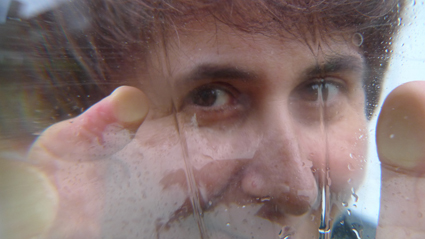
Suzon Fuks
photo Liz Scrimgeour
Suzon Fuks
SUZON FUKS IS A BRISBANE-BASED MEDIA ARTIST, CHOREOGRAPHER AND DIRECTOR WHO EXPLORES THE INTEGRATION AND INTERACTION OF DANCE AND MOVING IMAGE THROUGH PERFORMANCE, SCREEN, INSTALLATION AND ONLINE WORK. SHE IS CURRENTLY AN AUSTRALIA COUNCIL FOR THE ARTS FELLOWSHIP RECIPIENT. FUKS DESCRIBES HER NEW WORK, WATERWHEEL, AS “AN ONLINE SPACE WHERE YOU CAN INTERACT, SHARE, PERFORM AND DEBATE ABOUT WATER AS A TOPIC AND METAPHOR, WITH PEOPLE AROUND THE WORLD OR RIGHT NEXT DOOR! IT IS COST-FREE, ACCESSIBLE WITH JUST A CLICK, AND OPEN TO EVERYONE OF ALL AGES. IT FOSTERS CREATIVITY, COLLABORATION AND INTER-CULTURAL-GENERATIONAL EXCHANGE.” I ASKED FUKS ABOUT HER MOTIVATION AND AMBITIONS FOR THE WORK.
What is it about water that drove you to create Waterwheel?
I come from a country in Europe where it rains a lot and I wasn’t aware of water scarcity at all. Living in India for three years changed my perception about access to water. I had to wake up on time to fill my vessels from a tap in the street that ran only twice a day for half an hour. I had to boil it and keep it in a specific place in the house. So I built my life and time around this access to water.
When I moved to Brisbane it was a beautiful ‘garden city.’ During the drought of 2005 I worked most of the year overseas and coming back, I could see from the plane window everything was brown. Sad! It looked like a dying body. At that time I went for a walk at Wivenhoe Dam. A very striking image remains in my mind. A dried out fish caught in a small bush on the edge of the reservoir. The water level had gone down so much that the fish had been caught there, died and dried out.
I became more interested in the politics of water. I started questioning how in developed countries we have access to things and information and take so much for granted. Water is becoming a commodity. I observed that most water infrastructures are made by men, but in developing countries the collection and handling of water is usually a matter for women.
In 2008 I helped organise a networked performance with five cities around the world. We were talking about the drought in Brisbane and a group of artists in Curitiba were saying that in Brazil governments are fighting over the Guarani, one of the world’s biggest and most abundant aquifers, to own part of it for the future. It was interesting for me to see that, through the internet, people can share different perspectives on water.I’d like to share this growing awareness, and find ways to deal with water issues.
In what ways do you see water as a tangible element of your art?
Artistically, I’m interested in the contrasts and extremes of water: transparency, opacity, stillness, turbulence, the violence of water and its patterns. To me, the patterns in water hold secrets. Things are entangled there: the fluidity, stripes and rhythms make links between graphic, choreographic, musical and cinematic forms. If we could decode the patterns, we could find a writing somehow and an understanding between these disciplines.
I’m constantly collecting water samples in video and audio. With Igneous I have done two shows with actual water: Liquid Skin and Mirage (both in 2006). And before that, in 2004, Thanatonauts and Body In Question, used water in their video-scenography. I know that artists have been using water for a long time and the interest is increasing. It seems to me like a requiem for water. Before it dies.
In my memory, public water had a different presence in cities than it does now. Fountains were places of social gathering and where to get fresh water when walking from place to place. Now they are being covered. All that is left are signs saying: there once was a spring. So I thought it would be interesting to have a repository, not only of artistic works but about water in general, in order to keep a trace of our stories, cosmogonies and lifestyles, because water, cultures and cities are changing.
Did Queensland’s recent flooding influence the work?
The flood felt like a state of war. There was nothing that could be done to stop it, and it was violent. Water is not always transparent, reflecting the blue sky, but can be really dirty, smelly and sticky. The mainstream media were really making people scared, repeatedly showing the most dramatic images and playing the most dramatic commentary. Meanwhile, on social media people were infiltrating like water, in a constructive way, giving helpful tips. The water issue made discussions deeper.
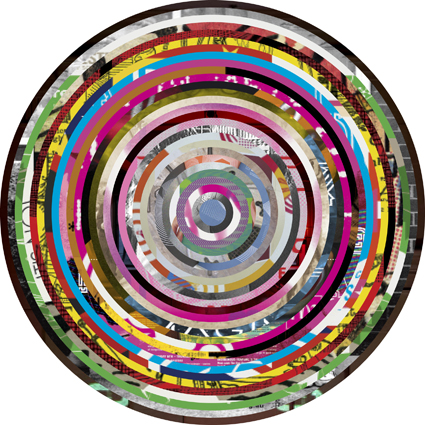
Waterwheel interface
Are you a ‘water person’?
Definitely. I’m not an excellent swimmer, but I go swimming every day if I can. It’s my way of keeping fit. I find baths and water spaces relaxing and rejuvenating. When visiting a new country, I’m interested to know about water rituals and customs, and which places they have for them. It’s a way for me to better understand the place and meet people.
What can we expect when we enter the Waterwheel site?
The main thing on the Waterwheel homepage is a wheel made up of concentric rings that represents the latest 40 uploads. Anyone can log-in and upload, access and comment on that media, and message other users. From there they can go to the “Fountains” map and the “Tap.”
Users, individually or with a “Crew,” can use the Tap for a performance or presentation with webcams, media from Waterwheel, drawing tools and text chat, all on one web page. What’s very new is that any media item placed on the Tap can be moved, resized, flipped and layered over other media. Audience can engage with each other and the Crew by simply clicking on a link without having to install anything. Years of research in networked performance allowed me to see the pros and cons of, and determine the best tools, from those I found in various online platforms I used.
There are many levels on which to engage with the site and the project. Whether you’re initiating a project individually or collaborating with others or contributing to an existing one or simply spectating. A curator could get in contact with an artist, or scientists and activists in contact with their colleagues. It’s a new mode for expression, exhibition or festival.
Who are you working with on Waterwheel?
In the first year of my Australia Council fellowship I presented the Waterwheel concept in various circumstances, conferences and in sharing sessions with peers and colleagues onsite and online. I got lots of feedback, which helped to evolve the concept and I received grants from Arts Queensland and Brisbane City Council to extend the project and the team.
Waterwheel is a really collaborative project. My main partner in building up the site is Inkahoots, a Brisbane-based studio of graphic designers, programmers and a copywriter. Artists around the world are helping with the testing of the Tap. In terms of getting feedback in order to advance the project, I asked a forum of peers to come at certain times to give oral as well as written responses.
My co-artistic director of Igneous, James Cunningham, is an external eye for the experimentation on the Tap and its integration into an on-site installation performance that will happen during residencies in October and December at the Judith Wright Centre. For that event there is an entire team: dramaturg (Doug Leonard), performer (Sofia Woods), set designer (Rozina Suliman), interactive system designer (Nathen Street), production manager/lighting designer (Felicity Organ-Moore), IT technician (Will Davis), PR person and someone taking on a new role linking ‘crew’ members online and onsite.
I’ve been networking for a long time and via the internet with fellow performers in Canada, USA, Brazil, Europe, Lebanon, Indonesia, India, New Zealand and South America. For the launch of Waterwheel on August 22, I hope that this network will present a short program of performances and presentations.
You have written that water will also be metaphorical in the work: In what way?
I tried to make the whole Waterwheel project using water vocabulary because of the theme and the parallel between this vocabulary and the Internet. The words waterwheel, fountain, tap, crew, dock also give an idea to people, to the audience, of how to use the site. Users can also take a metaphorical interpretation of water for the content of the media they upload—like a dance inspired by water’s qualities or a video of sand rippling down dunes like liquid.
Above all what do you hope to achieve with Waterwheel?
I hope to raise awareness about water issues and works, that people will generate new avenues, new works and new ways of presenting and performing, finding their own style within the venue and the tools that Waterwheel offers. I’d like the project to foster sharing and creativity, cross-cultural conversation, intergenerational exchange and debate and help people who have controversial projects, ideas, or are in conflict, to make issues more public and facilitate decision-making and practical action.
How do you feel about living so intensively with a work about water?
Every day I see the relation and relevance with the work and what is happening in the world. Like the transformative aspect of water I am trying to be open and flexible and adjusting to what is happening. It’s intense because it has lots of different aspects, it’s beautiful and sometimes it’s really terrible. The tsunami in Japan and the aftermath of the Fukushima nuclear meltdown has affected my way of apprehending the world. Knowing that we are not reaching the tipping-point but are totally in it is terrifying, but at the same time, interesting to see how we can react to that in a human and positive way.
Waterwheel: http://water-wheel.net/, launching August 22. Deadline for proposals for launch August 12
RealTime issue #104 Aug-Sept 2011 pg. 42
© Keith Gallasch; for permission to reproduce apply to realtime@realtimearts.net
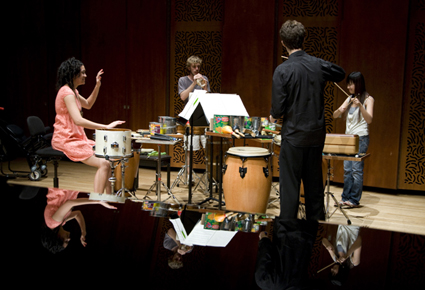
Percussion students, Queensland Conservatorium Griffith University
SENIOR LECTURER AT THE UNIVERSITY OF MELBOURNE LINDA KOUVARAS REMEMBERS “A RATHER LEAN COUPLE OF DECADES” WHERE BOOKS ON CONTEMPORARY MUSIC IN AUSTRALIA WERE THIN ON THE GROUND. A RESURGENCE OF INTEREST HAS RECENTLY GRACED LIBRARY SHELVES WITH BOOKS BY DAVID BENNETT (SOUNDING POSTMODERNISM, AUSTRALIAN MUSIC CENTRE, 2008), GORDON KERRY (NEW CLASSICAL MUSIC, UNSW, 2009), GAIL PRIEST (EXPERIMENTAL MUSIC, UNSW PRESS, 2009) AND SALLY MACARTHUR (TOWARDS A TWENTY-FIRST-CENTURY FEMINIST POLITICS OF MUSIC, ASHGATE, 2010), WITH WORKS BY OTHER AUTHORS PROJECTED FOR THE NEAR FUTURE.
Though many of those interviewed for this RealTime arts education edition identified a now healthier music book publishing industry, the same was not said of critical writing in journals, magazines and newspapers. The perceived critical vacuum in Australian musical life is seen to negatively impact on the teaching of Australian music in tertiary courses, the vibrancy of Australian musical cultures and students’ preparedness for their careers.
a critical deficit
Executive Director of Performing Arts at Monash University Peter Tregear explains how critical writing feeds into teaching: “As a teacher you don’t just want to show that music exists, you want to show how it exists in context. You want to show students a score, a recording and responses to the music.”
It is not just in the classroom that this scarcity of music writing is felt, but in the lives of practising musicians and sound artists. “Art-making thrives on verbal reflection and magazines/journals provide an essential forum for this,” Kouvaras asserts. Griffith University Lecturer Vanessa Tomlinson believes the value of critical reflection extends from local scenes to the wider musical world, warning of global negligence in the state of Australian music writing.
Forums do exist for critical writing on music in Australia, though a plurality of voices is needed as part of a reflective musical culture. Senior Lecturer at the University of Adelaide Stephen Whittington regards RealTime as “the only forum for serious critical discussion of contemporary music in Australia,” while Tomlinson regards it as “one of only a few places where people can actually critically engage with an artform.” With a focus on jazz and improvised music, Extempore initially appeared in five print editions providing reviews and feature articles. Material is still published online (www.extempore.com.au), but its print presence will be an annual print anthology from 2012, according to its website. The Music Council of Australia’s quarterly magazine Music Forum publishes album reviews and longer pieces, particularly about music education (www.musicforum.org.au). The Australian Music Centre publishes news, articles and reviews in its online magazine Resonate (www.australianmusiccentre.com.au/resonate) and its bi-annual Resonate Journal. Despite the efforts of these platforms, much of the responsibility for publishing concert reviews still falls on newspapers, something that, according to Tomlinson, they “are not doing in any way, shape or form.”
Newspapers publish both reviews and features on music, though they are rarely sufficiently in-depth to include in a tertiary reader. A comprehensive review would follow a piece through a performance, the musical life of a country and the history of Western art music, with an ear to its otherness within these very categories. This is a tall order, but it is also a formula Tregear reads behind the success of The New Yorker’s Alex Ross. “You can see how his articles easily spin out into books. Can you imagine a book of Clive O’Connell’s reviews [for The Age]?” he quips, before qualifying: “Now reviewers will say that the papers don’t give them the space to publish more in-depth reviews, and this is true, but it is a vicious circle. The paper thinks music is marginal and irrelevant and [reviewers] write as though it is marginal and irrelevant.”
Public disinterest in art music also forms part of this circle. Whittington, who writes for Adelaide’s The Advertiser, notes that “even when you do write something controversial, as I do from time to time, it is difficult to elicit a response [from readers].”
While the length of columns on the internet is not an issue, the lack of financial incentive and the disparate nature of the blogosphere may explain why this medium is yet to reinvigorate public musical opinion. Tomlinson points out the vast incongruity between the rhetoric of the information age and the dearth of public reflection about music in Australia, a phenomenon that may be explained by Whittington’s remark that cultural flows over the internet tend to be circular. We then have to look to the leadership of publishers, broadcasters, concert organisers and educators to break the cultural deadlock. Amongst concert organisers and broadcasters there have been some promising signs: ABC Classic FM’s continuing commitment to contemporary Australian classical composers and concerts, the East Coast’s growing New Music Network and Perth’s Tura Music, building audiences and helping with the challenges of touring. Educators also acknowledge a commitment to broadening students’ worldviews, striking various balances between local and global content.
ensuring a global perspective
Andy Arthurs, Professor at Queensland University of Technology, agrees that tertiary courses should broaden students’ cultural frames of reference “so you are not following your own little bread crumb route to wherever you want to go next.” Coupled with the melting pot of a campus environment, online media enhances students’ understanding of their global context, of which Australian music forms only a part. “Sometimes the most interesting things happening in the world will be happening in Australia,” Whittington claims. “Sometimes they will be in Shanghai or Sao Paolo.” Likewise, Arthurs finds the distinction between the local and the global to be of little relevance to the contemporary working musician: “I had a conversation a few years ago with some colleagues in Malmö in Sweden and it became apparent that they didn’t really talk about Swedish music. They said ‘we just make music and hope that the rest of the world likes it.’ A little less introspection would probably be a good thing.”
providing local context
Though a global perspective is essential for any aspiring musician, contemporary Australian composers are held up as role models for having locally negotiated similar professional and cultural terrain. Arthurs will teach about relatively younger composers such as Robert Davidson and Matthew Hindson. Tregear believes Elena Kats-Chernin “relates to contemporary culture in a way that hard-edged Australian versions of Darmstadt stuff from the 1960s and 70s didn’t then and certainly don’t now.” Likewise, Whittington will “only very occasionally refer to the older generation, Richard Meale or Peter Sculthorpe,” instead teaching about “composers of [the students’] own generation—like Damien Ricketson and Matthew Shlomowitz.” [Ricketson is currently a lecturer in composition at the Sydney Conservatorium of Music and directs Ensemble Offspring whose recent concert, featuring a piece by Matthew Shlomowitz, is reviewed here, Eds.]
The Australian Music Centre is generally accepted to be an indispensable resource for accessing the music of past and present Australian composers. Tomlinson, a former professional associate of the AMC, understands that “whenever there is an agreed upon dearth of information [the AMC] is generally proactive in producing resources.” With an increasing amount of material available online through the AMC (www.australianmusiccentre.com.au) and the Australian Sound Design Project (www.sounddesign.unimelb.edu.au), and over 17 years of critical material available through the RealTime archive since 1994 (accessible online 2001-present), there has never been a better time to bring contemporary Australian music into lecture halls. Often the resource is standing right in front of the students in the form of the lecturer. All interviewees advocated teachers bringing their creative practice into the classroom, including their passion as scholars and critics.
no practising in the lecture hall
The common requirement for teachers at universities to have PhDs can deprive students of the valuable experience of being taught by a practising musician, argues Arthurs. He claims that if he wrote down 50 of the most interesting musicians in Australia, few of them would be in universities. Snug inside the academy, a professional environment hostile to expensive one-on-one music tuition and proselytising teachers does not promise an edifying educational experience.
To Alistair Noble, Associate Dean in the College of Arts and Social Sciences at the Australian National University, a university culture that devalues pedagogical traditions, including the relationship between instrumental or composition teachers and students regardless of professional qualifications, threatens the quality of both musical and general arts education. “One of the major influences on my thinking was not even in the music department,” Noble reminisces from his armchair, “but was a medieval studies lecturer. It was in those medieval studies classes that I saw first hand what a political engagement could mean in terms of academic study. I remember in that class having guest lecturers from Oxford or Cambridge or somewhere, these die-hard Marxists talking about Byzantine farming methods. There is definitely an attitude now that the idea of passing on a tradition is inappropriate. It does happen, but one isn’t very vocal about it.” Whether helped or hindered by an institution, students will seek out collaborators, mentors and role models wherever they can find them, resulting in ephemeral live music scenes.
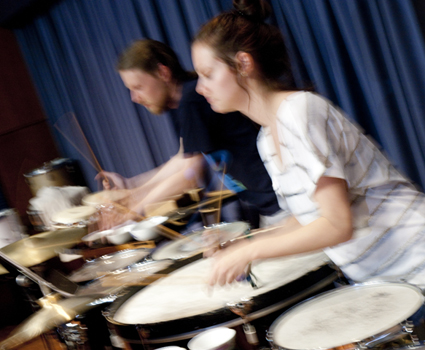
Percussion students, Queensland Conservatorium Griffith University
from the local to the global
Outside the lecture hall, or contiguous with it if institutions are functioning properly, students find their musical identity through a complex interplay of local and global influences. In Brisbane, Vanessa Tomlinson finds that “students are most influenced by what they see in the city around them. At the moment that would mean Joel Stern, Lawrence English, Topology, my own work with Clocked Out, and the Viney-Grinberg duo. They are most interested in what they hear live.”
Just as they engage with their immediate surroundings, students will consider themselves in relation to global musical trends. Tomlinson also identifies “probably about three groups of young composers who are working really hard to establish their musical identities in Brisbane and contextualise that within a historical framework—be it European Modernism or contemporary New York minimalism.” Arthurs reinforces this interplay between the local and the global: “musicians in Brisbane, generally, do not interact much with musicians from Sydney or Melbourne. They do need to contextualise their practice, but they do that in relation to music from New York or Hamburg just as well as they could with Perth or Melbourne.”
writing yourself into a music career
In professionally navigating local and global boundaries, critical literacy is again vital. Vanessa Tomlinson explains that “because we have this fairly strong funding system, compared to the US and Asia, but not Europe, a lot of the responsibility for getting music out there falls on the musicians themselves. You have to publicise your gig, get it online, you virtually have to do your own critical writing. This is one of the big responsibilities of education, to train up critical thinkers so that we can have more independent, freelance writing…It is easy to slip into an educational system that is purely skill-based, that makes performers and sends them out into the world. The world is not there to receive them. So critical thinking is not just about reading obscure philosophical texts, it is also about understanding how to engage with the world. The question is ‘how does and can art function in the world in relation to other art forms, philosophy or ecology?’”
With books and online resources on Australian music growing in number, the paucity of music criticism currently stands out as one of the greatest hindrances to the inclusion of Australian works in music education. Critical writing provides vital teaching material, forming a bridge between the ‘outside’ world and the academy. It is the glue of otherwise disparate and alienated music scenes. It should be part of the professional toolbox of every musician, ready to deconstruct their detractors and justify their own glorious existence.
RealTime issue #104 Aug-Sept 2011 pg. 43
© Matthew Lorenzon; for permission to reproduce apply to realtime@realtimearts.net
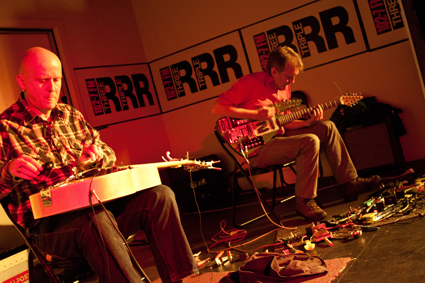
Dave Brown and Lukas Simonis, Liquid Architecture
photo Sebastian Avila
Dave Brown and Lukas Simonis, Liquid Architecture
THE SMALL 3RRR PERFORMANCE SPACE IS AT ONCE A BROADCASTING STUDIO, A CONCERT HALL AND AN INSTALLATION SITE. EACH FUNCTION ENTRAINS A DIFFERENT SET OF CONVENTIONS AFFECTING THE WAY AUDIENCES APPROACH THE MUSIC AND SOUND ART PRESENTED THERE. THROUGH DAVID CHESWORTH’S OCEANOGRAPHY/PERON STATION INSTALLATION AND THE LIQUID ARCHITECTURE CLOSING CONCERT, EACH OF THESE SETS OF CONVENTIONS WERE CHALLENGED BY A PROGRAM THAT ASKED “WHO’S AFRAID OF LAUGHING?,” “WHO’S AFRAID OF THE DARK?” AND, FINALLY, “WHO’S AFRAID OF LISTENING?”
For the Oceanography/Peron Station installation, Chesworth moved away from the large-scale site-specific installations of his and Sonia Lieber’s Wax Sound Media to produce an intimate listening environment in the 3RRR performance space. The dim room invited the audience to apprehend the eight-channel works acousmatically, or on their sonic merit. The striking juxtaposition of synthesised and field-recorded sonic environment provided the listener with a fresh auditory perspective on both sound sets while provoking their curiosity about the works’ extra-musical associations.
Oceanography is an almost completely synthesised soundscape that Chesworth describes as suggesting an “underwater eco-system.” High, diatonic tones shimmer above humming chordal currents, frissons of static, pealing motifs and a sound like a squeaky shopping trolley (an object common to many marine environments). The characteristically dream-like timbral palette and steady but understated pulse, similar to Sigur Ros’ 2004 work Ba Ba Ti Ki Di Do for Merce Cunningham’s dance piece Split Sides, gave the work a theatrical quality well beyond bean-bag- bound listeners’ immediate surroundings.
After the synthesised sounds of Oceanography, the strictly field-recorded bird and insect calls of Peron Station sounded strikingly artificial. The call of the Chiming Wedge-Bill resembles the metallic tinkling of digital artifact in a badly encoded MP3. The White-Winged Fairywren twitters like a tiny super-charged Leslie speaker. Beetle stridulations coalesce in what sounds like a granulated shopping cart. Only the recordings of blowholes and the odd crow betrayed the natural origin of their unearthly sounds.
The installation works developed an engrossing sonic dialogue, although the empty stage and lonely piano pushed against a wall were reminders of the kind of show you were not attending. The performative element of sound art formed the subtext of the Liquid Architecture concert featuring James Rushford and Joe Talia, Lukas Simonis and Dave Brown, Pascal Battus and Marc Behrens.
Paris-based sound artist Pascal Battus explored the sounding properties of styrofoam trays, cassette deck motors, foil, cardboard, plastic cups and other everyday materials in an intimate table-top setting. Battus’ brow knotted in earnest concentration as he strove to find the sweet spot of each object. Sometimes the truly experimental procedure of grinding a piece of acetate against a spinning disc would open up unexpected and remarkable sonic terrain. At other times a muted flatulence would announce the disagreement of two objects coerced into sonic co-operation. The suspense, surprise or disappointment of each experiment was intensely comic, the latter submitted to with a small, decisive nod by the sonic researcher.
Marc Behrens lent a satirical air to his quadraphonic diffusion of characteristic industrial sounds including doors, chains and static. Dressed in a long grey coat with his face aglow from his red laptop screen, Behrens variously stood on, leant against, or lay upon the stool that most laptop performers would slump down on for a performance’s duration. Behrens triggered samples with heroic gestures and concluded the performance with four stiff bows to the audience, who were garishly lit by two red spotlights from under Behrens’ musical pulpit.
While sound artists must be aware of their own performance conventions, I would not want them to sidestep their obligation to provide interesting sounds. As Chesworth’s installation demonstrated, much of the interest of a sound lies not only in its isolated presentation and performative contextualisation, but in its relationship to other sounds. With the exception of certain thin textures consisting of two squealing pieces of styrofoam, Battus’ series of sonic experiments did not provide a sense of the interconnectedness. Despite their brilliant, high fidelity amplification, Behrens’ industrial sounds did not move beyond their own stereotype. Dave Brown and Lukas Simonis’ prepared guitar improvisation set, on the other hand, displayed an almost furious attention to soundscape construction, at least in the short-term interactions of the two guitarists with their armoury of kitchen utensils. Using a pre-recorded tape recording as a compositional tool, Rushford and Talia’s set presented longer-range, episodic changes in texture.
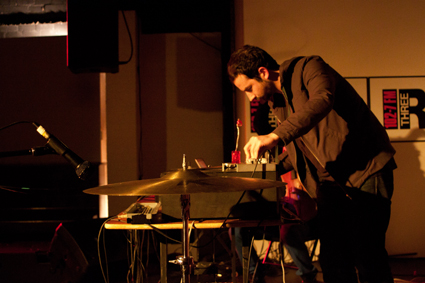
Joe Talia, Liquid Architecture
photo Sebastian Avila
Joe Talia, Liquid Architecture
Though their concert blacks and almost complete lack of lighting initially seemed out of place in a concert exploring the expanded possibilities of concert performance, Rushford and Talia’s subdued presentation resonated with their tense, horror-themed set. A reel-to-reel tape with foley effects and snatches of dialogue from The Evil Dead II provided the underlying structure of the performance. Rushford’s extended viola techniques and Talia’s processed ride cymbal contributed timbral washes and insidious scratching sounds between gasps and creaking doors. Sometimes the texture reduced to a deep rumble, while at other times careening, echoing tones from the viola produced an ear-splitting cacophony. Sometimes, long moments of silence passed in horror-movie suspense, punctuated by a breathy voice asking “are you all right?”
This question seemed to probe the discomfort we can have about unexpected silence in a performance situation, particularly when there is little to look at. What one usually realises, in the awkwardness of the moment, is not the fullness of Cagean silence, but that silence is profoundly changed in relation to the sounds that precede it. This is particularly evident in radio, where the relationship between sound and silence is even more carefully orchestrated than in a concert setting. For instance, as the Rushford/Talia set was broadcast on 3RRR, we were asked to make some crowd noise when the performance space became live. The “on air” sign was greeted with cheers, before which everyone was sitting quietly, conversing in hushed whispers. The sudden intrusion of ‘crowd noise’ in an almost pitch black performance space was absurd, just as a few coughs and creaking seats would have seemed out of place on a ‘live’ radio broadcast.
It is because of the mutual influence of silence and sound, rather than in spite of it, that the presentation of sound art needs to be taken into consideration. The darkness of an acousmatic performance, such as David Chesworth’s installation or Rushford and Talia’s set, encourages the audience’s focus on the reciprocity between sounds, while any visual element is capable of changing the listener’s experience of that relationship, such as Battus’ focused gaze as he tries—and fails—to bring a tin cup and a small motor into consonance.
Liquid Architecture 12, Festival of Sound Arts, Oceanography and Peron Station, composer David Chesworth, 3RRR, June 27-29; concert, Marc Behrens, Pascal Battus, Lukas Simonis, Dave Brown, James Rushford and Joe Talia, 3RRR, Melbourne, June 30
RealTime issue #104 Aug-Sept 2011 pg. 44
© Matthew Lorenzon; for permission to reproduce apply to realtime@realtimearts.net
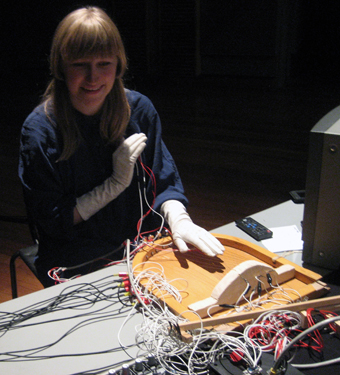
Pia van Gelder, Liquid Architecture
photo Somaya Langley
Pia van Gelder, Liquid Architecture
FOR THE LAST TWO YEARS, THE SYDNEY LEG OF LIQUID ARCHITECTURE HAS BEEN PRODUCED IN ASSOCIATION WITH ABC CLASSIC FM WITH ONE OR TWO CONCERTS BROADCAST THAT SAME NIGHT ON NEW MUSIC UP LATE. THE BROADCAST ASPECT SETS A CHALLENGE: HOW TO SATISFY BOTH CONCERT AUDIENCE AND HOME LISTENER. CURIOUSLY, THE ARTISTS PROGRAMMED IN CONCERT 2 ALL USED STRONG VISUAL ELEMENTS IN THEIR PERFORMANCES.
Pia van Gelder is very handy with a soldering iron, creating a variety of homemade electronic instruments—her audio-visual harp in this performance resembles a harp in shape only. Van Gelder dons white gloves with wired up electrical circuits in the fingertips. As she touches a combination of ‘strings’ or electrical componentry an audio signal is converted into a video signal. The resulting sound is a familiar dark buzz and hum with sharp on/offs, deep drones and rude eructations: electricity doing what it does when it’s being interfered with. The visuals range between bands of static-filled colour reminiscent of liquorice all-sorts and a kind of baroque wallpaper. While the audio element was engaging, it was a symbiotic composition—the radio listeners missed out on a vital aspect.
Marc Behrens’ piece was perhaps a better experience for the remote listener than for the live audience. In response to the oft-heard criticism that playing music from a laptop is not performative, Behrens augments his surround-sound set with a series of overly dramatic gestures and actions including some inexplicable play with a stool, none of which have any clear relationship to the sound being made. Whether they are in earnest or parody is also ambiguous. I asked Behrens about his performance and he said that he is inspired by the renowned Italian designer Bruno Munari’s explorations into interactive sculpture and the composer and intermedia artist Jerry Hunt. The reality however is that Behrens’ actions do not appear integral to his soundmaking, seeming rather like an unnecessary and distracting decoration. If performative provocation is the intention that’s fine, but surely listening is the point here? The audio I could focus on was finely detailed and dramatically spatialised.
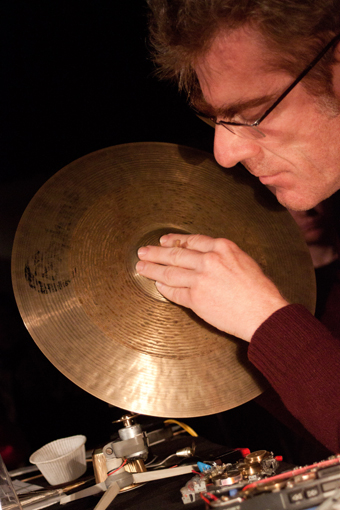
Pascal Battus, Liquid Architecture
photo Sebastian Avila
Pascal Battus, Liquid Architecture
Pascal Battus is more shaman than showman, extracting the essences of sound from a range of materials applied to the spinning gizzards of old Walkmans. The results are rewarding for the deep listener as each object is coaxed to emit its own subtle combination of rings, brrrrs and fricatives. Battus’ concentration is fascinating, like a watchmaker working in fine detail; however, having but two hands he can only make a maximum of two sound gestures at a time. Consequently, his piece becomes a series of similarly composed sonic moments as he works methodically through all the objects on his table. While the detail of each sound set would have been engaging, I am curious as to how the homogenous episodic structure held for radio listeners. However the final cymbal grinding with a dazzling array of harmonics was well worth waiting for.
Battus also presented a series of one-on-one ‘sound massages’ the following day. With eyes closed you sit opposite the artist while he performs a mini concert around your head: tiny scrapes, crackles and rustles define a complex sphere of listening. The manipulation of spatialisation is amazing, resulting in a feeling of deep intimacy with both Battus and the sounds themselves. It’s so simple yet so incredible I don’t know why we don’t do it all the time!
The sound massage was a little taster of a more innovative way of engaging with focused listening than the concert for radio format and made me crave more. In its current mode, Liquid Architecture in Sydney does seem to lack an engagement with, or support from, the local experimental scene. Perhaps this is due to its contracted size which limits local involvement and/or choice of venue: the exposure offered by ABC Classic FM is significant, but it seems audiences are not so keen on the live recording format and the formal setting of Eugene Goossens Hall, despite its great sound potential. Maybe Liquid Architecture is what it is—a touring concert (or two) but it’s hard not to long for an expanded program with associated events across a range of spaces (which I acknowledge means time, money and people’s energies). It will be interesting to see how the thematic focus of Liquid Architecture 13, Antarctic Convergence, curated by Philip Samartzis and Lawrence English, will shape next year’s event.
Liquid Architecture 12 Sydney, Concert 2, Pia van Gelder, Pascal Battus, Marc Behrens, Eugene Goossens Hall, ABC Ultimo Centre, July 2; Sound Massage, Pascal Battus, Bon Marche Building, UTS, July 3; national artistic director Nat Bates, Sydney co-producers Thomas Knox Arnold and ABC Classic FM; www.liquidarchitecture.org.au
RealTime issue #104 Aug-Sept 2011 pg. 45
© Gail Priest; for permission to reproduce apply to realtime@realtimearts.net
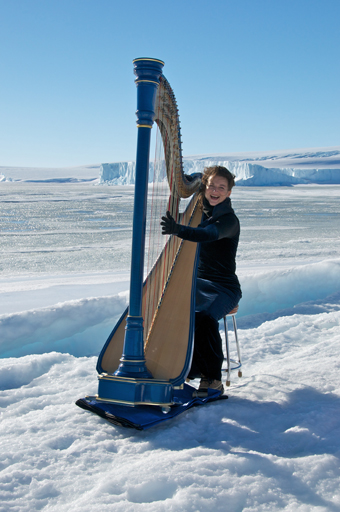
Alice Giles in Antarctica
photo courtesy the artist
Alice Giles in Antarctica
FOR MOST OF US, ANTARCTICA IS A PLACE OF THE MIND. FOR CT MADIGAN, A MEMBER OF THE 1911 AUSTRALASIAN ANTARCTIC EXPEDITION, IT WAS A VERY REAL PLACE WHERE SOUTH AUSTRALIA AND THE BRITISH EMPIRE BECAME DISTANT MEMORIES. A CENTURY LATER, AS A RECIPIENT OF AN AUSTRALIAN ANTARCTIC ARTS FELLOWSHIP, MADIGAN’S GRANDDAUGHTER, HARPIST ALICE GILES USES MUSIC TO REIMAGINE HER GRANDFATHER’S VOYAGE, BREAK THROUGH OUR FROZEN CONCEPTION OF THE PLACE AND LET THE STRANGENESS OF THE LANDSCAPE SEEP INTO HER OWN PERFORMANCE PRACTICE.
In his diaries, Madigan wrote of the importance of music and writing on a continent with so little of both. Records, songbooks and letters from home did not just sustain familiar memories, but testified to lives that persisted despite being obscured by distance. Writing about his fiancée Wynnis, Madigan confessed it “hard to find anything that I do not know by heart in her letters.” Just as static memories became dynamic when traces of life were found between the familiar lines of a letter, the Antarctic environment, long-supposed silent and monolithic, proved all too real for the early explorers. When Madigan’s close friends Xavier Mertz and Belgrave Ninnis died on an ill-fated sledging expedition, he grieved the loss of “fellow sympathy and confidences only known in the Antarctic.”
Since the real of Antarctica does not affect us in the same way today, it is not surprising that the heroic age of Antarctic exploration persists as our privileged image of the place. Today scientists are shunted around Antarctica in temperature-controlled bubbles and the category of ‘explorer’ has all but disappeared. However, thanks to an increasing interest in artistic ‘exploration’ of the continent, this monochromatic and silent image is giving way to digital clarity and surround-sound clamour as cinematographers, sound artists—and harpists—rediscover the continent with hand-held recording devices. ANU’s Antarctica: Music, Sound and Cultural Connections Conference showcased some of these processes of exploration, including Alice Giles’ Alice in Antarctica concert.
Alice in Antarctica reveals Australian composers’ dated understanding of the place as an object composed of shimmering surfaces and characteristic scenes (mainly involving penguins). It then asks, through a rapprochement between the natural environment and the harp, how the Antarctic environment might be understood on a personal level and affect musical practice.
Armed with a small lever harp and a full sized electroacoustic harp, Alice Giles arrived in Antarctica with a program, like a series of letters known by heart, of works composed about a continent largely unknown to Australian composers. Joshua McHugh’s “Billions of Penguins” for solo harp consisted of a series of vignettes characterised by waddling penguin rhythms. Jim Cotter’s “On Not Dancing with Penguins” expressed frustration at not being able to accompany Giles to Antarctica and painted the Antarctic landscape through repeated rising and cascading figures.
Larry Sitsky’s “Fantasias 16 and 17” for solo harp avoided musical depictions of the landscape, instead transplanting abstract music to both natural and artificial Antarctic environments. Fantasia 16 for lever harp was performed and filmed outdoors, while Fantasia 17 was performed indoors, utilising sound processing on the electroacoustic harp to suggest the natural scale of the continent. Martin Wesley-Smith’s “Aurora Wynnis” also avoided depicting landscapes, drawing on Madigan’s writings and the music he listened to while in Antarctica to develop a nostalgic picture of Madigan’s own nostalgia for home. Giles asserts that “more composers need to be going to Antarctica to bring back their expressions—we have been a consistent presence as a nation in Antarctica for 100 years and yet we have barely any musical expression of or from the continent.”
Perhaps it is not even in the music, but in the performer that the musical effects of Antarctica are to be found. As Giles wrote on her blog, a modern day explorer’s notebook, “[t]his is how I hope the Antarctic Adventure affects my playing: rather than the idea of programatic [sic] pieces to perform or compose, my world is concerned with how to express beauty from the heart. The perfection of nature I saw yesterday, not mechanical, ever changing, but uncompromisingly clear, leads me to seek perfection of expression and sound in every note with serenity.”
A musical presence in Antarctica is not only important for musicians, but for others who travel to the continent. Giles believes that “[m]ost people who travel to Antarctica—from ‘tradies’ to scientists—have a strong emotional response, but they have no vehicle to share and discuss this. Drawing historical reference into a contemporary program with an emotional but abstract musical thread seems to give this a universal expression.”
One of the most arresting compositions from Alice Giles’ journey is the video of her lever harp standing alone on the beach at Davis Station. The wind passing by the strings produces a constantly changing tone while the ice slushes on the shore and an elephant seal goes for a dip. It is a magical, minimal meeting between the elements and music, as if you had introduced two animals to each other for the first time to see if they would get along and they started singing to each other.
–
Alice in Antarctica, harp, voice, electronics Alice Giles, voice Tegan Peemoeller, Llewellyn Hall, ANU School of Music, June 26
RealTime issue #104 Aug-Sept 2011 pg. 46
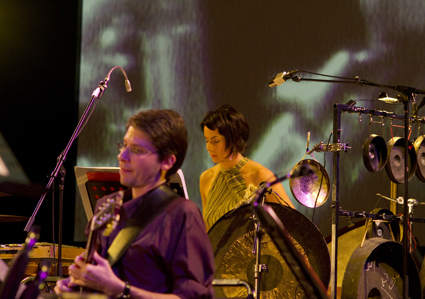
Ensemble Offspring, Professor Bad Trip
photo Oliver Miller
Ensemble Offspring, Professor Bad Trip
DOOF DOOF DOOF DOOF, nnSe nnSe nnSe nnSe…IN THE ABSENCE OF POPULAR MUSIC’S MOST UBIQUITOUS QUALITY, METRIC BEAT, ENSEMBLE OFFSPRING’S LATEST CLASSICAL PROGRAM, PROFESSOR BAD TRIP, DREW PARALLELS WITH ITS PALTRY YOUNGER SIBLING, POP, USING ASSOCIATIONS OF TIMBRE. SUPERSATURATED AND DISTORTED ELECTRIC GUITARS, BASS AND DRUM-KIT DROVE MUSICAL FRAGMENTS ALONG, NEVER AIMING TO ARRIVE ANYWHERE, JUST TRIPPING.
Ensemble Offspring regulars teamed with guests Zane Banks on electric guitar, Dave Symes on bass, Ngaire de Korte on oboe, Rob Llewellyn on bassoon and Alex Bieri on trumpet to explore the divide and crossovers between classical and popular music. None of the works in the program were derivative of popular music but, instead, asserted classical music’s currency. Each showed that classical music can attune to the modern world while simultaneously transcending the form’s perceived limitations. In a packed Bay 20 at CarriageWorks the audience took a trip to the future of classical music. Our psychoactive tendencies were polled in an audience survey that asked us to name our hallucinogen of choice: Peyote, mushrooms, LSD or nutmeg.
Early in the program “Study for String Instrument #2” by fan of allspice and composer Simon Steen-Andersen raised the whammy pedal onto a classical pedestal. The pedal’s sound-modifications are unusually scored for a separate player from the string instrumentalist. It was performed by the fantastically frenzied Geoff Gartner on cello with ‘whammy assistant’ Adrian Bertram. Gartner played mad glissandi; he bowed the edge of the cello rather than the strings while tapping the instrument’s body to produce wild effects. I heard battling space gerbils, while Ensemble Offspring’s Damien Ricketson called the study’s ludicrously exaggerated language “a grotesque caricature of itself.”
Australian Matthew Shlomowitz’s “Joy Time Ride for Ives” parodied art music’s relationship with the musical cliché. Schlomowitz challenges the prevalent aesthetic in classical music that once a musical idea or motif is overused it’s no longer artistically classy. Instead he makes cliché the focus of this composition, exercising snippets of rock beat on drum-kit and recurring flourishes through the upper woodwinds. The repeated fragments are attention grabbing and a little jolting. It’s a relief to hear a familiar passage but you feel luxuriantly trashy enjoying something that’s been sounded so many times before. Cliché winSe nnSe nnSe.
The central works of the evening though were the three “Lessons” of Fausto Romitelli’s “Professor Bad Trip.” Inspired by the mescaline-fuelled poetry of Henri Michaux and the mind-bending drawings of Gianluca Lerici, aka Professor Bad Trip, Romitelli’s exploration of psychedelia is hallucinatory. In the broadest sense, hallucination is perception in the absence of stimulus—it’s the invention of something greater than what is really there. Each “Lesson” does just that. It breathes. It heaves. The music expands and contracts in such extraordinary plays with time that it’s as though universes are born and die with each surging sound. Time actually alters when you’re listening to this music.
“Ever since I was born, I have been immersed in digitalised images, synthetic sounds, artefacts,” the late Romitelli had explained. “Artificial, distorted, filtered—this is the nature of man today.” With this acceptance of the modern racket Romitelli’s sound world draws careful inspiration from disparate sources: from Ligeti to rock, electro and techno. He considered sound to be “a material into which one plunges in order to forge its physical and perceptive characteristics: grain, thickness, porosity, luminosity, density and elasticity.” Romitelli’s music is sculpture of sound, instrumental synthesis, transformation of spectral morphology. It’s in constant drift towards unsustainable densities, distortions and interferences. When I was able to escape the waves of immersion in his music for long enough to reflect, the phrase “an acoustic Aphex Twin” kept surfacing.
Video projections repositioned the audience’s attention out of the music and back onto the musicians. It assured we stay present, but was unnecessary for the majority of the time as the musicians were doing such a good job of transmitting the music that their bodies became superfluous to the art in action. Occasionally the filming caught a facial expression of concentration or communication that would otherwise have been invisible and this invited us deeper into their practice. It also reminded us to change our focus—in seeing someone new, we heard something new. Comedian Bill Bailey describes his experiences on acid as spending hours noticing ever more detail in the few things positioned beside him. He says while darting his head about, “Oh that’s quite interesting, that’s quite interesting, yes, that’s quite interesting.” Visuals, here, revealed the momentarily invisible points of interest.
As I left with an uncanny desire to bake spiced cookies, I thanked these musicians for creating a space for this music to be heard, inhaled, versed, warped, wet, born, aired…Who needs drugs anyway? Just as Ensemble Offspring had assured us in its pre-concert hype, I’ve been changed by this music. New music isn’t what it used to be.
Ensemble Offspring, Professor Bad Trip: Mind Altering Classical Music, conductor Roland Peelman, flute Lamorna Nightingale, clarinet Jason Noble, oboe Ngaire de Korte, bassoon Rob Llewellyn, trumpet Alex Bieri, keyboards Zubin Kanga, percussion Claire Edwardes, violin James Cuddeford and Veronique Serret, viola James Eccles, cello Geoffrey Gartner, double and electric bass Dave Symes, electric guitar Zane Banks, electronics Adrian Bertram, sound Bob Scott, lighting Neil Simpson, video Sean Bacon, Bay 20, CarriageWorks, Sydney, June 18
RealTime issue #104 Aug-Sept 2011 pg. 47
© Felicity Clark; for permission to reproduce apply to realtime@realtimearts.net

Chris Abrahams, Mike Majkowski, James Waples, Roil, the NOW now
IN PART TWO OF THIS SURVEY OF EXPERIMENTAL MUSIC AND SOUND HAPPENINGS IN SYDNEY, I TAKE IN TWO REGULAR EVENTS THAT SEEMINGLY SIT AT EITHER END OF THE CURATORIAL SPECTRUM: THE PURE SPONTANEOUS MUSIC PURSUITS OF THE NOW NOW SERIES, ONE OF THE LONGEST RUNNING GIGS; AND THE GLORIOUSLY HETEROGENEOUS SOUND SERIES WHICH STARTED IN 2010. WHILE THESE GIG SERIES HAVE QUITE DIFFERENT APPROACHES, THERE IS A STRONG SENSE OF COMMUNION BETWEEN THEM AND IT IS THIS CROSS-FERTILISATION THAT IS CURRENTLY MAKING THE SYDNEY SCENE ALL THE MORE VIBRANT.
the NOW now
The NOW now series is probably well known to readers but to recap, it was started by Clayton Thomas and Clare Cooper in 2001 under the moniker “If you like improvised music, we like you,” from which the first NOW now festival evolved in 2002. The unruly name persisted until the co-founders re-located to Berlin in 2007 and the festival and series became collectively run, both under the same title. The current curatorial team is Sam Pettigrew, Rishin Singh and Laura Altman.
The NOW now series has had many a home since it started at the now defunct Space 3 Gallery in Redfern. Currently events occur monthly and sometimes fortnightly (as they did originally) at Serial Space and a range of other places around the inner-city. Number 6 in the series took place in 402, one of the live-in warehouse spaces in Hibernian House, Surry Hills, featuring a baby grand piano. While occasionally the curation allows a slightly broader sweep of music styles, this evening offered a line-up of pure, unadulterated improv.
First up was Erebis (sitar and double bass) vs Reuben Lewis (trumpet) from Canberra. Lewis is conventionally clad while Erebis dresses up in yukata and plastic Elvis wig, but their music is not quite so flamboyant, offering a version of minimalist free jazz. On the whole they focus on rhythmic and harmonic exploration and only in their fourth piece does it feel like they are starting to approach newer territories by introducing unpredictable timbres.
Unpredictable timbres is what it’s all about for Dale Gorfinkel and Arek Gulbenkoglu from Melbourne. Gorfinkel has a serious sense of play placing objects on his vibraphone and exploiting their rattles and frictions. By casually coaxing materials into action he makes a complex multilayered soundscape with occasional haunting tones from the vibe keys. Gulbenkoglu is a perfect companion on snare drum and objects, using more minimal methods, yet adding just the right rattle of pine cone on snare, metallic ring of egg whisk on rim and tiny chopper effect of a small fan held close to microphone. Their battle of Styrofoam sounds was a particular highlight in a set that felt truly exploratory.
Ivan Lysiak offered a brief piece of guitar feedback. There’s a sense of egolessness as Lysiak lets the signal flow, manipulating its cycles with small changes of proximity between the guitar and the small amp placed on top of an ironing board. It’s not a nice sound, more a nasal whine than a deep, dark massaging drone, but it develops more textures the longer he plays. He goes where the sound goes and then he stops, turning off the amp and holding still, as we do for a breathless minute of ‘silence.’
Roil is Chris Abrahams on piano, Mike Majkowski on double bass and James Waples on drums. Abrahams’ repetitive melodic figures wind around Majkowksi’s angular bass lines, while Waples disperses timbral shimmers that draw it all together. With an instrumental line-up similar to The Necks in which Abrahams also plays, it’s hard not to listen for similarities, but instead of the slow build of the former this combination of characters suggests a journey across constantly shifting territories. One player finds a zone and the others look for ways to meet him there. After a while another wanders off again and the quest continues. This tangible sense of the musicians travelling into the unknown together illustrates the NOW now ethos at its best.
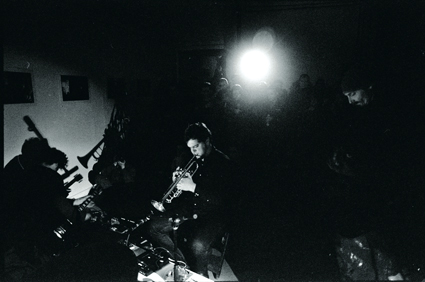
Matthew Syres, Joe Cummins, Dirk Kruithof, Forenzics, Sound Series #15, photo Lucien Alperstein
sound series
Sound Series, curated by Romy Caen, held monthly at Hardware Gallery in Enmore, started in March 2010 and has quickly become a highlight of the alternative music scene. What is distinctive about Sound Series is its eclectism with four to six acts per night ranging from alternative rock/pop to electronica, improv and noise.
Sound Series 15 kicked off with Textile Audio, aka Eve Klein, an electronic composer and mezzo soprano. In the intimacy of the small gallery, her operatic performance is, as she describes it, a little in your face, but her sense of quiet assurance eases the awkward context a little. Klein has a fine voice and creates some intriguing electronic accompaniments, but for my taste (which I admit doesn’t run to opera), Textile Audio doesn’t disrupt the classical conventions quite enough, however many in the crowd were spellbound by her virtuosity.
Next up was Secrets, from New Zealand making some great bouncy pop beats, with almost catchy melodies delivered in a kind of slacker vocal style hidden deep in the reverby mix. With livelier vocals you could imagine these songs being pop hits—people were almost dancing—and Secrets’ performative presence, a mixture of nervousness and reckless abandon, is rather endearing.
Forenzics have been around since 2005 but I hadn’t heard them play. With Matthew Syres on guitar and way too many effects pedals, Dirk Kruithof on lead guitar, Joe Cummins on trumpet and Kaos pad and Alex Slater on drums they play loose yet utterly cohesive improv inflected with jazz, rock, drone and psychedelia. Joe Cummin’s trumpet loops and soaring melodies are a particular highlight creating a smoky, sensual atmosphere and the rhythmic interplay, pushing against the metre with loping rubatos, gives the sound an intriguing elasticity. It occurred to me that music is best when it picks you up and takes you somewhere you didn’t know you wanted to go, and Forenzics did just that.
The final set was by Sydney veterans Toydeath who, if you haven’t seen them play in the last 15 years, dress like creepy children’s TV show characters and create music purely from electronic toys ‘defiled’ with audio outputs so they can be amplified. A particular highlight is their cover of Billy Joel’s “It’s Still Rock and Roll to Me” featuring a hee-hawing donkey and the track with lead vocals by a scripture quoting Jesus doll (yes such a thing exists!). Back from a recent US tour, they presented a slick show that had the crowd on their feet.
I ask Romy Caen about her approach to curating these very successful nights and she answers, “There’s a broad community in Sydney which I think is loosely connected through the idea of experimentation but comprises really varied practices and genres. Instead of specifically seeking experimental performers Sound Series tends to dip into this pool of people.” These resulting ‘hybrid’ gigs often bring large and new audiences. Caen suggests that maybe this is because “Sound Series inhabits a strange realm between mainstream and underground events,” strongly influenced by the venue—a commercial gallery rather than a hard to find industrial space (and sometimes the drinks are free.) While this eclectism is not necessarily to the liking of some purists, Sound Series is doing a great job creating an exciting atmosphere around experimentation across a range of musical styles.
My final report on Sydney sounds and scenes will look at ¼ inch, psh.live plus more.
The NOW now, Series #6, Erebis vs Reuben Lewis, Dale Gorfinkel & Arek Gulbenkoglu, Ivan Lysiak, Roil, curators Sam Pettigrew, Rishin Singh, Laura Altman, 402 Hibernian House, July 26; www.thenownow.net; Sound Series #15, Textile Audio, Secrets, Forenzics, Toydeath, curator Romy Caen, Hardware Gallery, July 23, http://tiny.cc/aox79 Lucien Alperstein’s exhibition Water and Music featuring photos taken during previous Sound Series events was exhibited at Hardware Gallery July 5-23
RealTime issue #104 Aug-Sept 2011 pg. 48
© Gail Priest; for permission to reproduce apply to realtime@realtimearts.net
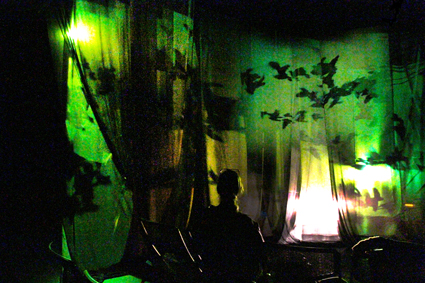
Hourglass
photo Sarah Kaur
Hourglass
HOURGLASS IS AN IMMERSIVE LIVE PERFORMANCE AND NEW MEDIA INSTALLATION THAT EXPLORES THE EXPERIENCE OF TIME. IT IS AN EVOLVING COLLABORATIVE WORK FEATURING A TEAM OF AUSTRALIAN AND MEXICAN ARTISTS INCLUDING NICOLE CANHAM (WHIRLY, CLARINET, TAROGATO), SARAH KAUR (VIDEO), IVAN PUIG (TECHNOLOGY ARTIST) AND CARLOS LOPEZ CHARLES (COMPOSER), WHO WERE BROUGHT TOGETHER BY A PUNCTUM IN-HABIT INTERNATIONAL GRANT TO DEVELOP THE FOUNDATIONS OF A NEW WORK.
Canham and Kaur had worked together previously, exploring the relationship between image projection and music performance, and Canham had also visited Mexico with the help of a Churchill Fellowship. The four artists initially spent an intensive period at CMMAS (Mexican Centre for Music and Sonic Arts) developing their concepts and working relationships, then a period of virtual collaboration and, finally, a week in Bendigo to workshop their ideas, resulting in a performance encapsulating some of their thoughts and experiments. We experienced a 25-minute sampler of a projected hour-long work involving the four artists and Rodrigo Sigal (composer), Drew Crawford (composer), Jose Luis Garcia Nava (new media artist) and Javier Alvarez (composer). It featured works specially written for Hourglass, but also earlier works adapted for the performance. The final version will probably consist entirely of works specially written for the project.
The aim was to create an immersive space that accommodates electroacoustic music, video, installation and a live performer, breaking away from the often formal presentation of new music. Layered black chiffon separated the audience from performer and installations, also acting as a multi-layered screen for video projection; the 3D rhythm generated by images slightly offset by the screens was enhanced by movement due to the airconditioning system. However, the audience was confined to a quarter of the space, restricting the immersive character of the visuals, while a 10-speaker system engulfed us.
Within this space we were presented with a series of musical vignettes centred on the passing of time or feelings generated by it, imagining the space as the inside of an hourglass (grains of sand fall from the ceiling at the end of the performance).
The program began with Into the Hourglass, an improvisation developed by Canham and Charles for whirly and electronics. The tonal range of a whirly is limited but it was intriguing to see how the sounds were created. The computer manipulation was subtle and lingered after the instrument stopped. Kaur’s multi-projection of watery ripples was our first introduction to the black chiffon screen in this short, atmospheric mood piece.
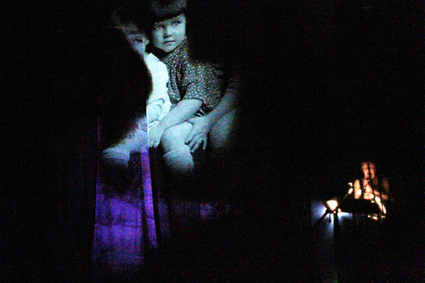
Hourglass
photo Sarah Kaur
Hourglass
Not Alone for clarinet and live processing by Carlos Lopez Charles was really a musical duet in three dimensions. Canham’s clarinet fragments were picked up and manipulated by Charles using live digital processing (Max/MSP). The echoes, mimicking techniques he used as a rock guitarist in the 80s/90s, were expertly moved around the immersive speaker system. As the piece progressed, the clarinet took on a more delicate tone, resulting in a subtle dialogue between clarinet and computer-generated echo. Kaur’s visuals featured random abstract shapes which may have felt more appropriate had their rhythm echoed the looping character of the music.
Next came a short performance by Ivan Puig’s glass bottle contraption (a miniature reference to his beautiful light and sound glass machine, “Mandalas for a Modern Life”), which was both too brief and difficult to see because of its size and positioning. The projected text—“Is it wise, the way the clock turns?”—reminded us of the premise for Hourglass. Puig’s complex machines have a wonderful character of their own and it was a pity his creative contribution was relatively minor here because of the short time he had in Australia. Hopefully the full version rectifies this.
Rodrigo Sigal’s “Vida Lunar” for clarinet and tape was the most substantial piece on the program. Adapted from a piece written for alto flute, all the components came together here: Canham’s extended clarinet techniques, Charles’ immersive diffusion of the complex electronic score and Kaur’s vintage monochrome family photos floating throughout the space.
Paula Matthusen’s “Before the Weather Changes” for sampled tarogato and electronics introduced us to the haunting sounds of the tarogato, a Hungarian folk woodwind recently adopted by Canham for development of a contemporary repertoire. This meditative piece was designed to include a live interactive video, a moving starscape by Jose Luis Garcia Nava, possibly created in “Processing,” but in this performance a video record from a previous performance was screened.
The program finished with Australian composer Drew Crawford’s “Time Flies When You’re Having Fun” for tarogato and tape, which turned out to be a three-minute sketch for a longer piece being developed for Hourglass. Featuring live and looped tarogato and some recorded percussion, it created a playful mood, but didn’t have time to develop. The best part was Kaur’s poetic video manipulation of images of a flock of birds.
Many in the audience were enthralled by Hourglass, but I felt a little hesitant. I sometimes feel sympathy for Francisco Lopez who blindfolds his audience, removing distractions from the listener. Hourglass went to the other extreme, not only immersing the audience in sound, but ensuring they kept their eyes open. Before the performance Canham said “we were less interested in utilising new technologies or looking into ground-breaking techniques as we were in exploring the poetic, the beautiful and narrative ways our art forms could interact.” This worked best in Rodrigo Sigal’s piece where all the elements came together and would have been even better had the audience been free to move around and feel the work—as planned for the future.
Punctum’s Hourglass, artists Nicole Canham, Sarah Kaur, Ivan Puig, Carlos Lopez Charles and guests, Old Fire Station, Bendigo, May 28-29
RealTime issue #104 Aug-Sept 2011 pg. 49
© Jacques Soddell; for permission to reproduce apply to realtime@realtimearts.net
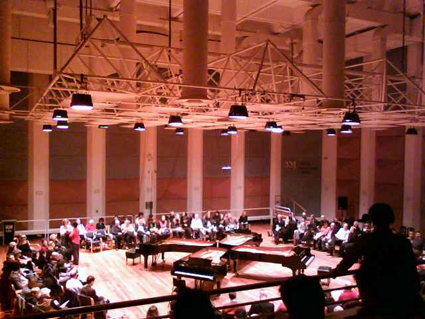
Canto Ostinato
photo Virginia Coventry
Canto Ostinato
WHEN ACTRESS AND DIRECTOR JO KENNEDY INTRODUCED DUTCH COMPOSER SIMEON TEN HOLT’S CANTO OSTINATO (1979) TO MELBOURNE COMPOSER ELIZABETH DRAKE IN EARLY 2009, SHE SET IN TRAIN A MUSICAL LOVE AFFAIR THAT SAW AN EXPLOSION OF PERFORMANCES IN ADELAIDE, PERTH AND NEWCASTLE. DRAKE RECENTLY JOINED FORCES WITH RENOWNED AUSTRALIAN PIANISTS LISA MOORE, CAROLINE ALMONTE AND EMILY GREEN-ARMYTAGE AT IWAKI AUDITORIUM FOR CANTO OSTINATO’S MELBOURNE PREMIERE. CAREFULLY CRAFTING THE WORK’S LONG-RANGE STRUCTURE AND MOMENTARY ARTICULATION, THE ENSEMBLE PROVIDED A CONSTANTLY EVOLVING DURATIONAL LISTENING EXPERIENCE.
Concentric staging lent Iwaki Auditorium a charged atmosphere, with the pianists eyeing each other off like gunfighters around their four grand pianos. The performers’ intense concentration was echoed by the audience, seated in the round like townsfolk gathered to witness a bloody ordeal. Finally, Lisa Moore started the limping five-pulse rhythm that drove the piece forward in one form or another for the next hour and a half. The other pianists contributed complementary ostinati: an insistent, dissonant peal; a swaying melody in the middle register; a loping bass line; until the developing harmony filled the auditorium. Sometimes the texture thinned to a solo line, or five parts raced along like a cartoon chase scene, before bursting into a rocking sea shanty theme. The performance’s success as a musical journey hinged on the close attention paid by both composer and performers to the boundaries of improvisation and determinacy in the work’s construction.
The score is divided into short rhythmic cells that the performers may repeat as many times as they wish and with their own articulation, before coming together for through-composed bridge passages. Ten Holt’s score is ingeniously put together, with five interlocking piano parts capable of producing a wide range of musical effects. Previously a composer of atonal and extended tonal music, ten Holt was “mystified when this music started pouring out in the form it took—entirely tonal and gradually evolving texturally, gesturally and harmonically.” Canto Ostinato’s romantic harmonic idiom might also come as a surprise to fans of minimalist composition, distinguishing it from the pale tonality of its immediate predecessor, Steve Reich’s “Music for Eighteen Musicians” (1976). Caught between modernist complexity, romantic melodicism and minimalist duration, the performers challenged themselves to keep the sophisticated musical machine moving while leaving space for the unexpected to occur.
To Drake, the experience of listening to minimalist music is captured in Henri Bergson’s description of sitting by a river in Duration and Simultaneity (1922): “When we are seated on the bank of the river, the flowing of the water, the gliding of a boat or the flight of a bird, the ceaseless murmur in our life’s deeps are for us three separate things or only one, as we choose.”
Like Bergson’s river, boat and internal monologue, Elizabeth Drake wants the listener to hear Canto Ostinato as a unity of disparate elements. She does not leave this synthesis up to the listener, carefully analysing the score and shaping the performance in order to provide the conditions under which the performers may interact. Drake brought her experience composing for film and theatre to the work, storyboarding each section to take advantage of terraced dynamics, extended crescendi and transpositions. The next step was to integrate articulation into the dramatic outlines of the score.
In developing articulation, the performers found themselves confronted with the problem of trying to repeat musical novelty. “We would be playing as though saying ‘this is what this is about now. It’s about this Db to this C,’” Drake remembers. “But if you introduce an idea, you can only repeat it once. You can introduce it, then you can repeat it. But the purpose of repetition is not to introduce material, it is to keep going until something unexpected happens.”
Caught between the possibilities of an evenly articulated but ultimately boring duration piece and an overbearing repetition of musical emphases, the performers looked to interaction to keep the performance interesting. “We had the directive that we could abandon the plan,” remarks Drake. “You can let things open out if you have a very strong structure and a strong sense of interaction. The stronger the structure, the stronger the plan, the better the performers know what to listen for, the further you move away from just reciting a dictionary of possibilities. You can make a new composition.”
The performers’ detailed knowledge of the score came across in their smooth and gripping performance. Beneath their covert nods and the dazzling, ever-changing surface of the music, part-swapping proceeded seamlessly, page turns were managed with military precision and the performers could focus on letting moments of singular beauty appear.
Canto Ostinato, composer Simeon ten Holt, performers Lisa Moore, Caroline Almonte, Emily Green-Armytage, Elizabeth Drake, IWAKI Auditorium, ABC Southbank Centre, Melbourne, May 13
RealTime issue #104 Aug-Sept 2011 pg. 50
© Matthew Lorenzon; for permission to reproduce apply to realtime@realtimearts.net
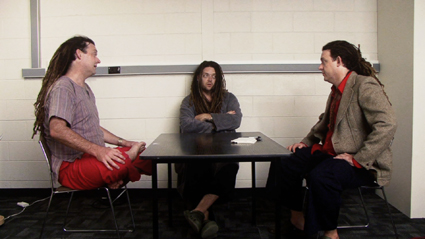
Dept. of Crippling Self-Doubt, short film still, Robert Harding, Graduate, RMIT College of Design and Social Context
courtesy the artist
Dept. of Crippling Self-Doubt, short film still, Robert Harding, Graduate, RMIT College of Design and Social Context
WHEN MORE THAN 1200 PEOPLE PACKED INTO THE MELBOURNE TOWN HALL FOR A KEYNOTE LECTURE AT A WORLD CONGRESS ON ART HISTORY (CIHA) IN 2008, EVEN CONVENER JAYNIE ANDERSON OF THE UNIVERSITY OF MELBOURNE WAS SURPRISED AT “THE STRENGTH OF PUBLIC SUPPORT FOR ART HISTORY IN MELBOURNE.” HER THEME, “CROSSING CULTURES: CONFLICT, MIGRATION, CONVERGENCE,” STRUCK A CHORD AND THE DIVERSE PAPERS DELIVERED ON AUSTRALIAN ART UNDER THIS CROSS-CULTURAL RUBRIC ATTRACTED THE INTEREST OF THE CAMBRIDGE UNIVERSITY PRESS WHO APPROACHED ANDERSON TO COMPILE A BOOK IN THIS VEIN. THIS OCTOBER WILL SEE THE PUBLICATION OF WHAT PROMISES TO BE A GROUNDBREAKING NEW TEXT, THE CAMBRIDGE COMPANION TO AUSTRALIAN ART.
Such publications, says Anderson, reflect growing international interest in “radical new ways of looking at what’s happening south of the equator.” For students picking up the book from the library shelf its lateral essays exploring the intercultural connections of Australian art will present a distinct departure from reigning texts such as McCulloch’s Encyclopedia of Australian Art (2006). At the same time, the way Australian art positions itself in relation to the rest of the world has always been a phenomenon of shifting sands as the tensions over tradition and contemporaneity, and local versus global, are frequently taken up for revision. For today’s students of the visual arts navigating the pluralistic currents of the university curriculum, which vary from institution to institution, must at times prove a giddying experience. As horizons broaden, does this necessarily imply that Australian content becomes narrowed? How adequately are Australian artists represented in the university curriculum at present?
australianness an issue?
“In the last decade or so, ‘Australian’ as a category has become less important to students,” observes Martyn Jolly, Head of Photography and Media Arts at the Australian National University’s School of Art in Canberra and a practising photographer and writer. “When I was a student, Australian identity was a big issue. I think that contemporary students at art school are less concerned with Australianness as an issue. Photography has always been globalised but it is now moreso than it was 10 or 20 years ago.”
While “concerns with what it means to be Australian as a particular topic” might be receding, Jolly argues that “for myself personally and staff generally, there is an emphasis on maintaining Australian photographic history and particularly the issues that Australian photography talks about.” This continues to be achieved through studio lectures on Australian photographic history and a “heavy emphasis” on Australian and Asian Art in the Art Theory program as well as initiatives like regular gallery visits, exposing students to the growing body of books on Australian photography and a vibrant visiting artists program. As Jolly notes, “scholarship on Australian photography is going on still and shows dealing with Australian photography are still happening, like the recent Judy Annear-curated Photography & Place at the Art Gallery of New South Wales. So you’ve just got to include all of that in the curriculum.”
learning from the local
The declining interest in national identity is less of a concern for arts writer and academic Jacqueline Millner, Lecturer in Theoretical Enquiry at Sydney College of the Arts and formerly at the University of Western Sydney, than the implication for students of the prevailing sense “that the local practice is not as compelling or significant as some of the international examples,” which can translate into missed learning opportunities. To counter this, Millner suggests that from the foundational level and onwards students would benefit from greater exposure to local examples. “I’m a firm believer that you should work with what is at hand to begin with because I do think there is a strong pedagogical benefit to actually being able to see and experience the works you’re talking about without relying on reproductions for instance, and for honours and postgraduate students in particular to have access to the artists themselves. I think in general there is not enough attention paid to local practice and that is, not exclusively but at least partly, a result of residual cultural cringe.”
Millner’s philosophy hinges upon “the need to be attentive to what’s happening on the ground around you” and is further reflected in her book, Conceptual Beauty: Perspectives on Contemporary Australian Art (Artspace, 2010; reviewed RT98, p50) which draws upon a decade of arts writing practice. By placing analyses of artists who might be overlooked by mainstream art histories, predominantly but not solely women artists, alongside more well-known Australian practitioners like Fiona Hall and Patricia Piccinini, Millner reveals there is great scope for more expansive definitions of “Australian art.” Asked to comment on the gender mix of Australian content generally presented at a tertiary level, Millner points out “the curriculum tends to be more skewed toward male practitioners. This is something that I address, perhaps not even consciously, through my subjects which tend to be dominated by examples from female practitioners.”
indigenous art: beyond euro-centrism
In identifying shifts in student attitudes towards Australian art, the case of Indigenous art presents a clear exception with a number of academics citing steady growth in this area. According to Jaynie Anderson, “14 years ago we didn’t get a huge amount of interest in Indigenous courses but we do now.” Senior Lecturer in Art History and expert in Indigenous art at the University of Queensland, Sally Butler, agrees that the increased attention paid to Indigenous art is “helping people to look beyond Euro-centric ideas of art,” however, it does remain “a little marginalised.” Students of Indigenous art courses become “hooked for life,” says Butler, but overall there’s still some “resistance to the idea of stepping outside the comfort zone of a Euro-American tradition.” In a 2006 Artlink article, Sylvia Kleinert observes course categories can also prove misleading. Artists such as Gordon Bennett, Tracey Moffatt and Lin Onus, for example, “have consistently refused to be marginalised by their ethnicity, demanding instead to be included within the broader, more inclusive category of Australian art.”
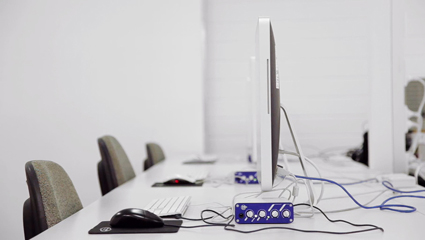
Structures to move to (conversations on work), Chloe Hughes (UNSW), 17 min HD video & sound work, winner of the Dr Harold Schenberg Art Prize presented at this year’s HATCHED Graduate Show
not just in a name
At the University of Queensland, Butler also points out that “there’s far more local content than is necessarily perceivable just from the names of the courses.” She confirms that among students “there’s certainly less interest in a kind of national canon of Australian art.” Yet as the university has cultivated an expertise in Australian art, established at the expense of other areas like early European modern art, for example, “Australian case studies and examples are embedded widely across everything we teach,” Butler explains. In addition to two specific Australian art courses, for instance, “Studies in Photography would actually include 50% Australian art content, Asia Pacific Art includes 50% Australian art, International Contemporary Art includes 50% contemporary Australian art.” Add to this regular visits to local galleries and “students do go away with a very good understanding of practitioners and exhibition activity in Australia.”
Likewise, Anderson argues the University of Melbourne offers many courses with an Australian component; however, “we wouldn’t necessarily call it ‘Australian’ in the title. We’re living in a global age so if you isolate and ghettoise Australian content that’s not good. Rather, we will integrate it at all levels and at the postgraduate research level especially there is a vibrant research culture into Australian art topics.”
This quiet repackaging of university visual arts courses that paradoxically strive to engage with local content while not overtly branding it “Australian” might not appear problematic to some but for Jolly, as a practising artist who does see himself as making work “in an Australian context first and foremost,” the situation appears to resonate on a more personal level. “I gave a talk at the National Gallery of Victoria recently about the 1980s tableaux vivants and it did make me think about how in the 80s we would have called ourselves Australian photographers and we were making work about Australia.”
connecting the local with the global
Directing students to points in art history where South Australian artists are recognised for their active role in global movements, such as the connections between Adelaide artists of the 1940s and 50s with Surrealism and Adelaide’s role in the development of post-object art, is one strategy Jude Adams has adopted at the South Australian School of Art (part of UniSA) where the cultural cringe is compounded by the regional versus eastern seaboard opposition. A lecturer whose courses include Australian Art: Image, Issues and Identity, Adams observes that studio based courses may be “less reflective” of local practices and can unwittingly “reinforce the cultural cringe.” That said, artists’ talks are a compulsory part of the BVA program and usually feature Australian artists. Adams is proactive in wearing down “ingrained attitudes,” emphasising to students that knowledge of Australian art benefits studio practice by “providing a context, a genealogy that helps us to know where we came from.” Adams suggests a perceived student prejudice against Australian art might also be a reaction against history (similar to that identified with Australian history in the secondary school syllabus) while the contemporary can seem more relevant. Within the university, however, “there are so few courses and so few staff, there’s really not much chance to introduce more Australian content.”
the local, a world lived in
It’s this pendulum effect which makes quantifying Australian art content in university curricula such a delicate task as increases in one area imply decreases in others. Certainly, the internationalisation of visual arts courses, and the more recent flourishing of cross-cultural approaches as exemplified by the upcoming Cambridge Companion, represent healthy counterpoints to geographical and cultural insularity. At the same time, most educators agree it would be a mistake to swing too far from local practices, although attitudes towards methods of implementation vary. Embedding local examples with international content appears a logical and pragmatic strategy, but in practice this can be effective only when students are actively challenged to engage deeply with a breadth of local examples and not simply overlook them. A goal all good teachers will aspire to, Jaynie Anderson argues, whether experts in Australian art or not. “Any real art historian will be able to relate their specialisations to the part of the world they live in, the culture they work in,” she says, “otherwise they won’t be successful.”
RealTime issue #104 Aug-Sept 2011 pg. 52
© Ella Mudie; for permission to reproduce apply to realtime@realtimearts.net
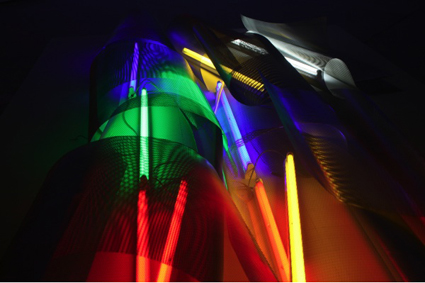
Peter Kennedy: Light Years 1970-1
AUSTRALIAN CONCEPTUAL ART PIONEER PETER KENNEDY’S WORK WAS THE SUBJECT OF A RECENT MAJOR EXHIBITION AT THE INSTITUTE OF MODERN ART, BRISBANE. LIGHT YEARS 1970-1 PRESENTED WORKS FROM THREE SOLO SHOWS OF INSTALLATION, LIGHT, PERFORMANCE AND SOUND WORK THE ARTIST MOUNTED IN 1970 AND 1971. KENNEDY BEGAN TO EXPLORE THE POSSIBILITIES OF MINIMALIST ART WORK WHILST WORKING AS A SIGN DESIGNER AT CLAUDE NEON, CHANNELLING HIS INDUSTRIAL EXPERIENCE INTO A SERIES OF WORKS EXPLORING THE CREATIVE POTENTIAL OF THE MASS-PRODUCED MEDIUM OF NEON TUBES IN THE GALLERY SETTING.
Neon Light Installations (1970/2011) is one of Kennedy’s key early light works and one of the best-known early instances of Australian light art. Kennedy first presented the work in February, 1970, at the Sydney incarnation of the ground-breaking contemporary art space, Gallery A. In the spacious concrete IMA cavern in Brisbane, the straight lengths of coloured neon, intensified by reflective housings, occupied not just the vertical surfaces of the walls, but the corners, ceiling-lines and gleaming horizontal expanse of the floor. What is illuminated is not the material per se, but its effects, drawing our attention to the nature of light as a temporal and spatial presence. Pouring itself around the room’s contours—literally escaping framing conventions—this work treats all interior surfaces as a single, distributed compositional material, one that registers both the interplay of overlapping beams and incidental reflections, and the movement of spectators’ bodies throughout the gallery space: light describing a room.
This contingency is taken further with Luminal Sequences, from Kennedy’s second and final show at Gallery A Sydney, in March 1971, which played on the subjectivity of time through the integration of documentation into subsequent iterations of the artwork. In this work, past and present, the actual and the depicted, absence and presence are brought together in a work featuring neon lights on timers, spotlights and slide projectors. The projections, featuring images of the gallery space, the light work itself and spectators engaging with it, are what shifts the work into a critical postmodernist terrain. This kind of art practice has a long history, as the IMA’s attendant screening of trailblazer László Moholy-Nagy’s Lightplay Black-White-Grey (1930) showed, but with the incorporation of viewers into the ongoing expression of the work and the series of effects this generates, inter alia, about the relations between perceiving bodies, the artwork and documentation, marks the point where high modernist abstraction gives way to conceptualism.
Concurrent with the second Gallery A show in 1971, Kennedy staged another exhibition at Inhibodress, the infamous alternative space he ran with artist Mike Parr (who featured prominently in Let the Healing Begin, the IMA exhibition immediately prior to Kennedy’s). But the Fierce Blackman was a John Cage-inspired sound-performance piece embracing chance operations in subject matter, tones, duration and dynamics. At the heart of this piece was a looped tape recording of Kennedy repeatedly intoning the (randomly chosen) mantra “but the fierce blackman” over a PA, accompanied by a television tuned to static, which intercepted moments of radio signals from passing taxis and a whirring electric fan. In the original performance, the artist appeared at half-hour intervals to intervene with further recitals of the phrase live through the PA. Installed as a documentation piece, while still menacing—owing to the powerful echoes of the artist’s distorted vocals throughout the space—the work appeared to lose some of its ostensive intensity, coming across more as a sound art piece than the exploration of “interference variables” the artist described. Restaging it as a live performance work, rather than reproducing it as an installation, might have accessed more of the work’s heated multiplicity.
In other works, the restaging took advantage of later developments of the works, such as the nesting of the neon tubes of Neon Light Installations in tangles of soft wood wool, which invited a dialectic between rigid containment and diffuse modulation, between synthetic and organic, gas and glass and between the optical and haptical address of the work. At their best, Kennedy’s works produce effects that are powerfully distinct from their material forms; it’s not only electrons being excited to a higher quantum state, but an entire spectrum of visible and invisible forces that are harnessed as his subject.
Peter Kennedy: Light Years 1970-1, Institute of Modern Art, Brisbane, May 7-June 25; Artificial Light Films, Institute of Modern Art, Brisbane. A joint project with OtherFilm, May 26; Let the Healing Begin, Institute of Modern Art, Brisbane, March 5-April 30
RealTime issue #104 Aug-Sept 2011 pg. 55
© Danni Zuvela; for permission to reproduce apply to realtime@realtimearts.net
the totally huge new music festival
“A great festival is one that exposes participants and audience to new directions and ideas and the 2011 Totally Huge New Music Festival promises to do just that with an impressive program of Australian and international work.” (Tura website) The program will include concerts, installations, surround sound presentations, live broadcasts, workshops artist talks and more. Special guest for this year’s festival is New York composer and turntablist Marina Rosenfeld renowned for her ongoing performance, Sheer Frost Orchestra: a graphically noted score performed by 17 females using nail polish bottles to activate electric guitars. Rosenfeld will also be the keynote speaker of the Totally Huge New Music Festival Conference focused around the theme of Immanence. Other artists in town for the festival include from Australia, Speak Percussion, Decibel Ensemble, Etica Ensemble, Pollen Trio, Sonia Leber/ David Chesworth, Philip Samartzis, Anthony Pateras and Ross Bolleter along with guests Mark Gasser (UK) and from Japan FourColor, minamo and moskitoo. Various venues across Perth, September 15-25. www.tura.com.au/totally-huge-music-festival/events
atyp, sweet bird andsoforth
The Australian Theatre for Young People will present the world premiere of German playwright Laura Naumann’s play Sweet Bird andsoforth. Translated by Benjamin Winspear (RT62), and directed by Laura Scrivano, the play begins at a farewell party on the edge of town; but while the group is trapped in an isolated suburban wasteland, their Gen Y dreams transcend location. Billed as an “original, unexpected and blackly comic story of a group of friends caught between adolescence and adulthood,” the play won Naumann the Munich Prize for Young German-Language Drama (press release). Australian Theatre for Young People, Sydney, Sweet Bird andsoforth, Aug 18-Sept 10; www.atyp.com.au
land, sea and sky, goma
It might be one box on the Census (coming soon, August 9) but Aboriginal and Torres Strait Islander cultures are very different from each other, to the point where the latter is sometimes called “Australia’s other Indigenous culture” (press release). Over the next four months, Queensland’s major arts organisations at the Cultural Centre, South Bank in Brisbane, are joining forces to present The Torres Strait Islands: A Celebration, showcasing the diversity and vibrancy of historical and contemporary arts and culture of Torres Strait Islander Australians. The program encompasses an exhibition, Awakening: Stories from the Torres Strait at the Queensland Museum, Strait Home at the State Library and Land, Sea and Sky: Contemporary Art of the Torres Strait Islands, at the Gallery of Modern Art. The last is the largest and possibly most significant exhibition to date of contemporary art by Torres Strait Islander artists anywhere in the world and it includes dance objects, prints, film, video, textiles, ceramics and installations drawn from the Queensland Art Gallery’s extensive collection of works by Torres Strait Islander artists as well as key loans and commissioned works. Artists include Dennis Nona and Destiny Deacon. Land, Sea and Sky: Contemporary Art of the Torres Strait Islands, Gallery of Modern Art, Brisbane; http://qag.qld.gov.au
under the radar, brisbane festival
Returning to the Brisbane Festival is Under the Radar providing a platform for artists to “frolic with risk and experiment with artforms” (website). There are over 30 events including A Three Hotel City, a collaboration between poet Marissa Allen and RealTime writer Joel Stern exploring contemporary society in decline while Motherboard Productions re-imagine Jean Cocteau’s classic La Voix Humaine through text, dance and multimedia. Rebecca Cunningham (co-director of the Exist-ence festival, see RT101, p42) will be collecting one million samples of DNA in her durational performance One and Israel’s Tami Dance Company will remount their acclaimed PeepDance with six Australian dancers performing unique pieces to the same music inside seven peep cells. There’s also a strong music program including House Proud, an immersive percussion performance exploring the sounds of a home by composer Anna van Veldhuisen and designer Ben Landau; Macrophonics combining sound, video and movement through sensor-based gestural controllers, featuring Julian Knowles, Donna Hewitt, Wade Marynowsky and Tim Bruniges, with choreography by Avril Huddy, and two experimental sound nights curated by Dan Lewis & Andrew Tuttle. Under the Radar, Brisbane Festival, Sept 3-24; www.brisbanefestival.com.au/
play, short play publications
An enterprising new venture from Short Play Publications in Melbourne is Play, a stylish volume of Australian contemporary video art comprising both video collection and accompanying booklet. Curator/producer Rachel Feery and Editor Mark Hewitt have assembled 14 video works from artists who are bound together by their exploration of “play” and playfulness; the booklet contains essays by emerging arts writers reflecting on concepts in the collection. Artists in the compilation include: Brown Council, Hit&Miss, Rachel Feery + Lisa Stewart, Timothy P Kerr, Jane Korman, Alanna + Matthew Lorenzon, Riki-Metisse Marlow, Ms & Mr, Hannah Raisin, Safari Team, Sam Smith, Lachlan Tetlow-Stuart, Michael Vale and Jemima Wyman. Short Play will release an annual DVD publication of contemporary video works. www.shortplaypublications.com.au
go graphic at the opera house
The second of Sydney Opera House’s GRAPHIC festivals will include a wide range of works by leading graphic artists, international and local, as well as featuring performances, animation and music, with many of the works world exclusives, Australian premieres and specially commissioned works. The festival’s special guest is the renowned comic artist Robert Crumb, whose epic The Book of Genesis Illustrated was published in 2009—a surprising subject for the artist and a work rendered with respectful fidelity if with his inevitable, relishable idiosyncrasies. Crumb will also DJ a session of his old 78rpm favourites. Melbourne composer Gotye will present An Animated Album Preview, featuring his songs with animations by Australian artists. Shaun Tan’s Oscar-winning The Lost Thing will be screened with the original score performed live; the 2006 anime classic Tekkon Kinkreet (directed by Michael Arias and animated by Studio 4°C) will be accompanied by live music from the UK’s PLAID (WARP) supported by FourPlay and Synergy Percussion; and there’ll be a performance and talk by Masaya Matsuura creator of Playstation game Parappa the Rapper. Something special comes in the form of works by China’s best emerging animators and there’ll be talks, masterclasses, the Best of the Independent Games Festival exhibition and a $20,000 prize for the winner of the animation competition. GRAPHIC is co-curated by Jordan Verzar and Virginia Hyam. Sadly, in news just in, Robert Crumb has cancelled his visit thanks to some nasty and censorious editorialising on the part of the Sunday Telegraph.GRAPHIC, Sydney Opera House, Aug 20-21, http://graphic.sydneyoperahouse.com
new arts fellowship: talent & courage
The Sidney Myer Creative Fellowships provide unrestricted grants to individual artists, arts workers. There are two criteria for selection of grant recipients: outstanding talent; and exceptional courage. Recipients might include painters, sculptors, curators, dancers, choreographers, playwrights, actors, dramaturges, producers, musicians, composers, conductors, multi artform practitioners, writers and thought leaders. Grants will go to those practitioners in the first five to ten years of their professional practice, or equivalent, and those who have a demonstrated capacity to develop and extend their practice. Application is through nomination and grants of $80,000 per year will be awarded for two years. The Sidney Myer Fund does not require specific outcomes from the grant. Sydney Myer Creative Fellowships, www.myerfoundation.org.au
RealTime issue #104 Aug-Sept 2011 pg. 56
© RealTime ; for permission to reproduce apply to realtime@realtimearts.net
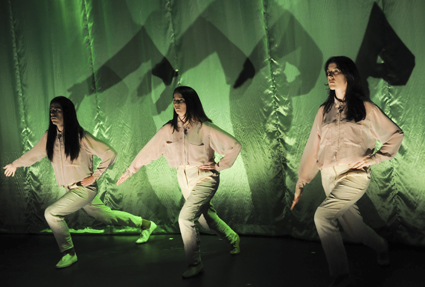
Eden Falk, Zoe Coombs Marr, Mish Grigor, Who’s the Best?
TWO PRODUCTIONS WITH COMPLETELY DIFFERENT PERFORMATIVE IDIOMS FOCUS ON THE PREVALENT ETHOS OF SELF-CENTREDNESS IN CONTEMPORARY SOCIETY WITH SATIRICAL VIGOUR AND RAW HUMOUR. NEOLIBERALISM’S NEO-DARWINIST RALLYING CALL, GORDON GECKO’S “GREED IS GOOD” (WALL STREET, 1987), REMAINS LARGELY UNDISCREDITED DESPITE THE LESSONS OF THE GFC, SO EMBEDDED IS THE ETHOS OF SELFISHNESS IN EVERYTHING FROM TV ADVERTISEMENTS WHERE PEOPLE PINCH FOOD, BOYFRIENDS AND CARS FROM FAMILY OR FRIENDS, TO REALITY TV’S CRUDE AND CRUEL ELEVATION OF SOLE SURVIVAL OVER COOPERATION, TO THE PERSONAL PRONOUN-ISM OF SELFHOOD INITIATED BY MYSPACE AND CONFIRMED BY MYBUS, MYSCHOOL, IPHONE AND THEIR SUNDRY IMITATORS.
stc next stage: post, who’s the best?
I was seduced and wowed by Post’s infectiously delirious Who’s the Best?, commissioned by Sydney Theatre Company’s Wharf 2 Next Stages program. Once again Post raise daggy amateurism to sublime artform—and with more professional verve than ever (see RT101). This experiment to determine which of the three collaborators and friends is the best performer employs a range of tests from Dolly quizzes and Enneagram tests to talent assessments and rating who’s the ‘hottest.’ These are constantly complicated or sidetracked by hilariously mind bending battles of the Abbot and Costello “Who’s on first” variety over the semantics of labelling that frame the tests or even incidental everyday expressions. These are adroitly woven through the script, recurring as running gags and providing an immersive, accelerating pulse to the work.
The performers’ casual delivery (always played directly to the audience while they freely insult each other) yields intimacy and immediacy on a stage which wickedly threatens to subvert the show as curtains and lighting go about their own business regardless—inevitably thwarting attempts to be the ‘best.’ Trio member and co-devisor Natalie Rose, who has recently had a child, is replaced for the premiere season by a wigged Eden Falk who slips easily into the Post mode while bringing his own wide-eyed innocence to Who’s the Best? alongside the well-honed comic personae of Mish Grigor and Zoe Coombs Marr. What adds bite and fun to the show is the sense that the performers are playing themselves with quite a few home truths aimed at demolishing self-centredness despite the final, chanted declaration “we are the best!”
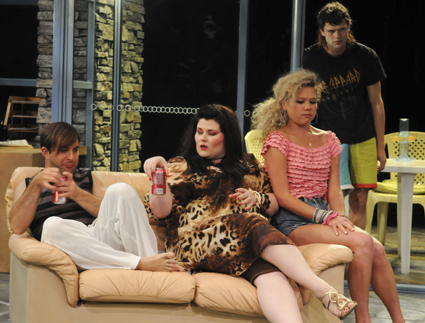
John Leary, Samantha Young, Jody Kennedy, Thomas Henning, The Business
photo Heidrun Löhr
John Leary, Samantha Young, Jody Kennedy, Thomas Henning, The Business
belvoir: the business
Belvoir’s production of Jonathan Gavin’s bitterly funny The Business is set in the 1980s, the very period in which the ‘greed is good’ ethos was getting into its public stride—and we still march to its insistent step in 2011. The world of The Business feels quite like home.
Grossly self-obsessed behaviour is central to Gavin’s bitter-black comedy of bad manners and inheritance snatching, with director Cristabel Sved and costume designer Stephen Curtis wickedly ramping up the rude behaviour and appalling dress sense of the characters to the edge of grotesquerie, but somehow without losing the sense of these people as real, thwarted and, at times, oddly innocent and certainly pathetic—such is their tunnel-vision of the world.
Gavin and Sved took their cue for The Business from Russian writer Maxim Gorky’s grim, sometimes comic play Vassa Zheleznova, which premiered in 1911 and was later a favourite of Stalin who saw it many times, presumably enjoying the agonies of a bourgeois family in their act of self-destruction (and enforced changes to the play in 1935 to suit his tastes). Gavin’s play is based on Gorky’s; it is not an adaptation. But in both there is a shared, strong focus on the female characters.
In Gorky’s original, Vassa, wife to a shipping agent, Zheleznova, is relieved when her husband dies at the end of Act 1 as opposed to the wrenching, protracted and off-stage decline in Gavin’s play which ups the suspense and complications of the mother and her disaffected daughter’s machinations to secure the inheritance the household patriarch would have denied them. Zheleznova’s death is also a relief because the charge of raping a 12-year-old servant girl will now not go to court. Vassa battles on alone, corralling daughters and servants, bribing dockworkers and police and bickering with her estranged socialist daughter (torn between motherhood and the life of a revolutionary) over possession of the latter’s child. The pressure is such that Vassa dies at the play’s end, an exhausted manipulator. Gorky’s empathy for her is limited, but he makes it clear that as well as being a nasty bourgeois she is to varying degrees a victim, though always a fighter.
The Business’ 1980s family is immigrant in origin (no coffee, just a steady flow of tea), wealthy, the adult Australian-raised offspring and their spouses child-like and spoilt. The runaway daughter Anna (Kate Box) returns home, apparently more principled than the rest but, like her mother, Van (Sarah Peirse) embittered by her father’s mistreatment and ready to conspire with Van to seize the inheritance from the ne’er-do-well siblings who would promptly sell-off the family business.
The plays by Gorky and Gavin share the same spirited assault on the bourgeoisie—but what at first seems grimly frantic and comic slips into dispirited horror. Gorky’s Vassa demands that her husband suicide (he dies without resort to that but there is no grieving); Gavin’s Ronald (Van’s crippled second son; Thomas Henning) kills his wife’s lover Gary (Russell Kiefel) and the family dutifully manages the cover-up. Not least because the principal mother-daughter relationship is more nuanced and the two women win out, The Business comes off as more complex than Gorky’s Vassa Zheleznova. The Business might represent a victory for women but not necessarily for integrity or compassion, as if to say the legacy of the 80s is a greedy, self-serving culture, whose children live in luxury and surly disaffection, emasculated by their parents who completely control the business. In this world Van, unlike Vassa, must live on, the legacy doubtless intended for a daughter who will become like her mother, or already has.
If The Business is not strong on 80s Australian politics and culture (Belvoir’s Wild Duck, RT102, similarly kept its distance from contemporary social realities) the specificities of time and place are largely left to design (Victoria Lamb)—an aptly tackily furnished, expensive modernist home with Californian bungalow exposed stone walls, a lounge room replete with board games for children who will never grow up, and a sunny porch that becomes a site for unexpected violence. Costumes (Stephen Curtis) and hairstyling are comically acute, viciously accentuating character traits and some of the fashion follies of the period. Van’s power-dressed shoulders and daughter Anna’s great height pushed up by heels and hairstyle immediately suggest competing forces. The casual wear and pronounced body shapes of the other brattish siblings, Simon (John Leary) and Natalie (Samantha Young), amplify their laziness while the hunching, lank-haired, bare-chested wild-child Ronald (Henning) lurches about like a purposeless Iggy Popp. A persistent soundtrack of 80s pop ranging from the execrable to the arty further compounds the period sense. The family lives inside this bubble. The business is not loved—it’s simply what it means in terms of survival or sustained leisure.
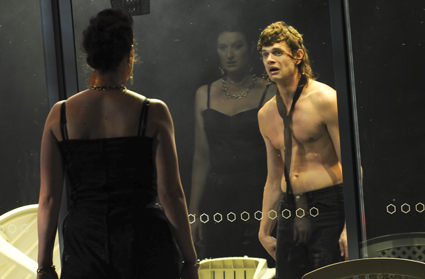
Kate Box in reflection and Thomas Henning, The Business
photo Heidrun Löhr
Kate Box in reflection and Thomas Henning, The Business
The one aspect of the family business that is focused on is a legal suit against it for the death of a worker who refused to wear a protective mask (“What is OH&S anyway?”). Van simply doesn’t want the company to accept responsibility—the victim was, after all, a chronic smoker. This is the world of The Business—a selfish society that doesn’t care enough for itself let alone others.
Inevitably, a limited range of concerns and character traits generates grotesques, utterly without empathy for the dying father (who clearly showed none to them) and locked in a bitter fight for an inheritance that Van has worked so hard for but that others simply feel they deserve. Emotions run to extremes but in Van we can see the fluctuating degrees of frustration, anger, near defeat and the need for reconciliation with Anna, even if it entails compromise. Van shows some compassion for the adulterous daughter-in-law Jennifer (Jody Kennedy)—even, as in Gorky’s original, working with her in the garden. The rest is misunderstanding, confusion, blindness and occasional insights that can’t be explored—Jennifer: “We’re all unhappy; none of us know how to love anything.” The best she can sadly come up with is: “I’m a human mix tape.” Van herself can barely live up to what she expects of her children: “These young people. ‘Duty,’ ‘consideration’—foreign concepts. I keep hoping one day they’ll grow up.” Her relationship with her husband is just as muddy: “So what? Maybe he was violent and drunk and yes he cheated on me, but it’s men like this who made this country what it is.”
What makes The Business potent is its emotional cruelty presented in the guise of comedy, sometimes bordering on farce, rich in gags (the business over a dead parrot, the nouveau riche ‘luxury’ of croissants stuffed with Fruit Loops), in explosive tensions and, not least, suspense (who will get the inheritance?)—and then shock. Director Cristabel Sved and her cast are endlessly inventive, keeping these monsters believable. If you were hoping for empathy and compassion and felt short changed then The Business was not for you—like Gorky’s original, this is tough social satire, even if Gavin is a tad more forgiving. And sometimes tougher: a communal sing-along in the Gorky is replaced with the dissolute Simon and Natalie’s faithful rendering of a ‘Tab Cola’ jingle, followed by Simon’s “Want a root?” It’s that kind of play, that kind of world. In the current political climate we’re hardly in a position to deny it.
Performances in The Business were uniformly excellent, underpinned by a strong sense of ensemble. Sarah Peirse’s Van rarely allows her bitterness to defeat her purpose or her anger to overrule the requisite moments of compassion or opportunism. Peirse plays out Van’s considerable contradictions without doubt or hesitancy. [Appraisal of the other performances can be found in the full review.] In working from Gorky’s Vassa Zheleznova, Jonathan Gavin has created a play that is his own, one finely realised by his collaborators and, sadly (if wickedly funny), a play for and of our times.
–
Post, Who’s the Best?, creator-performers Zoe Coombs Marr, Mish Grigor, Eden Falk, devisor Natalie Rose, lighting Matthew Marshall, consultants Emma Saunders, Hallie Shellam, Clare Grant; Wharf 2, Sydney Theatre Company, Next stage 2011, June 17-July 2; Belvoir: The Business, writer Jonathan Gavin, based on Maxim Gorky’s Vassa Zheleznova, director Cristabel Sved, performers Kate Box, Grant Dodwell, Thomas Henning, Jody Kennedy, Russell Kiefel, John Leary, Sarah Pierse, Samantha Young, set design Victoria Lamb, costumes Stephen Curtis, lighting Verity Hampson, composer/sound Max Lyandvert; Belvoir St Theatre, Sydney, April 27-May 29
Because of illness, the writer’s reviews of Belvoir’s The Seagull and PACT’s Bully Beef Stew will appear in RealTime 105, October-November.
RealTime issue #104 Aug-Sept 2011 pg. 18
© Keith Gallasch; for permission to reproduce apply to realtime@realtimearts.net
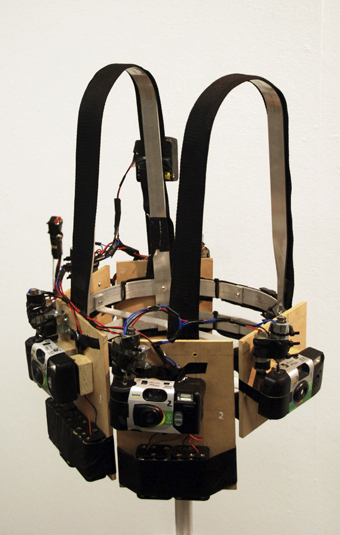
Alakazam, 2010 (detail), Adam Adelpour included in HATCHED National Graduate Show 2011, PICA
courtesy of the artist
Alakazam, 2010 (detail), Adam Adelpour included in HATCHED National Graduate Show 2011, PICA
Will artists tread ever so softly and self-censor under the weight of a growing number of protocols, impending new classification legislation and, not least for the training and education of young artists, the nervous reactions of university ethics committees? This is the Burning Issue in RealTime 104, aptly illustrated on this page by Adam Adelpour’s Alakazam. Adelpour is a student from Sydney College of the Arts [SCA], University of Sydney, one of the young artists selected for this year’s Hatched National Graduate Show at PICA. What at first glance looks like a bomb-cradling terrorist rig turns out to be a bizarre 360-degree surveillance device which the artist boldly activated, ie flashed, in the security-sensitive Sydney Opera House precinct. You can read a detailed account of the device and the action on the artist’s blog: adamadelpour.wordpress.com. The other dimension of our annual arts education feature is a survey of Australian content in university curricula and syllabuses. It’s quite revealing, indicating a passionate desire to bring together students and local artists, to attempt to make national connections and to find Australia’s place in a global art context. The ideal consistently appears to be a desire to bring these three dimensions together, avoiding ghettoisation and imbuing students with a sense of history (not least of recent contemporary art practices) and the greater world to which they as artists will contribute.
RealTime issue #104 Aug-Sept 2011 pg. 2
© RealTime ; for permission to reproduce apply to realtime@realtimearts.net
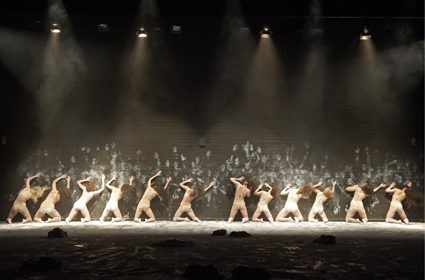
Over and Out, 2010, LINK Dance Company, WAAPA
photo Jon Green
Over and Out, 2010, LINK Dance Company, WAAPA
SCAN THE LANDSCAPE OF AUSTRALIAN TERTIARY DANCE COURSES FOR EVIDENCE OF “AUSTRALIAN CONTENT” AND IMMEDIATELY WHAT IS REVEALED IS THAT ITS INCLUSION IS FAR LESS ABOUT PRIORITISING A PARTICULAR AMOUNT IN ORDER TO SATISFY A PERCENTAGE OF NATIONAL INTEREST, BUT IS FAR MORE ABOUT THE PARTICULAR VALUES THAT DIFFERENT COURSES ASCRIBE TO AUSTRALIAN DANCE AS AN ARTFORM.
An important priority within curricula, Australian dance content is defined by various combinations of acknowledgment and celebration of Australian dance works; cultivating an understanding of a lineage of dance artists who have contributed to the development of what we see as current Australian contemporary dance; of utilising and maximising the expertise of current dance artists and transferring those benefits to the students; and possibly of patriotic or nationalistic pride.
working from the local
Dr Sally Gardner, Lecturer in the School of Communication and Creative Arts at Deakin University, says that upon starting their undergraduate degree many dance students “have little knowledge of contemporary dance art either locally or globally, currently or historically.” Given that this is their starting point she asks “why invoke the nation?” suggesting that “perhaps it would be better to think in terms of the local. Making connections with or referring to local dancers has a pragmatic, potentially vocational value.” At Melbourne University’s Victorian College of the Arts (VCA) a strategy to feature the work of Australian dance artists both in performance and in the curriculum has been pursued over the past 10 years. This integrated approach to dance education and training aims for VCA students to become conversant with the work of Australian choreographers and dance companies in a variety of contexts at and beyond the VCA.
A combined pragmatic and referential approach comes from Michael Whaites, Artistic Director of Western Australian Academy of Performing Arts’ (WAAPA) postgraduate pre-professional program LINK. Providing networking and employment opportunities are highlighted goals and the choice of national dance artists and companies is geared towards assisting the graduates from LINK to gain work within the profession: “Australian dance artists are very important…helping the students connect to the landscape and east coast, and helping to familiarise them intimately with some of the current people working in the industry.”
dance artists as teachers
Australian tertiary dance courses value and employ currently practising Australian artists as teachers for their currency of knowledge, their particular artistic practices and the professional networking information and opportunities that can benefit their students. Deakin University’s dance course includes comprehensive representation of local dance artists throughout the many aspects of students’ studies including as teachers, occasional additional visits by guest dancers, unit readings, reference or mention during technique, composition or other workshops and announcements on unit website pages.
The VCA’s current focus on Australian work is described by Associate Professor Jenny Kinder, VCA Dance Undergraduate Coordinator, as “underpinned by the involvement of practising dance artists in curriculum delivery. Participation by practising artists in three of six subjects on offer represents significant exposure to Australian work and practices.”
resource: god bless youtube
At Macquarie University Dr Pauline Manley, Lecturer in Dance Studies, says that Australian dance content is comprehensively included within the Macquarie dance course, “ranging from watching artists on YouTube to setting research tasks to seek out and attend live performances in unfamiliar venues and settings.” The inclusion of Australian content is considered vital in providing students with information about the content and location of what is currently occurring in the Australian dance environment and she praises the ability to access it via the internet: “God bless YouTube and the artists who release their work for the world to see. Thanks to YouTube we can watch Australian contact improvisation, performance artists, improvisations, contemporary dance …”
While Pauline Manley applauds YouTube, Dr Erin Brannigan, Lecturer in Dance at the University of NSW places the onus of releasing more Australian dance information into the wider public domain on the works’ creators. Although documentation of dance exists she says “it is very difficult to obtain. Choreographers and dance companies need to take responsibility for this.”
resource: dance as written word
It is generally agreed that currently there isn’t a broad enough body of written text and reference material regarding Australian dance, although resources in areas such as dance film are increasing. Performing arts journals, magazines and publications such as Brolga, the Writings on Dance archive, RealTime and the RealTimeDance portal are quoted as valuable sources of written material, although in total they are few. Key resources that relate to Australian dance are available in other formats—some in the form of living, practising senior artists. Jenny Kinder makes the point that “the issue is not access to information but whether Australian researchers will capitalise on existing primary sources and documents (such as the National Library’s Oral Histories) to produce the kind of dance texts and documentation that have emerged from the United States, Britain, Europe and more recently Asia.”
networks & shared learning
Another challenge is getting students to access information and material about dance artists and practices that occurred before the digitised age, and not to confuse accessibility of information with ease of access to information or the only available information. However, consideration does need to be given to how the current generation of students consumes information, says Associate Professor Cheryl Stock from Queensland University of Technology’s Creative Industries and former dancer, choreographer and artistic director. By students sharing information via blogs, YouTube and social networks, she observes that teaching and learning processes have changed to incorporate more dynamic peer-to-peer exchanges of information: “It’s about the conversations that are being held in whichever format they’re occurring. This has many advantages in engaging students and providing access to work that cannot be seen live but it does not replace the experiential. Learning about dance and learning through dancing provide an essential praxis of theory and practice.”
embodied learning
Critically, dance students need to understand that some information can only be accessed by direct interaction with practising artists. Cheryl Stock says that “to acquire deep knowledge of dance, students need to be in the studio often to directly engage with their learning for a more complete understanding of the ideas they access—and most importantly, that information becomes EMBODIED; it is a type of knowledge that is experienced and transferred personally and these kinaesthetic understandings cannot be acquired through digital platforms. Students need to engage with our contemporary artists and their ideas on a number of levels and where at all possible learn directly from them through classes, secondments and choreographic opportunities.”
learning lineage
Acknowledgement of the history and legacy of Australian dance is the aspect of Australian dance content unanimously considered of utmost importance and relevance for today’s dance students. The knowledge of national and international dance practices and histories is symbiotic and provides a perspective of how Australian dance and seminal Australian dance artists developed, progressed and impacted on current generations of Australian dance artists within local and global contexts. Cheryl Stock says that “there is a tendency for many students to think that various (contemporary dance) practices are new. They need to have access to the lineage of dance artists that have contributed to what exists now. And we also need dance scholars to write those histories.”
In 2012 the VCA will introduce a new subject Dance Lineages which will focus on the development of contemporary dance in Australia in order to contextualise the international contemporary dance trends and influences studied. Jenny Kinder underscores the value that it will be “acknowledged through the prism of Australian dance artists and their various overseas encounters”. Macquarie Dance also shares this view and has a research project underway to establish an audio-visual database of Australian dancing from the 1960s to the present day.
While the principle of prioritising Australia’s dance heritage is a shared theme, the selection of artists focused on reflects each course’s specific aesthetic values, geographical location and the individual experiences of staff. The artists highlighted by different tertiary dance courses and the reasons for their inclusion and prioritisation, are therefore important indicators of the particular character, artistic approaches and aesthetics of the course and what it can offer.
thinking globally, dancing locally
On the issue of inclusion of Australian dance content in tertiary dance courses there is an overarching agreement that it is a fundamental necessity for dance students to experience information and dance work that is excellent and which reaches beyond national definitions, histories and borders; but to be able do this their perspective must be informed by knowledge that is local in order to understand and appreciate the global.
As Cheryl Stock comments: “We live and work in a global world but we need to foreground past and current Australian dance practices and histories for an appreciation and understanding of how what is happening now came to be and why. That is, we need to contextualise the information historically and with an understanding of how the different genres have developed. Australian contemporary dance—and indeed all contemporary dance—didn’t just happen.”
additional resources
The Australian National Library’s Australia Dancing (www.australiadancing.org); Alan Brissenden and Keith Glennon’s Australia Dances, Creating Australian Dance 1945-1965, Wakefield Press, Adelaide, 2010 (RT 100); and Erin Brannigan’s Platform Paper for Currency House, Moving Across Disciplines: Dance in the 21st Century, 2010. Ausdance National and Routledge’s book on Australian dance with interviews and articles by and with Australian dance artists, academics and critics is due for publication in 2011. The Australian company Contemporary Arts Media’s Artfilms provides DVDs (at individual, educational and other institutional rates) of Bangarra Dance Theatre, Lucy Guerin Co. and Chunky Move (www.artfilms.com.au). Erin Brannigan and RealTime are editing a collection of essays and interviews on specific works by 12 Australian choreographers for publication in 2012 (the choreographers are profiled with articles and video clips in RealTimeDance: www.realtimearts.net/realtimedance). Eds.
RealTime issue #104 Aug-Sept 2011 pg. 3
© Linda Sastradipradja; for permission to reproduce apply to realtime@realtimearts.net
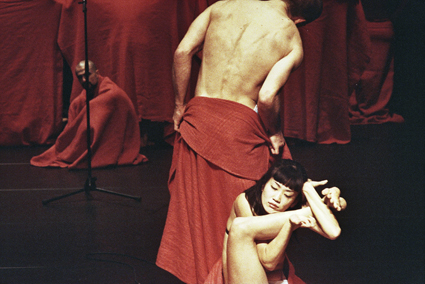
For Pina, les ballets C de la B
photo Chris Van der Burght
For Pina, les ballets C de la B
FORMER SYDNEY OPERA HOUSE HEAD OF THEATRE AND DANCE, AND SPRING DANCE CURATOR, WENDY MARTIN IS NOW HEAD OF PERFORMANCE AND DANCE AT LONDON’S SOUTHBANK CENTRE WHERE SHE SAYS SHE’S ADJUSTING AFTER SEVERAL MONTHS TO A NEW WAY OF LIFE, INCLUDING ENCOUNTERING MORE DANCE THAN SHE’S EVER SEEN. SHE’S PARTICULARLY PROUD OF THIS HER THIRD SPRING DANCE FOR THE SYDNEY OPERA HOUSE, A PROGRAM OF DISTINCTIVE INTERNATIONAL WORKS AND, FROM AUSTRALIA, ROS WARBY’S MONUMENTAL AND CHUNKY MOVE’S I LIKE THIS.
dv8: can we talk about this?
Martin describes Lloyd Newson’s new work, Can we talk about this?—with its international premiere in Spring Dance—as fusing dance and verbatim theatre to deal with the issues that arise from the 1989 fatwah placed on Salman Rushdie, the threats to the life of a Danish cartoonist for his representation of Muhammad, and the murder of Theo Van Gogh for his criticisms of Islamic culture. It seems that the work will focus particularly on the oppression of women and children in a work rich in interview-based dialogue and inventive choreography. Martin reveals that the cost of presenting Can we talk about this? “was almost beyond us, but the Opera House made the commitment.” She was intrigued that the work was co-produced (with European partners) by The National Theatre of Great Britain “rather than with London’s Sadlers Wells.” This is further evidence that there are works and audiences that crossover and hybridise, as in the programming in Australia of works by Lucy Guerin in Malthouse and Belvoir subscription seasons. Given its subject matter and, apparently, the manner in which it’s played direct to its audience, Can we talk about this? is bound to be as provocative as it is inventive.
les ballets c de la b: out of context, for pina
Coming close on the heels of the sell-out screening of Wim Wenders’ 3D film tribute to the late Pina Bausch at the Sydney Opera House, comes Alain Platel’s tribute. Like DV8’s Lloyd Newson, says Martin, Platel believes that without Bausch his own work would not exist. Platel was taken by the way that Bausch’s creations would “step out of the everyday” and give so much creative responsibility to her dancers (among whom have been a number of Australians). Platel’s tribute pays homage to Bausch’s unique approach but, says Martin, uses the popular music and dance moves of our own time, as well as Bach, to make the connection with his own work for les ballets C de la B. Jana Perkovic wrote, on seeing For Pina at Sadler’s Wells in 2010: “The piece defies description by virtue of sheer over-accumulation: 90 minutes of startlingly original movement with virtually no repetition, on nine different physiques that, even when amassed into synchronicity, preserve individual differences…Not having any narrative frame allows the audience to experience this decontextualised mass of movement on the level of affect, not cognition, free-associating stage images to deep memories. The result is emotionally penetrating and deliriously enjoyable.” (RT98)
pina: a celebration
Further acknowledgment of the Bausch legacy comes on screen over two days in the form of Anne Linsel’s Pina Bausch, a film, and Linsel and Rainer Hoffman’s documentary about the creation of one of the greatest of the choreographer’s works, Kontakthof. (The program will also include Life in Movement, the documentary about the late Tanja Liedtke.) Speakers in the accompanying discussions about Bausch will include Meryl Tankard, Michael Whaites, Kate Champion, Shaun Parker and Lutz Forester who all performed with Bausch’s company.
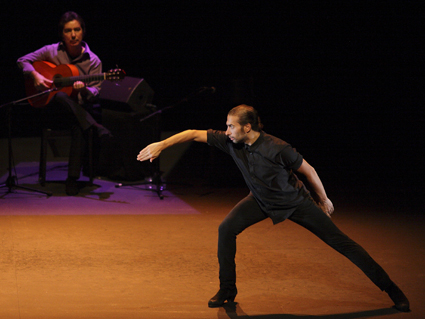
Israel Galván
photo Felix Vazquez
Israel Galván
israel galván: la edad de oro
When at the Lyon Biennale de Danse in 2007, I saw a gypsy flamenco ensemble perform, unadorned by frills and garish lighting, it was one of those revelatory experiences that put you in touch again with a form that had come to mean little. Martin has seen three works over the years by Israel Galván, a “flamenco revisionist” who brings together traditional form with contemporary dance. In Rome she witnessed him “dance barefoot, kicking up whirls of white dust while accompanied by a pianist.” She was also intrigued by the way “he blurred the masculine and feminine in his form” and accentuated the shape of his dance by largely performing in profile so that every movement detail could be relished. RealTime contributor Erin Brannigan told me she thought Galván’s performance in this year’s Montepellier Danse the best in the program.
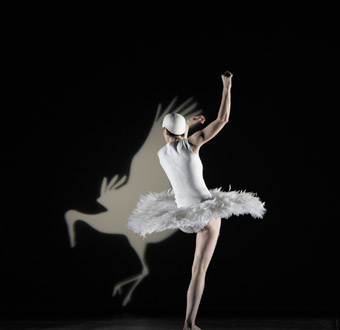
Ros Warby, Monumental
photo Jeff Busby
Ros Warby, Monumental
ros warby: monumental
Although previously enjoyed by Sydney dance audiences courtesy of Performance Space at CarriageWorks in 2009, Martin hopes that Warby’s Spring Dance presentation of Monumental will bring her the much larger audience this truly idiosyncratic Australian dancer deserves. There’s much about Warby to be found in RealTimeDance, including my review of Monumental (RT90). I wrote (and it’s not an easy work to put into words, believe me): “The anti-gravitational appeal of dance is, of course, like our dream of flight and winged selves, but here the embodied connection goes deeper. The audience become birdwatchers who, by way of Warby-Medlin [film]-Mountford [cello] alchemy, suddenly sense not only the dancer’s ‘birdness,’ but also their own, and, as they cast their minds back to Monumental’s opening image, the birdness (and not just of swans) of ballet.” Monumental is visually magical, sometimes funny and has some very interesting things to say about dance…and nature.”
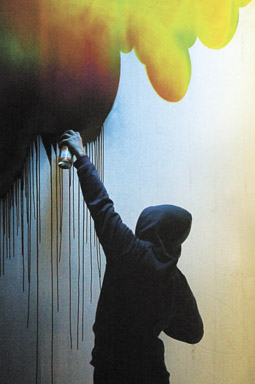
Blazeblue Oneline
photo Byron Perry
Blazeblue Oneline
chunky move: antony hamilton & byron perry’s i like this
Dancers Antony Hamilton and Byron Perry have contributed significantly to the works of Melbourne choreographers, so it’s wonderful to see them step out as a duo with their own creation about the magic of ‘thingness’ as they manipulate themselves and objects about the stage. RealTime reviewer Carl Nilsson-Polias had been impressed with Hamilton’s Blazeblue Online (RT85); he noted “a subtle recurrence of two-dimensional objects, such as cardboard, being given three-dimensional life and movement by the dancers. It is as though the flatness of visual art’s canvas is itself being reconstructed and reconfigured into the dynamic physical nature of dance.” John Bailey wrote of I Like This: “[Perry and Hamilton’s] visual design for the work deserves particular mention, becoming a character almost in itself, with hundreds of perfectly executed changes whose sometimes stroboscopic effect makes lighting operation appear a form of choreography in its own right. It’s self-reflexive dance, certainly, but by incorporating technology in such a sophisticated way it becomes something much more…the result approaches the sublime” (RT89). You can read Sophie Travers’ interview with Antony Hamilton in RT93. For Wendy Martin, I Like This is indicative of the work of a new generation of Australian choreographers, in this case designing, making and controlling an environment before us.
fevered sleep: the forest
UK group Fevered Sleep’s The Forest became part of the Spring Dance program, says Martin, on the recommendation of Brisbane Festival artistic director Noel Jordan. Aimed at young people and families in particular, but not at all exclusively, this maze-like, glass and mirror installation brings together dance, sound and light to create what Martin describes as “interactive dance theatre.”
placing spring dance
The contrast between Melbourne’s Dance Massive and Sydney’s Spring Dance is palpable given the largely national content of the former and the international purview of the latter. Martin is impressed by Dance Massive and sees the two dance events as equally important. Part of her inspiration for Spring Dance came from witnessing large-scale dance events in Germany in 2007-08 “with so much audience and performance engagement, so much conversation—a story going beyond one show—and asking huge audiences to take risks.” A single show at the Opera House might draw 1,500-2,500 ticket sales, she says—unless it’s Akram Kahn pulling 6,000 or so sales. But the 2010 Spring Dance attracted 20,000 people including 13,500 ticket buyers. Martin believes that Spring Dance is a sustainable model for audience development. It’s certainly what Australian dance needs. Of course, should Spring Dance continue now that Wendy Martin has left the Opera House, the event could be what Sydney dance artists also consistently need, greater exposure to local audiences in an international context as enjoyed by the Spring Dance production of Meryl Tankard’s The Oracle in 2009 and Narelle Benjamin’s In Glass in 2010.
–
Spring Dance, curator Wendy Martin, Sydney Opera House, Aug 23-Sept 4
RealTime issue #104 Aug-Sept 2011 pg. 4
© Keith Gallasch; for permission to reproduce apply to realtime@realtimearts.net
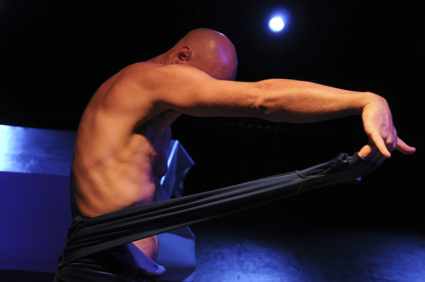
Dean Walsh, Fathom
photo Heidrun Löhr
Dean Walsh, Fathom
LAST YEAR, INDEPENDENT CHOREOGRAPHER DEAN WALSH WAS AWARDED AN AUSTRALIA COUNCIL FELLOWSHIP. THE TIMING COULDN’T HAVE BEEN BETTER. THE AWARD PRACTICALLY COINCIDED WITH WALSH’S 20-YEAR ANNIVERSARY AS A PERFORMANCE MAKER. ACHIEVING PROFESSIONAL LONGEVITY IS NO SMALL FEAT FOR AN INDEPENDENT ARTIST. TO BE OFFICIALLY RECOGNISED FOR IT IS ALL THE SWEETER. AND AS THE FELLOWSHIP ALLOWS WALSH TO FURTHER RESEARCH AND DEVELOP HIS CHOREOGRAPHIC PRACTICE, IT ALSO PROVIDES A TIMELY OPPORTUNITY TO TAKE STOCK.
So, how did it all start? Walsh recalls: “I presented my first piece at Performance Space’s Open Season. That was in June 1991. It was a group piece with eleven dancers. I was performing as well.” Walsh is under no illusions about the quality of the work: “Transcendent Nights, it was called. It was very ‘dancey’. I was just out of dance school. Naïve, you know.” The work didn’t go unnoticed however. Walsh laughs: “Sarah Miller [then director of Performance Space] pulled me aside afterwards and said: Come back with a solo next year. I think you’ve got more to say.” And sure enough, Walsh followed her advice. He became, in fact, something of a regular at Performance Space’s short works nights over the next few years – first at Open Season, then, from 1995, at queer cabaret programs such as cLUB bENT and Taboo Parlour. It was here he excelled with highly physical dance performances, exemplifying the spirit of nineties queer politics. The works were often inspired by Walsh’s personal experiences of homophobia and domestic violence—artistic manifestations of standing up for himself.
Around that time, in addition to his pursuits as a solo artist, Walsh also became a sought after performer in works by leading directors and choreographers such as Nikki Heywood, Nigel Kellaway and Garry Stewart. In 2002 he was awarded a Robert Helpmann Scholarship and left Australia to work with Paul Selwyn Norton and Company in Amsterdam and DV8 Physical Theatre in London. Upon his return three years later, Walsh’s choreographic interest had shifted away from the solo format towards choreographing group works. His first ensemble piece, Back From Front, premiered at Performance Space in 2008. Since then Walsh’s work has undergone a continuous evolution both in content and form.
This brings us to Walsh’s Fellowship and the program of activities he has proposed to undertake in the next two years. Walsh: “One of the leading questions for me is: What is the body of the history of my practice and how can I distil it into a system that I feel has integrity in terms of where I want to take my practice now, which is into a whole new content base, I guess, reflecting on the notion of environment, habitat destruction, genetic memory, our social connection and disconnection to the idea of climate change and major social human change.”
The first major thematic shift in Walsh’s work occurred when transitioning from creating solos to making group pieces. Looking at the long-term impact of wartime experience on soldiers and their families, “Back From Front was kind of like the bigger version of everything my solos were,” says Walsh. It was me going away from my own family to listen to other families and other histories but it was still the older way of working. And it was still an earlier concern in terms of domestic violence and where it comes from.”
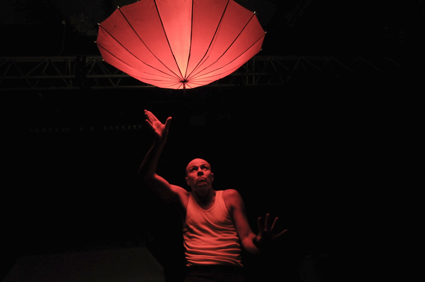
Dean Walsh, Fathom
photo Heidrun Löhr
Dean Walsh, Fathom
Now with environmental change and extinction issues increasingly the target of his thematic exploration, Walsh’s focus is currently on research into marine habitats and their bio-diversity. He cites taking up scuba diving in 2008 as the event that kick-started his new found interest. It exposed him, he says, to a previously unknown world and ignited a passion that soon resulted in genuine concern for the future of marine habitats and the survival of marine species, to a point where he seriously considered giving up dance: “I could almost give up art to move into conservation,” he says. And then, after a pause: “But I don’t want to. I’m really interested in how to take my dance practice into this new fascination I have with the need to conserve our marine bio-diversity.”
In addition to the exploration of new thematic and conceptual content, a large section of Walsh’s fellowship is dedicated to the choreographic scoring system he has been developing over the last years. It is called Foreign Language, complete with a “grammar” of its own and rules that distinguish it from any other physio-linguistic systems. Walsh explains: “The system is made up of five primary scores that divide into various sub-scores which then further break down into a series of modulations.” Could we have an example? “One of the primary scores is animality,” he says. “The sub-scores are various vertebrate and invertebrate animals. The cephalopods [octopuses, squids], for example, are among them.” What about the modulations? “The modulations relate to the specific physical and textural qualities of a certain species. In the case of the cephalopods, it’s their alacrity. Apart from a soft cartilage skull and a beak, they practically consist entirely of muscle.”
And how is the system used to choreographic purposes, how does it operate in action? “The various scores, sub-scores and modulations can be fused with each other, creating near-infinite possibilities.” Further complexity is added by the fact that some of the animality scores are anatomically impossible to execute for humans. “Some interesting movement gets produced that way,” says Walsh. An example would be one of the cephalopod modules, which is inspired by the Pacific Red Octopus’ ability to fit through spaces a tenth of their size by executing two complex physiological manoeuvres simultaneously—reducing muscular density while extending forward.
Walsh’s Fellowship is primarily dedicated to choreographic and conceptual research, both experiential and practical as well as theoretical. Apart from engaging in studio-based activities, he also regularly attends seminars, lectures and conferences and consults with marine biologists and conservationists. In order to try out some of his ideas in front of an audience, Walsh further conducts work-in-progress showings and recently presented the first instalment, in a series of what he calls ‘touch-down performances’. Entitled Fathom, the event took place in Track 8 at CarriageWorks. Walsh found the experience invaluable: “It gave me the opportunity to interface with an audience and get their feedback. That definitely upped the ante and got me away from the loneliness in the studio. It also helped me to become clearer. I had to put it out there to understand what it is I’m doing. I’m a physical realiser.”
So far Dean Walsh has completed a quarter of the program he is scheduled to undertake as part of his Fellowship. His passion for the project is palpable and his eloquence in describing its various components impressive. And yet, there is a sense that the ambition and sheer scale of his undertaking has just started to dawn on him. Walsh readily admits that at times he finds it rather overwhelming. Tongue in cheek, he states: “I feel like I have a whole ecology of ideas that will last me 10 or more years. I just can’t scope it all yet and I do feel like, I’m not drowning by any means, it’s absolutely not that. In fact, I’m breathing under water but the water is just so immense, I can’t scope it all.”
RealTime issue #104 Aug-Sept 2011 pg. 6
© Martin del Amo; for permission to reproduce apply to realtime@realtimearts.net
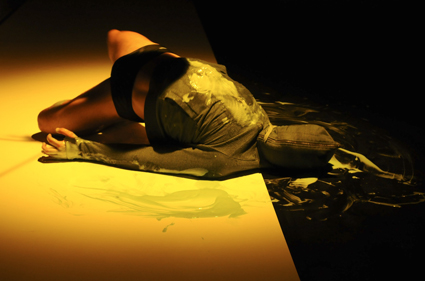
Dean Walsh, Fathom
photo Heidrun Löhr
Dean Walsh, Fathom
DEAN WALSH HOLDS THE AUSTRALIA COUNCIL DANCE FELLOWSHIP FOR 2011-2012, HIS ARTISTIC TENACITY REWARDED WITH INSTITUTIONAL SUPPORT. IN WALSH’S OWN WORDS, FATHOM IS AN EXPERIMENT AND A SMORGASBORD OF IDEAS: A REFLECTIVE MOMENT IN A TWO-YEAR PROCESS.
Walsh is an artist with important things to say. Dance can have a timid political voice but in Fathom Walsh seeks to connect movement theatre with the wider world and a political hot potato: the health of our natural environment. The relationship is not always comfortable or even clear, but the motivations are intense and passionate.
The black box stage is strung with striped tape, cordoned off like a scene of violence. Hanging hooks hold bags of green liquid horror. Implicit in this pre-set image is the thematic destruction that feeds Fathom: “not only was the bush gone, but the entire creek and swimming hole had been filled in. In its place is street after street and house after identical house: suburbia. No gum trees in sight” (program note).
Sitting to one side is a yellow man in a large blue bucket. He has no face. He fishes as a watery soundscore floats. His fishing pole creates a gentle arc against the lines of striped tape. As he stands his upper back leans, curving like the fishing pole. He dips as sound flutters.
This opening scene is intensely aesthetic: shape, colour and line dominate action. While it does become more alive with movement, what remains resilient in Fathom is image. In a series of episodes that fluctuate in tone, intensity and personality, it is be colour, lighting, costume, screen and apparatus that provide the performative punch. In this way Fathom does not cast itself so much as movement theatre or a reflection of the underwater world, but as a series of aesthetic events.
Walsh sits in a spotlight, his hands cast the colour of lobster. He pulls at the featureless face of the masked fisherman, trying to breathe, gulping for air. He twists and pulls and strips away the yellow face. A nightmare vision, this stretchy striptease is impacting, but we are rushing on with no time to linger on matters of strangulating angst.
Liquid lounge music elicits a more fluid dance. Walsh’s body has a signature written in his open joints, raised chest and extreme flexibility. Blown by undercurrents, his soft release is pleasure felt and pleasure communicated, but this oceanic movement moment is fleeting. He continues to strip away the costume. Fingers wave, wiggling his body into violent convulsions as his skin is lit lobster red again. An umbrella turns man into mollusc. He strips again. Silence and breathing become vocal snorts, rasps, sighs and grunts. Now in black he walks tortured down a white runway. He strips again.
Whale sounds herald a comic turn. As he searches for the lost beasts a baffling simian comedy briefly unfolds. He strips again. Now down to his underwear. Text moves down the screen, making this dense journey lecture-like: sometimes spelling out that which is not apparent, but sometimes too complex to grasp, sometimes interfering.
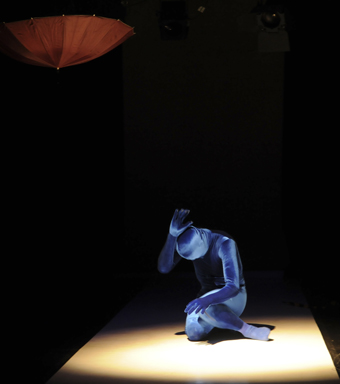
Dean Walsh, Fathom
photo Heidrun Löhr
Dean Walsh, Fathom
Driving trance music catches Walsh in a net before silence once more heralds a return to comedy. With a netted head atop a lurid green dress he dances a camply distorted ballet. I no longer know where I am. The screen image tells me I am at a beach polluted with plastic shopping bags. He caresses himself and strips again.
Colour again. Spinning bags of slimy sputum drip lines of gunk into artistic shapes on the floor. Underneath Walsh sits whimpering amongst the freshly fetid smell. He wails as he flails and slides to escape the glossy mess. He gasps into a surface made beautifully smooth, slides into glides made possible by oily ground. These lines of putrid green become luminescent. The stage is smeared with the muck of humanity and, from this defiled space, the performer leaves, opening a door of light, to enter a cleaner world.
Fathom is baffling. It is crowded with ideas and images: some patently clear, some obtuse. This must be forgiven in an ‘experiment.’ The aesthetics of light, colour and form are the work’s most vital assets. The choreography, only momentarily liquid, seems to reside outside the rhythms of the environment it seeks to embody, with the visual art emphasis yielding flatness rather than depth. But Fathom, in this incarnation, is definitely the promised smorgasbord of ideas.
Fathom, devisor, choreographer, performer Dean Walsh, advisor Paul Selwyn Norton, lighting Clytie Smith, costumes Rebecca Bethan Jones, sound editor Kingsley Reeve, video Martin Fox; Performance Space, Carriageworks, Sydney, May 19-22
RealTime issue #104 Aug-Sept 2011 pg. 7
© Pauline Manley; for permission to reproduce apply to realtime@realtimearts.net
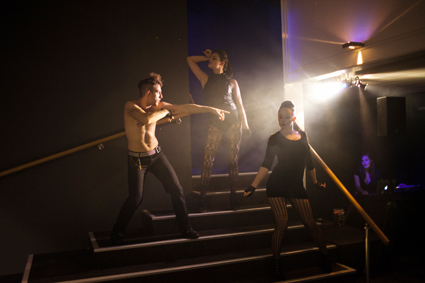
University of Queensland (Australian Drama) students perform Harvest by Manjula Padmanabhan
courtesy University of Queensland
University of Queensland (Australian Drama) students perform Harvest by Manjula Padmanabhan
AUSTRALIAN CONTENT IN THE CURRICULA AND SYLLABUSES OF COURSES IN AUSTRALIAN THEATRE HAS BEEN CONSIDERABLY ADVANTAGED BY THE AVAILABILITY OF PLAY SCRIPTS (THROUGH CURRENCY PRESS, ESPECIALLY, AND PLAYLAB) AND DISADVANTAGED BY THE ABSENCE OF A NATIONAL THEATRE MAGAZINE—LONG SOMETHING OF A MYSTERY. CONTEMPORARY PERFORMANCE AND CUTTING EDGE THEATRE HAVE BENEFITED FROM THE PRESENCE OF REALTIME SINCE 1994 (BUT FOR THE MOMENT ONLY ARCHIVED ONLINE 2001-PRESENT). THERE ARE KEY ONLINE SOURCES LIKE AUSSTAGE, SEVERAL SIGNIFICANT BLOGS (BY ALISON CROGGAN AND JAMES WAITES) AND JOURNALS AND, BEYOND THAT, EVERYWHERE I ASKED, A CONSIDERABLE HUNGER AMONG LECTURERS, RESEARCHERS AND STUDENTS FOR A MORE PALPABLE SENSE OF THE PERFORMING ARTS ACROSS THE NATION—IN WORD AND ON SCREEN.
Opportunities to see theatre and contemporary performance, both current and past, on DVD and online look set to improve, and that includes digital broadcasts to regional cinemas, as the Sydney Theatre Company did recently with Andrew Upton’s adaptation of Bulgakov’s The White Guard. Of course, the Australia Council and various State Government touring schemes have already improved access—a glance at Melbourne’s Arts House current program on our back page is a sure indication of improvement, with its inclusion of a number of Sydney-based artists. The rise of small, innovative live art festivals and the likes of Brisbane Festival’s Under the Radar program have yielded cross-border opportunities only dreamt of a decade ago. Accessibility on a variety of platforms is on the increase—so important for regional universities, but often no less so for students in our huge, sprawling cities with the added impediment of escalating ticket prices.
At the same time, it’s the face-to-face, body-to-body engagement between students and practising Australian artist lecturers and guest directors and teachers that is a top priority, of course more so in training than history or theory courses, but even there you will see increasing emphasis not only on seeing the work but also engaging with it, for example as observers, documenters, reporters and trainee dramaturgs (as in Performance Studies at the University of Sydney; see RT105). In both kinds of courses you’ll find opportunities offered for playwriting and group devising, so that students gain some sense of being ‘inside the artist’ as their own capacities and skills evolve.
For our 2011 survey, I’ve approached teachers (where available—it was that time of the year) from a range of schools and departments asking them where Australian work fits in their courses. Inevitably it’s regarded as important in itself but, more critically, in an international context—a mix of treasuring and exploiting the local scene, attempting to gauge a national perspective and finding our place in the global picture—mighty tasks but ones often tackled with verve and invention.
university of wollongong
Staff members (including practitioners Tim Maddock, Chris Ryan and Janys Hayes) in the Faculty of Creative Arts, University of Wollongong told me that students enrolled in both the Bachelor of Performance or in the Bachelor of Creative Arts (Theatre) “work with contemporary Australian performance practitioners to devise performance works, write and perform their own texts, as well as presenting productions by both Australian and international playwrights. There is a strong emphasis on contemporary Australian artists in both the practical and history/theory program. Students are encouraged to see festivals and site-specific performance, by both independent and major theatre companies, as well as live art, contemporary performance and post-dramatic theatre.” However, it is felt that “the lack of available performance and theatre documentation is an issue.” Keeping up with even recent work can be a challenge making it potentially “redundant, unless properly recorded and readily available.
“Our reading lists include a number of titles from the Rodopi Series on Australian theatre and performance, as well as Currency publications on Australian artists and practices. However, publications on playwrights dominate the field and significantly more DVD documentation is required. At present many recordings are limited to either personal collections or theatre company archives, and can be difficult or impossible to access. This impacts on the ability of staff to teach across a broader range of contemporary performance work. We address this issue predominately by engaging guest practitioners who teach strategies of contemporary performance by example. This intersects with the theory program, which studies the history of these artists and provides the opportunity for such artists to screen and discuss examples of their work.” Guest artists who have directed and/or devised work with students since 2007 include Geordie Brookman, Kate Gaul, Carlos Gomes, Regina Heilmann, Deborah Pollard and from Korea, Park Younghee.
university of ballarat
Ross Hall, Lecturer In Acting in the regional University of Ballarat says that its Arts Academy runs two practice-based Degree Programs one focusing on acting, the other on musical theatre. “Most of the art that’s created here is done so under the broad umbrella of pedagogy and intensive performance training. Over the past 10 or so years, we’ve performed Australian content on a fairly regular basis—mainly text-based works, covering many genres from full-length plays to new Australian musicals. We run scene classes on specifically Australian content—again, mainly contemporary plays. We also run devising strands in the early parts of our courses; [these] map developments in Australian drama and musicals [and can explore] pre-existing Australian stories in a dramatic way. Our students devise work that travels out into the community. We’ve taken part in the evolution of new work, co-producing these with freelance writers and artists. We’ve co-produced issue-based community theatre. We’ve commissioned new Australian works, both dramatic plays and musicals. We have visiting artists and current practitioners give lectures and workshops. We engage practicing directors to work on many of our performance projects.”
flinders university
Jonathan Bollen, Senior Lecturer in the Department of Drama, School of Humanities, Flinders University (and a regular contributor to RealTime), focuses on the fact that “students go on to become the colleagues and spectators of the artists they learn about at university, so it is crucial they learn about who is making work now.” He teaches a course titled Live Arts and Performance that introduces third year students to performance art, post-dramatic theatre and contemporary performance. “It focuses on selected artists and companies within an international field, and traces connections with recent developments and current practice in Australia. It is designed to equip students with the knowledge to navigate international arts festivals and the field of contemporary performance in Australia. The OzAsia Festival in Adelaide provides a focus for the study of intercultural performance in Australia.”
This placement of local performance in an international context is reflected in course structure: first year students focus on three contemporary Australian works in substantial detail; second years “studying the history of modern theatre learn about the New Wave, Australian Performing Group, Nimrod and the Black Theatre movement. At fourth year, I teach topics on Contemporary Australian Drama that explore the production history and dramaturgy of recent works from Australian playwrights, including Wesley Enoch, Jane Harrison, Andrew Bovell, Katherine Thomson, Hannie Rayson, Daniel Keene, Patricia Cornelius, Tom Holloway and Noelle Janaczewska. Australian plays from the 70s to the present are regularly produced as part of the department’s activities.”
Bollen would like to see “more books that focus on the work of particular Australian companies and artists—books that combine documentation of product and process, with analysis and critical reflections. It would be great to have books on Australian Dance Theatre, Bangarra, Back to Back, The Border Project, Chunky Move, Urban Theatre Projects, Version 1.0 and more. Performing the Unnameable (Currency Press with RealTime, 1999, editors Karen Pearlman and Richard Allen) was great when it was published. We need another collection on contemporary performance for the last decade.”
As for magazines and online publications, “RealTime is a crucial resource. I couldn’t teach Live Arts and Performance without it. It is required reading for students. It is the only resource that provides national coverage and international context for contemporary performance in Australia. The other online resources that are crucial for teaching are AusStage and AustLit. I also rely on the websites of companies and artists. The scholarly journals About Performance, Performance Paradigm and Australasian Drama Studies are valuable for in-depth studies, but their coverage is not so extensive.” A vital component of the department’s approach is that “four of the six permanent lecturers in Drama at Flinders are practising artists. Their work as artists forms a core part of their teaching. It is also visible to students in work on productions on campus.” In his reply to my queries, Bollen appended an extensive and impressive list of the websites for artists, companies, festivals and venues in Australia and around the world that are part of the syllabus for his Live Arts and Performance course.
university of queensland
Playwright Stephen Carleton is responsible for Australian Drama at the University of Queensland: “We offer an Australian Drama course that spans the entire 20th and early 21st century from Federation to the present.” The final weeks of the course focus on contemporary practice through a thematic approach, for example “Engagement with the Asia-Pacific Rim” is projected for 2012. “Additionally, we feature the work of Urban Theatre Projects in Sydney and Tracks Dance Theatre in Darwin within the ‘post-national theatre’ rubric of our Contemporary Theatre course…We also offer a third year course in Dramaturgy and Play Writing in which students learn contemporary dramaturgical practices and theory and apply this to each others’ new writing projects.”
“As a practicing playwright and convenor of the Drama Major,” writes Carleton, “I have a substantial investment in the centrality of an Australian focus in our program, and all staff at UQ Drama are committed to encouraging students to place the Australian cultural and industrial theatre experience in an historical and international theatre context. As well, UQ Drama produces Australian works one semester in every four. Most recently that has been work by Van Badham. We encourage students to experiment with the short plays they write in Dramaturgy and Playwriting in terms of form and content.These are frequently produced by the University’s theatre group Underground as part of their annual Bugfest Program.”
As for books, “we set Maryrose Casey’s Creating Frames, about Indigenous theatre practice, alongside broader Australian survey texts such as those by John McCallum and Geoffrey Milne as required reading.” A particular challenge, says Carleton, is the absence of “texts placing contemporary Australian theatre practice within an international context.” However, Carleton claims that “UQ Drama’s emphasis on Theatre Through Time and Space represents the most comprehensive canonical approach to Western European and International theatre (including Chinese, Indian and Pacific theatre traditions) from Antiquity to the Present of any tertiary theatre program in Australia. Placing contemporary Australian theatre practice within this broad spatial and temporal history is a central tenet of our approach.”
However, he adds, “It is incredibly difficult to get information about what’s happening in the regions and the capital cities beyond Sydney and Melbourne. A dedicated national theatre magazine would be a wonderful thing—a specialised theatre magazine that augments RealTime’s focus on multi-form and genred performance, dance, film review and analysis—that would be an excellent resource to have.” He is appreciative of AusStage and AustLit for providing increasing online documentation.
The observations made in Part 1 of this survey add up to a strongly felt need to be able to understand and teach Australian performance on its own terms but within the framework of the national and international perspectives that this country has struggled so long to attain. The work is there, books, journals, archives, new media tools, touring networks, but something’s missing or, better, something’s growing—but how well formed will it be for the performers and performance scholars of today and tomorrow?
Part 2 of this survey will appear in RealTime 105, October-November, and will include observations from Peter Eckersall, Associate Professor of Theatre Studies in the School of Culture and Communication, University of Melbourne; Laura Ginters, Lecturer in the Department of Performance Studies at the University of Sydney; Clare Grant Lecturer in the School English, Performing Arts and Media the University of New South Wales; and Helena Grehan, Senior Lecturer in the English and Creative Arts program at Murdoch University, Western Australia.
RealTime issue #104 Aug-Sept 2011 pg. 8
© Keith Gallasch; for permission to reproduce apply to realtime@realtimearts.net
{$slideshow} THE LAST CO-PRODUCTION BETWEEN QUEENSLAND THEATRE COMPANY AND BELL SHAKESPEARE I’D SEEN WAS HEINER MULLER’S ANATOMY TITUS FALL OF ROME: A SHAKESPEARE COMMENTARY WHICH WAS AN IMMENSELY POWERFUL, MEMORABLE AND RELEVANT PIECE OF CONTEMPORARY THEATRE, A BLOODY AND INESCAPABLE DISSECTION BY MICHAEL GOW AND JOHN BELL THROUGH THE LENS OF SHAKESPEARE AND MULLER OF THE COLLUSIVE NATURE OF CONTEMPORARY POWER AND VIOLENCE.
Their latest collaboration, Faustus, albeit providing solid, rambunctious entertainment that scarcely flagged, appeared at the outset to lack the same intensity of focus. There was ample scope, I thought, for this production to put itself more on the line. Instead what at first seemed to be a confusion of eclectic irony and disparate references was ultimately made clear in this new recounting of the legendary Faust, the scholar who sells his soul in exchange for knowledge of the universe and worldly powers.
The western world, especially as it presents the face of modernity, has long been characterised as Faustian, and non-westerners, from the most powerful to the poorest, appear to be ready to make any bargain with the devil to gain access to what is perceived as a cornucopia. This perception is taking us all to hell, or at least to a fiery end to the planet. And, leading us there, climate change sceptic Rupert Murdoch who in recent media appearances eerily resembles John Bell’s seedy portrayal of Mephistophilis as an Ocker small time, seen-it-all gangster. Bell’s was a peculiarly soulless portrayal, I thought, until the penny dropped…Mephistophilis has no soul.
Jonathon Oxlade’s set was living hell. That is to say, it grandly facilitated what in essence was a very racy production. The conceit was that its denizens were performing a show within a show, all for the mystification and damnation of Faustus. It harked back to travelling players, puppet shows, Piscator and the Weimar Republic, and used a plethora of means from documentary film footage (although this might have been updated to the 21st century) to tacky life-size mannequins as multiple framing devices. Musical references ranged from Mahler and Liszt to kraut rock. Part necessity, part Gow’s aesthetic choice, the acting style was hard, straightforward, unsentimental. Nevertheless, individuals shone through: Jason Klarwein as a Brian Ferry Lucifer, or hunched over disguised in a Richard Nixon mask; Vanessa Downing remorseless as Hecate; Catherine Terracini exhibiting the raunchy aplomb of a 1950s movie star as Beelzebub.
In his writer’s notes, Gow indicates that he has based his adaptation primarily on Christopher Marlowe’s Dr Faustus (at least, the lines regarded purely as Marlowe’s) and JW Goethe’s treatment of the same theme in his Urfaust that preceded Faust; the Tragedy Parts I and II. Gow points out that Marlowe’s collaborators padded out the drama with farcical knockabout, and Goethe introduced the story of the young girl Gretchen. The Marlowe version presented a series of ‘shows’ or plays within plays, so Gow decided to include the episode of Gretchen as another of these ‘shows.’
Even so, as movingly played by Ben Winspear and Kathryn Marquet, it is the most human episode in what otherwise might have seemed a relentlessly cynical piece, and speaks directly to Gow’s vision of love, love carnal and love exalted in the words of Marlowe’s own, The Passionate Shepherd to his Mistress. Throughout I warmed to Gow’s love of the English language of the period which performed a particularly nostalgic threnody at this juncture for our own lost innocence and experience, of the half-familiar, half remembered words from school poetry text books, addressed to the schoolgirl Gretchen. The revelation of the heat of Gretchen’s adolescent desire was searing and poignant and personal in this production. The outcome of this disproportionate love affair has Gretchen mistakenly poisoning her mother with a drug given to her by Faustus so they can meet at night. Faustus, much to the disgust of Mephistophilis, has genuinely fallen in love with Gretchen, but cannot save her from execution, nor does she want him to, putting her faith instead in the merciful nature of divine, not human, justice.
Writing in the 18th century when the conflict of science and faith was less literally incendiary than in the 16th, Goethe was free as a natural scientist as well as a poet to express his fellow-feeling for Faust’s ambition to unlock the secrets of the universe, and so in the end assigns him a less dastardly fate than the one designated him by Marlowe. For Goethe, the love of a good woman was Faust’s salvation. Faust: the Tragedy Part II, declares that, “The Eternal Feminine leads us on.” Marlowe’s Faustus tries to strike a bargain with God by promising to burn his books, only to be condemned for his double apostasy by God’s silence, and Faustus is dragged screaming to Hell. Gow for the 21st century interrupts the narrative precisely at the point where God is silent, the actors explaining that this has all been theatre, that Heaven and Hell are merely stage props, and condemning Faustus to the freedom of his own conscience as he makes a swift exit through an audience that now stands similarly condemned.
At first I spontaneously cheered a gesture that seemed politically apt in the light of the world-wide revival of rampant religious fundamentalism, and so in accord with Marlowe’s avowed atheism as if he were finally free to speak his mind. Over time, however, Gow’s interruption appeared richer, more resonant. In his Thesis on History, Walter Benjamin explains the power of dialectical thinking as opposed to historicism: “Thinking involves not only the flow of thoughts, but their arrest as well. When thinking suddenly stops in a configuration pregnant with tensions, it gives that configuration a shock.” In a highly pertinent essay, “Interruption and the Last Part,” Gabriel Josipovici points out that it was the ability to arrest thoughts that Benjamin cherished above all in the theatre of Brecht. Epic theatre, says Benjamin, breaks up the stream of continuity and allows us to see that events could be other than they are. If post modernism, so-called, has made a fetishism of interruption, the task of the modern artist, Josipovici concludes, is to make something that will catch both the power of continuity and at the same time, through interruption, to break its hold over us. On both counts, Michael Gow’s Faustus delivered.
Queensland Theatre Company and Bell Shakespeare: Faustus, after Doctor Faustus by Christopher Marlowe, adapted and directed by Michael Gow, writer, performers John Bell, Vanessa Downing, Jason Klarwein, Kathryn Marquet, Catherine Terracini, Ben Winspear, designer Jonathon Oxlade, lighting designer Jason Glenwright, composer Phil Slade; Brisbane Powerhouse Theatre, May 30 – June 25,
RealTime issue #104 Aug-Sept 2011 pg. 10
© Douglas Leonard; for permission to reproduce apply to realtime@realtimearts.net
{$slideshow} IN 2010 GEELONG’S BACK TO BACK THEATRE UNDERTOOK THREE INTERNATIONAL TOURS PERFORMING FOUR SEPARATE WORKS, HOLDING CREATIVE DEVELOPMENTS FOR ANOTHER FOUR ALONG THE WAY. YET ARTISTIC DIRECTOR BRUCE GLADWIN STILL DESCRIBES THE COMPANY AS A SMALL ONE. “IT’S NOT AS IF WE’RE OUT THERE MAKING A SEASON BROCHURE WHERE WE DO EIGHT SHOWS A YEAR. WE SPEND A LOT OF TIME HERE WHEN WE’RE NOT TOURING, MAKING NEW WORK OR DOING A COMMUNITY PROJECT IN GEELONG THAT DOESN’T HAVE A HUGE PROFILE.”
While the company may see itself as small, its immense strides in the Australian performance world can best be understood by contextualising its very existence. When touring abroad, the company has often been asked about the social and political climate that has allowed it to come into being. It may seem an odd question—in our liberal society, the emergence of an artist might seem the simple result of an individual’s desire. But a professional and highly regarded theatre company employing performers with disabilities isn’t the norm the world over. In the minds of those asking these questions, says Gladwin, “people with disabilities don’t exist within the cultural landscape of their own countries.”
In the 1980s Australia underwent a process of de-institutionalisation. Concerted efforts were made to provide people with disabilities stable roles within the wider community, with residential, employment and support options expanded. People with disabilities were afforded the opportunity to be more visibly engaged with other sectors of society. This hasn’t occurred everywhere. “In Austria,” says Gladwin, “until recently, they didn’t have to have a government policy dealing with people with disabilities in aged care—because at the end of World War II there weren’t any people with disabilities left.”
To mainstream audiences in Australia, Back to Back has emerged as a fully-fledged company producing complex and artfully realised works in the space of a few years. But such ‘overnight successes’ rarely occur overnight—the company has been operating since 1987, and its recent entry into the international spotlight is the culmination of decades of development and self-scrutiny. That a suite of productions—Soft, Small Metal Objects, Food Court—have enjoyed unwavering critical acclaim is an outcome of this carefully judged and quietly considered approach to the question of what the company wants to be.
At a festival in Spain many years ago, Gladwin saw a company of performers with disabilities from Portugal producing a farce. “Everyone said ‘you’ve got to see this company,’ and they were great, they were really amazing. But what they were performing was this traditional farce. You couldn’t watch it without thinking that in their own country they are performing this alongside other companies performing this type of material and they’re always going to just be this variation of that.”
what theatre can be
Back to Back isn’t interested in reproducing traditional forms of theatre. Rather, says Gladwin, the company “has always been about forging what we think theatre could be. We create our own stories.” “Theatre’s very empowering,” says ensemble member Scott Price. “Anyone with a disability can act, and people with disabilities need that empowerment.” Price became a full-time member of the company in 2008 and appeared in the disturbing Food Court, which premiered at the Melbourne International Arts Festival in 2009.
Performance can be empowering, but many people also find the prospect of exposing themselves to public attention a threatening one. “Do they?” asks Price. “I feel very comfortable in my own skin. I have been nervous occasionally but I’m generally really comfortable. Of course before opening night you’ll be shit-scared but as the shows go by I’m fine.” Though only 24, Price is the ensemble’s most vocal interrogator of the politics and ethics of representing disability in a theatrical environment. “Some of the moral and ethical standards I have,” he says, “well, I’m open to a lot of stuff but what I’m not open to is discrimination towards people with disabilities. Some language is pathetic.”
“Scott is the person in the company where if there was some representation of people with disabilities or if someone uses the word ‘retard’ or something, Scott will stand up and make a statement about it,” says Gladwin. “Well, for example, your use of the R-word,” says Price. “I just don’t think we should use that in a show.”
Back to Back is no stranger to controversy; indeed, the company’s works consciously challenge perceptions of disability, often turning the gaze of the audience back on itself. Soft featured a narrative in which a couple debate the termination of a pregnancy after the foetus is diagnosed with Down’s Syndrome, arguing that the child will never be able to secure proper education or decent employment. Food Court—a collaboration with improvisational jazz group The Necks—centred on a pair of bullies victimising a disabled woman, leading her to a gloomy forest and subjecting her to a barrage of physical and emotional abuse. That these scenarios are played out by performers who themselves might face such discrimination adds a profoundly unsettling edge to each production.
ganesh versus the third reich
The company’s next work is Ganesh Versus the Third Reich, appearing in this year’s Melbourne Festival. “In some ways this work is made in response to some of the feedback we had from Food Court,” says Gladwin. “Some of the questions we had were whether the actors were in charge of what they were doing, and who was the author of the work. How comfortable were the actors with what they were doing? In a way, making a work that’s about the making of a work gave us the vehicle to explore that.”
Again, Price has acted as the ethical barometer of the piece. “You know, you’re portraying Nazis and people were actually killed,” he points out. “This is something that should be discussed but, gee whiz.”
The way the company has handled the dilemma of representation is to incorporate these questions into the production itself. The work features two strands: one is an epic hero’s journey—the Hindu god Ganesh travelling through Nazi Germany to reclaim the mystical symbol of the swastika appropriated by Hitler. The other explores the frame of a theatre company attempting to explore the politics of such cultural appropriation by appropriating cultural symbols itself: “the actual makers of the work in moral and ethical conflict with each other over the making of the piece,” says Gladwin.
It’s impossible to say, yet, what the final performance will be. It’s an ambitious undertaking—a number of scenes are performed in German, and Ganesh features the largest amount of text the company has ever taken on. The work is both a costume drama and a post-dramatic exploration of theatremaking. But Back to Back’s mandate is one of risk-taking, and the incorporation of unexpected elements occurs not just throughout development but during productions themselves.
ensemble and authority
Back to Back is driven by its ensemble. In response to those who questioned the authority of its performers in Food Court, one anecdote may suffice. During the development of that production, one of its devisers and performers, Rita Halabarec, insisted on the inclusion of several monologues that others weren’t so sold on. “There was a lot of conflict between Rita and I in the making of that work, in terms of the editing of it,” says Gladwin. “What went in and what went out.
“She would exercise her authority as a writer in the performance. There were two points at which she would deliver a monologue that wasn’t in the script. It was an issue for us because all the language was projected as well as spoken. So after realising that we couldn’t stop her, we built a palette of phrases that we thought she was likely to say and the AV operator would have to look at a screen and try to click on what was said. I kind of liked that, and came to really love what she offered. It went against my judgement but in the end…I mean, we’ve got The Necks there who are these improvising jazz impresarios and she’s doing the same thing.”
Malthouse Theatre & Melbourne Festival: Back to Back Theatre, Ganesh versus the Third Reich, Merlyn Theatre, Malthouse, Sept 29-Oct 9; www.malthousetheatre.com.au; Melbourne Festival, Oct 6-22
Read reviews of other Back to Back productions in our Art & Disability Archive Highlight
RealTime issue #104 Aug-Sept 2011 pg. 12
© John Bailey; for permission to reproduce apply to realtime@realtimearts.net
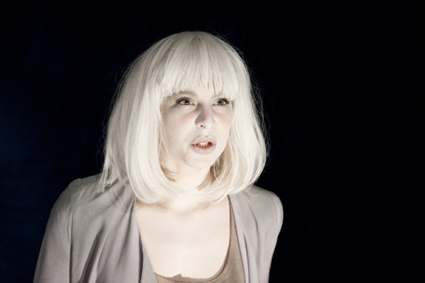
Cate Wolswinkel, J.A.T.O.
photo Sarah Walker
Cate Wolswinkel, J.A.T.O.
FOR SOME TIME AUSTRALIAN THEATRE HAS BEEN SUBJECT TO A SIMMERING YET PERSISTENT ANXIETY SURROUNDING THE FUTURE OF THE PLAYWRIGHT. THE ARGUMENT HAS BEEN REHASHED AGAIN AND AGAIN—THAT AN EMPHASIS ON COLLABORATIVE DEVISED WORKS, NON-TEXT-BASED PERFORMANCE AND CROSS-DISCIPLINARY HYBRIDITY DEVALUES THE ART AND CRAFT OF GOOD OL’ FASHIONED THEATRE WRITING. BUT FOR A GLISTERING MOMENT IN MELBOURNE RECENTLY, ALL DEBATE SEEMED QUELLED AS A RATHER ASTONISHING NUMBER OF NEW AUSTRALIAN WORKS PREMIERED ACROSS THE CITY. YOU COULD WITNESS A DIFFERENT PRODUCTION BY A LOCAL WRITER EVERY NIGHT OF THE WEEK AND STILL BE LEFT WITH MORE UNSEEN.
mka: for playwrights
One company heralding a writer’s renaissance is MKA, a fledgling enterprise whose emergence was anything but simple. Originally based in a converted warehouse apartment in Richmond, MKA’s inaugural season was delayed after the local council ordered the closure of the venue due to complaints from neighbours. An interim space was quickly found in the CBD where a series of 25 play readings introduced Melburnians to the company’s precis—theatremaking that focuses on the development and presentation of original works that put writing first. A third venue in Prahran was host to MKA’s first season proper, comprising four plays of radically different tone and genre, while no less than the Melbourne Theatre Company has come on board to present another short series of readings produced by the group.
The four productions that made up this primer were of varying success. Nathaniel Moncrieff’s Sleepyhead proved a less-than-stellar opener, in part due to missteps in the writing. Positioning itself as an entry in the Australian Gothic genre, it both gestured towards familiar tropes and well-worn themes while not quite grasping the innate ambivalences which underscore the gothic.
A pair of sisters live in a rural shack with a drunk dad grieving the loss of their mother. His benign admonitions, intended to protect them from the harsh realities of life, force them to seek out other ways of escaping this stifling existence, from fantasy and a patchwork spirituality to a dangerous encounter with a stranger who may or may not be a serial killer. Along the way, the ghost of their mother frequently drops by to ratchet up their sense of guilt a notch, while the recurring disappearance of local girls adds a sinister foreboding to proceedings.
Once these elements are assembled however, it’s not quite clear how they are to interact, or what we can really take from them. The standards of the genre are all there: the imperilled young girl, the monstrous male, the fusing of psychology and environment, the return of the repressed, the descent into hysteria. Yet it’s a passive engagement with these notions that eventually plays out, neither problematising their historical meanings nor tapping into their enduring appeal.
Of a radically different order is MKA’s follow-up, 22 Short Plays, which is so self-mocking as to amount to an ideal snapshot of postmodern theory in theatrical form. Delivering precisely what it promises—22 tiny comic vignettes, often a mere minute or two in length, ‘Plays’ may be a misnomer; there’s little approaching character or plot here. But as scenes that quickly establish a recognisable theatrical mode before immediately dismantling it, the production works. The undergraduate atmosphere doesn’t really detract, indeed seeming entirely appropriate to a production that steadfastly refuses to take anything—least of all itself—with any seriousness. There’s no subtext here, but there’s almost no sur-text either; scenes are over before they have the chance to develop into something that might approach a critical comment on, well, anything. It’s very funny and deliberately pointless.
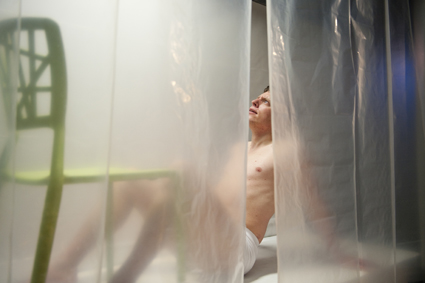
Matt Young, The Horror Face
photo Sarah Walker
Matt Young, The Horror Face
Somewhere between these two works is The Horror Face, a triptych of shorter works by MKA general manager Glyn Roberts. Though set in a dystopian future of clones and corporate control, the work doesn’t sit comfortably in strict science fiction mode. The scientists and company drones of each scenario are linked by the deadly spirit of a spectral lion; the significance of this is left teasingly open. Another return of the repressed, certainly, but is it the animal nature of the subjugated human or the vanquished spectre of nature itself? The other theme that connects the suite is that of the philosophical poverty of self-help and motivational speaking; again, there’s little direct statement made but plenty upon which to ruminate. The production itself suffered from some awkward staging, directing attention away from the writing’s more contemplative aspects, but it certainly came closer to matching MKA’s stated brief.
If The Horror Face hinted at the company’s promise, the final entry in its first season made good that vow. J.A.T.O. by Croatian writer Vedrana Klepica married marvellous design and strong performances brimming with intriguing possibility. A three-piece band arrive in Zagreb a tangle of mid-tour conflict and disappointment; a pair of half-hearted security guards are given the absurd task of protecting a politician’s decoy; a lonely woman drowning her sorrows searches for a man to fill her evening. Hovering around all of this is an imminent act of terrorism, though its exact nature is never quite certain.
Setting the action in an expansive sandpit makes for some wonderful moments of theatre; in one particularly effective scene a trickle of sand stands in for blood, and the liquidity of the stuff at times suggests that the entire production is occurring on a slowly shifting sea. There’s also the playfulness of sand itself and this is nothing if not a playful work. Politics and poetry weave their way through the writing, but the ever-present artifice of playmaking prevents the potential for polemic or a naïve form of realism. It’s proof that astute writing isn’t incompatible with the form of post-dramatic theatre and is an encouraging cap for MKA’s first official turn.
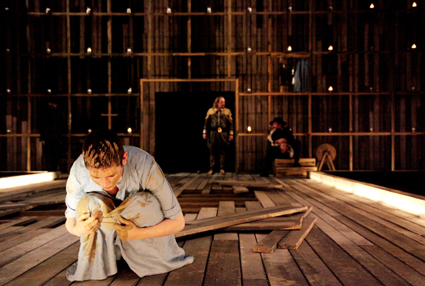
Yael Stone, A Golem Story, writer Lally Katz
photo Pia Johnson
Yael Stone, A Golem Story, writer Lally Katz
malthouse: a golem story
It would be remiss to discuss theatrical writing in Melbourne of late without mention of Lally Katz’s sterling A Golem Story at Malthouse Theatre. Katz has been one of the leading lights in playwriting for a decade, but Golem is a departure from her usual mode. It’s a work of restraint and austerity, invoking the uncanny rather than the fantastic. Based on the Jewish fable of the Rabbi of Prague, the writer has stayed unexpectedly true to her source.
The legend of the golem is a fascinating contradiction—steeped in history and tradition, it is also a quintessentially modern figure, a powerful repository of contemporary concerns. In the most well known of golem stories, it is a man created from mud by a Jewish mystic in order to defend his people from violent outsiders. As such, the golem has been harnessed by storytellers for different ends, as a symbol of both hope and solidarity in times of duress and, by less sympathetic revisionists as a kind of secret weapon that deserves suspicion. That ambiguous duality is well represented in Katz’ retelling, where the golem’s meaning is never confirmed.
Katz’ script opens with a brilliantly spare piece of scene setting as a young woman confronts a man:
AHAVA. Is this Prague?
RABBI. Yes. It is Prague.
AHAVA. What year is it?
RABBI. It is 1580.
AHAVA. Am I Jewish?
RABBI. Yes.
AHAVA. And you are the Rabbi?
RABBI. Yes.
To me Ahava seems to be Katz herself, setting forth to engage with a Jewish heritage to which she is in some ways still a stranger. But what results, especially under Michael Kantor’s direction, is not a work of meta-theatrical self-reference such as the playwright’s Goodbye Vaudeville, Charlie Mudd or Lally Katz and the Terrible Mysteries of the Volcano. A Golem Story is a solemn exploration of the role of the sacred in the modern world, in which Katz and Kantor attempt not to represent the spiritual experience but to reproduce it as immediate experience. Anna Cordingley’s design is a superbly judged mediation of the earthy and the transcendent; the live songs accomplish something similar, as well as reminding the viewer of the connection between voice and the invisible foundations of life (indeed, the word ‘animate’ is from a Latin root that signifies both ‘soul’ and ‘breath,’ as if the two cannot be divorced).
While Katz’ script is a compelling one on paper, the Malthouse production illustrates that a play’s meaning likewise cannot be shorn from its performance, its breath. The art of playwriting doesn’t truly seem in danger of disappearing any time soon, but it takes a lot more than a playwright to make a piece of theatre that truly lives, however brief its time on earth.
MKA: Sleepyhead, writer Nathaniel Moncrieff, director Yvonne Virsik, set & lighting design David Samuel, May 10-28; 22 Short Plays, writer David Finnigan, director Tobias Manderson-Galvin, May 31-June 18; The Horror Face, writer Glyn Roberts, director Felix Ching Ching Ho, June 23-July 9; J.A.T.O., writer Vedrana Klepica, dramaturg Declan Greene, director Tanya Dickson; MKA Theatre, July 14-30; Malthouse: A Golem Story, writer Lally Katz, director Michael Kantor, performers Nicholas DeRossos, Joshua Gordon, Mark Jones, Michel Laloum, Brian Lipson, Dan Spielman, Greg Stone, Yael Stone set & costumes Anna Cordingley, lighting Paul Jackson, musical direction Mark Jones; CUB Malthouse, Melbourne, June 10-July 2
RealTime issue #104 Aug-Sept 2011 pg. 16
© John Bailey; for permission to reproduce apply to realtime@realtimearts.net
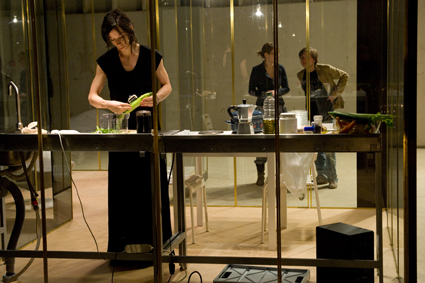
Sanja Mitrovic, Daydream House
photo Anna van Kooij
Sanja Mitrovic, Daydream House
LOGGING ON TO BUY TICKETS TO FESTIVAL A/D WERF, I AM INVITED TO PERUSE THE PROGRAM ACCORDING TO TIMETABLE, PRICE AND GENRE. THE TIMETABLE INDICATES THAT THE FESTIVAL IS ON FROM MAY 17 TO 26 IN UTRECHT (ABOUT AN HOUR OUT FROM AMSTERDAM) AND THE PRICES SEEM TO RANGE FROM €2.50-20 (AUD$4.60-26) PER TICKET—SO FAR, SO GOOD. HOWEVER, IT IS THE GENRE MENU THAT TRULY ASTOUNDS, LISTING THE FOLLOWING OPTIONS: “TEXT(THEATRE), VISUAL ARTS/INSTALLATION, DANCE(THEATRE), FILM-/VISUAL THEATRE, PHYSICAL THEATRE, LECTURE PERFORMANCE, SITE-SPECIFIC THEATRE, MUSIC (THEATRE), PERFORMANCE AND PERFORMANCE/INSTALLATION.” NOT JUST GENRES BUT SUB-GENRES OF THEATRE AND PERFORMANCE—THIS MIGHT JUST BE MY KIND OF FESTIVAL!
Of course, the exciting thing about festivals is that even when accompanied by such rigorous and exhaustive taxonomies, the work itself often falls between and across categories. In doing so, it rewrites the classification system for the next festival, sometimes even the next generation. On the basis of this year’s showing, I’d suggest that Festival a/d Werf consider a new category called “machinic performance.”
laurent liefooghe, woonmachine
One of my favourite works functions as both an installation in its own right and as the set for another performance (more on which later). Laurent Liefooghe’s Woonmachine (Living machine) first appears to me as a small glass island stranded in a sea of concrete—a glimpse of fragility in a heavy-duty, post-industrial space. Inside the installation there is what looks like a tiny motel room, complete with bed, armchair, shower, kitchen and table. When you step inside, you can hear a series of noises, conversations and instructions. If you choose to stand and listen, as I did, you can hear “living tak[ing] place without inhabitants” (program). Or, you can choose to obey the instructions and sit on the bed, pull up the duvet and thus become a performer yourself. Over the course of 37 minutes, an entire day and night pass, the lights changing their colour and the walls their opacity. The overall effect is deeply unheimlich, commonly translated as “uncanny” but also, appropriately in this instance, “unhomely.” This is indeed an “unhome”: not quite life-size, not quite life-like, but near enough to unsettle. The program states that it can be read as both a “modernist glass house and a black box” but it also seems like a postmodernist merging of Apple and Ikea, where both your books and your being have been reduced to a “pod.”
james beckett, blinds
Situated in a similar space to Woonmachine, both literally and conceptually, is James Beckett’s Blinds. Within the same converted warehouse, Beckett has created a tiny cinema of 16 seats. Up the front, a black roller door rises to reveal a white venetian blind. This blind then rises to reveal another white blind, which—after a pause—reveals yet another just like it. This continues, at varying paces, for approximately 30 minutes and 50 blinds, though it is hard to keep track of either. During this time I find myself marvelling at the different shades of white, cream, pearl and alabaster, the different widths of the slats, and the fact that none of the blinds ever tangle, snag or lift in a lopsided fan. More significantly, I think of Malevich’s minimalism and the older theatrical tradition of the reveal, whereby the curtains peel back and we finally see. In the case of Blinds, I keep expecting to see a mirror, which would reflect our own desire to see back at us, but Beckett refuses us even this, choosing instead to force us to reflect on reflection itself, in every sense of the word.
kris verdonck
The relationship between machine, performer and spectator also comes into play in Kris Verdonck’s work. I miss the “live” version of Verdonck’s Actor#1 but later see him in conversation with his collaborator dramaturg Marianne van Kerkhoven and Melbourne academic Peter Eckersall (the festival coincided with the Performance Studies international conference at Utrecht University). Both the work and the discussion are wide-ranging, drawing on the vocabularies of theatre, visual art and architecture. In one work, Dancer#1 (2003), an L-shaped steel beam spins and lurches as it attempts to recover its balance, but since it never can it begins to read as a dance of death—completely improbable given it’s a machine (http://vimeo.com/5436267). In another work, In [www.margaritaproduction.be/_ENG/KRIS_VERDONCK/IN/FILM.html] (2003), a human performer is immersed in a sensory deprivation tank for an hour—at first glance she looks like a robot, but then she blinks and we hear the amplified sounds of her breath and heartbeat. In I/II/III/IIII [www.youtube.com/watch?v=fNo4xeizMf0] (2007), dancers are suspended like marionettes in a life-size mobile; though they seek to maintain unity in their choreography, the tiny physical differences between them eventually send them into ever so slightly different spirals. Each of these works, as well as the more theatrical END [www.youtube.com/watch?v=jbtwrPjuc0U] (2008), is mesmerising and the sooner someone brings them to Australia, the better.
sanja mitrovic, daydream house
Enter sandman, or sandwoman as the case may be in Sanja Mitrovic’s Daydream House, which is set in Liefooghe’s Woonmachine, lending the installation yet another layer of meaning and vice versa. Mitrovic is an elegant hostess, sweeping about in a long black dress offering wine, food and entertainment. The show starts with her peeling and chopping carrots, cucumbers and celery in silence before finally saying, “Boring, uh?” She lists a series of vaguely depressing statistics about how many hours we spend during our lifetimes preparing meals, watching television etc. “But,” she exclaims, “they are such deliciously unproductive hours!” She has a brief conversation about her day with an invisible interlocutor before speech disappears and the segment is repeated as a physical phrase. She then steps out of the house and tells us the story of Chekhov’s mother, who lost the family home twice over. These events apparently inspired The Cherry Orchard and Mitrovic recites a passage from the play’s final act, the phrase “What these walls have seen!” taking on a new complexion. This might be the end, but instead the performer drags out the furniture piece by piece, herding some spectators into the room while others remain outside looking in. She sits on a couch and speaks into a microphone, telling us of life in Belgrade in 1999—of what it is to sit in the dark, or the day for that matter, waiting for a bomb to drop. “Even fireworks get boring,” she says, and “everyone moves away.” Subtle and understated, Daydream House brings together numerous cultural inheritances from Chekhov to cinéma vérité to installation art. Not so much a narrative as a mood, it left me profoundly nostalgic for a place I never knew.
the economics of performance
Such theoretical musings on the mechanics of performance are cut short when confronted by the economics of performance. Not long after I arrive home, I receive an email imploring me to sign a petition against the Dutch government’s drastic budget cuts. The recently elected right-wing coalition plans to cut €200 million—approximately 25% of current expenditure—from the arts budget by 2013. While the “top institutions” (museums, opera and ballet) will survive relatively unscathed, 21 production houses working in contemporary visual and performing arts are facing closure, including Utrecht’s Huis a/d Werf. It is hard to imagine the past few decades of theatre, performance and dance without the Dutch influence and it would be an immense shame to see it disappear now. They have not only helped to pioneer contemporary performance, they have helped to make and remake its very categories.
Festival a/d Werf, Utrecht, May 17-26; www.festivalaandewerf.nl
RealTime issue #104 Aug-Sept 2011 pg. 22
© Caroline Wake; for permission to reproduce apply to realtime@realtimearts.net
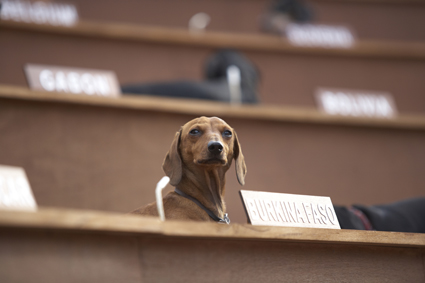
Bennett Miller, Dachshund UN
image courtesy the artist
Bennett Miller, Dachshund UN
ON JULY 6, IN RADIO NATIONAL’S AUSTRALIA TALKS, THE QUESTION UNDER DISCUSSION WAS WHETHER THE VISUAL ARTS SHOULD BE CLASSIFIED THE SAME WAY AS FILMS AND VIDEO GAMES. THE TOPICALITY OF THIS THEME COMES IN THE WAKE OF A SENATE COMMITTEE INQUIRY, WHICH HAS RECOMMENDED THAT THE VISUAL ARTS SHOULD BE SUBJECT TO THE PRINCIPLES OF THE NATIONAL CLASSIFICATION SCHEME, WITH A DISSENTING REPORT FROM GOVERNMENT MEMBERS OF THE COMMITTEE PREFERRING TO AWAIT THE OUTCOME OF A CONCURRENT AUSTRALIAN LAW REFORM COMMISSION REVIEW OF THE SCHEME.
As one of its recommendations, the Senate Committee proposed a self-assessment scheme under which breaches of the classification code would be met with sanctions. More importantly it recommended the appointment of community advisory panels with the authority to advise and guide the National Classification Board in its deliberations. In recommending this, the chairperson of the Senate Committee, the Tasmanian Liberal Party senator Guy Barnett, indicated that decisions of the Board should reflect community standards and attitudes of the day.
In his introduction to Australia Talks, Paul Barclay asked the following questions: How would this affect Australian artists and galleries? Could it restrict artistic freedom? Is it appropriate for art to reflect community standards and attitudes? Not surprisingly, given the focus of the Senate Inquiry, the conversation focused on sexualised imagery of children and the photographic work of Bill Henson. In 2008, the Henson debate reawakened and questioned the long-standing claim that artistic freedom excuses behaviours that may be unacceptable in other realms. This claim, often referred to as the aesthetic alibi, asserts a special case for art that might otherwise be unlawful if part of everyday life.
the aesthetic alibi under fire
Martin Jay described the aesthetic alibi as a “special case of freedom of speech,” one that provides dispensation to otherwise offensive material if it takes place “within the protective shield of an aesthetic frame” (Jay, 1998). The aesthetic alibi has given rise to legislative defences that protect works of artistic merit which would otherwise be deemed illegal (for reasons of obscenity, pornographic content or racial and religious vilification) and is implicitly invoked when contributors to public debate argue for the sanctity of a work on the basis that it is ‘art.’ Bill Henson actually sought classification of his work—it was after all available for viewing on the internet and a postcard which would have brought it into the realm of the classification system—receiving a “Parental Guidance” rating. Nonetheless, the ensuing controversy around the Henson photographs of children reflected prevailing community attitudes and responses to risk and all too often unsubstantiated claims took precedence over critical debate around aesthetics and ethics. The current proposal for community advisory panels raises the question that, where the ethics of practice are negotiated to reflect community standards and attitudes, artistic freedom and the aesthetic alibi come under fire.
The Senate Committee Inquiry and the Australian Law Reform Commission review of the National Classification Scheme question the aesthetic alibi and the assumption that art should have “special” dispensation. The Senate Committee Inquiry argues that artistic merit is not a defence, particularly when it comes to child pornography. While the exploitation of children holds centrestage, the recommendations go beyond this specific question to focus on the distribution and public viewing of art that is deemed to be outside or at the edge of accepted community standards. In essence the Inquiry is concerned with broader issues of censorship. However, the discussion around classification needs to be put in a broader context of the ethical regulation of art both in the public realm and now, more specifically, in the academy. Increasing regulation of the creative arts impacts on not only what we are able to view and experience, but more specifically on what artists can actually do. Thus a pressing question for artists working across the disciplines is: how does ethical regulation affect the creative process?
artists & protocols & ethics
The Australia Council responded to the debate around Bill Henson’s work by introducing its Protocols for Working with Children in Art (2009), linking them directly to the funding of artistic activity. In short, non-compliance or failure to sign up to or act in the spirit of the protocols may result in the denial or withdrawal of funding. Less well known is the impact of ethical regulation of art in the academy. As a result of the 1990s Dawkins’ educational reforms, creative arts education was integrated into the university sector. In the university context, art was reframed as research and artists became researchers. Under this rubric artists, like all researchers in the academy, are answerable to the National Statement on Ethical Conduct in Human Research (NHMRC et al, 2007) and its equivalent for research involving animals, the Australian Code of Practice for the Care and Use of Animals for Scientific Purposes (NHMRC, 2004). With a focus on researcher integrity, justice and beneficence, the decision-making processes of university ethics committees tend towards risk aversion rather than management of risk.
risk aversion & self-censorship
The risk-averse environment inside and outside of the academy has had two major consequences:either risky art projects may not be funded or else (in the case of art in the university) denied approval. More worryingly, as Robert Nelson observed on air, artists self-censor and steer away from projects that are likely to create bother. Thus the impact of ethical regulation, including codes of practice and ethical protocols, have shifted attention away from the circulation of the work among audiences and have refocused it on the production of the artwork itself. When art or art as research is in conflict with established protocols, artistic freedom and the aesthetic alibi are no longer a valid defence.
at the boundaries of art & life
The view that there is something unique about artistic activity that sets it apart from ‘everyday life’ can no longer be taken for granted. Many contemporary art practices sit precariously on the boundary of art and life, and it is these areas of artistic practice that are particularly vulnerable to assertions of unethical conduct within the educational and professional sector. Common themes include the use of animals in art; concerns relating to artworks that utilise surveillance techniques and appear to impinge on personal freedom and/or privacy; instances of self-harm on the part of artists; and, as already mentioned, creative practices that involve children. In 1975 for example, the Australian artist Ivan Durrant draped a cow carcass across the entry of the National Gallery of Victoria and was filmed shooting a cow in front of the Monash Gallery of Art. In 2000 at the Trapholt Art Museum in Denmark, Marco Evaristti challenged viewers to activate food blenders containing goldfish, resulting in animal cruelty charges against the Museum Director. Melbourne’s 2010 Next Wave Festival contained a work by the Australian artist Bennett Miller, Dachshund UN, consisting of 47 dachshunds representing member states of the United Nations, a work that also provoked debate around perceived animal cruelty. SymbioticA has collaborated with the Australian artist Stelarc to grow an ear from cells (Zurr and Catts, 2004). When exhibited, the National Gallery of Victoria, in response to ethical concerns, displayed a notice assuring visitors that no human tissue was used.
The work of renowned French artist Sophie Calle directly engages with the blurred boundaries of the public and private self. In Suite Vénitienne (1980), Calle observed a stranger, following him across Europe and filming his movements. In another work, shown at the Venice Biennale 2007, she displayed an email from an ex-boyfriend, making it the central motif of the work accompanied by over 50 interpretations of the email text, some of which purported to analyse its author. When Marina Abramovic visited Melbourne as part of the 1998 Melbourne International Arts Festival she presented a work which required the audience to be physically restrained within a holding cell of the Old Melbourne Goal. In a separate work Abramovic invited an audience to take up knives and other weapons against her—incurring actual physical harm. Vito Acconci’s Claim (1971) challenged audiences to approach the artist, who was fiercely guarding a stairwell entry, and physically threatening anyone who approached. The Australian artist Mike Parr has long maintained a practice of self-mutilation, burning his skin and sewing his lips together. Bill Henson’s focus on children in the process of artistic creation, and the controversy it produced, can be seen as part of a continuum of artistic activities which challenge conventional and popular concerns about potential harm to self and others.
ethical constraint vs artistic freedom
Contemporary artists and those in the academy who are both influenced by and aspire to emulate many of these avant-garde practices are faced with a contradiction. While individual freedom and unrestrained creativity are at the heart of art training, the legal and institutional frameworks within the profession and educational institutions are likely to be just as concerned with risk management and compliance. The Statement on Ethical Conduct specifies that all research involving humans must be conducted in accord with the following principles: the research must have merit and integrity, be designed and conducted according the principle of beneficence (maximise benefits, minimise risks to participants) and be in accord with principles of justice and demonstrate respect for human beings and animals. Research involving human subjects and animals is submitted to a university ethics committee before a researcher is given the authority to proceed with a project. These committees may require changes to a project’s methodology or reject it altogether if they feel it conflicts with ethical protocols. The notion of the aesthetic alibi is not considered a valid rationale for an art practice that tests these protocols.
A recent survey undertaken at the University of Melbourne suggests a level of anxiety on the part of artists-as-researchers. From the responses, particularly from amongst practice-led researchers, it emerged that researchers believe that the ethics protocols, processes and procedures in universities operate as a silent regulator of conduct and a subtle determinant of content in creative arts research. One respondent expressed concern that the actual training of artists might lose its open inquiry should ethics processes determine modes of inquiry: “The training of a professional artist within academe, even as it includes research training must also acknowledge the serendipitous, convulsive, errant and imperious actions of the imagination in its moments of discovery.” Further, it was revealed that some students self-censored merely because they thought their project would not get through the ethics process: “The mere mention of these considerations [the ethics guidelines] is often enough for the student to self censor.” From these observations it could be argued that through its very stringent processes of ethical regulation, the university ethics procedure introduces limitations that work against ‘cutting edge’ research and mitigates experimentation at the heart of practice.
A 2003 study by Throsby and Hollister found that 91% of visual artists had undertaken some formal training and that 67% identified this as being their most important training and formative influence on their artistic practice. It is not surprising then that there is concern that what happens in the academy may flow through into and impact on the nature of practice once these are professional practicing artists. This in combination with the development of artistic protocols and classification offers a fundamental challenge to artistic freedom and the artistic alibi.
colliding benefits
Many artist academics hold the conviction that art should maintain its social critical role at the ‘edge’ and continue to test and trouble society’s ethical and moral boundaries, a role that stands in conflict with the fundamental precept of beneficence that underpins the Statement on Ethical Conduct. Research protocols could then be seen to be in tension with the fundamental tenet of avant-garde art, a tenet still held dear by many contemporary artists: art acts as a provocation; it operates as the conscience of a society, it produces discomfort and brings its audience into crisis (Bolt et al, 2010). For artists this discomfort and crisis represents precisely art’s benefit, both to the participants and to the wider community, while for an ethics committee such discomfort may be deemed an unacceptable risk. Here, two notions of beneficence collide. A comparable conflict can be observed more broadly as the government moves to limit the protections available to artists in a range of legislation, such as the anti-terrorism laws, representing a further fundamental challenge to the aesthetic alibi.
transgression for the good
The realm of the aesthetic is now meeting that of the ethical, not only in the academy but increasingly in the art world with no considered examination of the implications of this accord. Jacques Rancière (2009; 2010) asserts a distinction between aesthetic practice and ethical practice, and proposes that an ethical practice demands that individuals be treated according to the dominant ethos of the community in which they live. Consequently, the avant-gardism of artistic activity and its challenge to dominant social mores could be considered to be in opposition to ethical regulation. Susan Best encapsulated this tension when she referred to art “being seen as transgressive and lawless rather than being governed by the pursuit of the good” (Best, 2004). In his discussion of the animosity that art can create in a community, Leo Steinberg observes that the “animistic charge of artworks—the vitality imputed to them by the receiver” is what sets art apart (Steinberg, 1986). This vitality, this discomfort and crisis is precisely art’s benefit, both to the participants and to the wider community. The danger however, as Steinberg cautions, is that this discomfort might also allow iconoclasm to find fertile soil.
art circumscribed
A legacy of avant-garde conceptions of art as a necessary challenge to the status quo runs through contemporary practice and theory, perhaps nowhere moreso than in the early experimental stages of artists’ practices. Hence, many contemporary artists and art students pursue practices intended to be in direct tension with society’s norms. These art practices involve activities that may not be condoned in everyday contexts. In the past the concept of the aesthetic alibi, the suggestion that the imaginaries of art are inappropriate targets of generic legislative sanction, has been seen to be inviolate. Increasingly, as we outline here, it is not just the law that seeks to circumscribe artistic activity, but the ethical codes of practice within which art education institutions operate and the professional protocols for artists’ conduct. The combination of these various interventions could in some environments and risk-averse institutions lead to the stifling of creative development. What is called for is an environment that encourages a situated ethics of practice, one that responds to the particularities of each individual artistic activity and interpersonal negotiation, rather than regulating artistic activity through the external imposition of codes and protocols.
additional resources
Best, Sue (2004), Editorial, ANZJA, Vol 4 No 2, Vol 5 No 1; Bolt, B, Vincs, R, Alsop, R, Sierra, M, and Kett, G, (2010) Research Ethics and the Creative Arts, Melbourne, Australia: Melbourne Research Office; Jay, M, (1998), “The Aesthetic Alibi” in Cultural Semantics: Keywords of Our Time. Amherst: University of Massachusetts Press; Rancière, J (2009), “The aesthetic dimension: aesthetics, politics, knowledge,” Critical Inquiry, Vol 36 No 1; Rancière, J (2010), “The aesthetic heterotopia,” Philosophy Today, 54; Throsby, D and Hollister, V (2003), Don’t Give Up Your Day Job, An Economic Study of Professional Artists in Australia. Sydney: Australia Council; Steinberg, L (1986), “Art and Science: Do they need to be yoked?”, Daedalus, Vol 115 No 3, Art and Science (Summer 1986); Zurr, I and Catts, O (2004), “The ethical claims of bio-art.” ANZJA, Vol 4 No 2, Vol 5 No 1
RealTime issue #104 Aug-Sept 2011 pg. 26-27
© Kate MacNeill & Barbara Bolt; for permission to reproduce apply to realtime@realtimearts.net
ASSOCIATE PROFESSOR LISA FRENCH HAS BEEN TEACHING A COURSE IN AUSTRALIAN FILM AT RMIT FOR 10 YEARS, AS PART OF THE CINEMA STUDIES MAJOR IN THE SCHOOL OF COMMUNICATIONS AND MEDIA. WHILE THE COURSE ALWAYS LOOKS AT AUSTRALIAN CINEMA HISTORY, THE LOCAL FILM INDUSTRY AND THE CONCEPT OF A NATIONAL CINEMA, ITS STRUCTURE AND THEMES CHANGE FROM YEAR TO YEAR, TO KEEP IT FRESH AND INTERESTING, NOT ONLY FOR THE STUDENTS BUT FOR FRENCH HERSELF.
Australian Cinema is a 12-week course taught to undergraduates as part of the major or as an elective, with usually around 100 students. Films are selected in relation to the story the course is telling in any particular year, but are drawn from all periods of Australian cinema history and include shorts, features, docos, animations and experimental films.
an indigenous dimension
Whereas last year’s course looked at the themes, resonances and deep storylines throughout Australian culture that built Australian national cinema, this year there will be a stronger focus on Indigenous filmmaking, which will also make the course more contemporary. It’s been designed around films that are made by, or connect with, issues or representation of Aboriginal and Torres Strait Islanders, providing an integrated look at the artistic practice of Australian Indigenous filmmakers, examining how Aboriginal traditions have been cinematically or visually translated by filmmakers through innovative, imaginative and culturally specific approaches; films by non-Aboriginal filmmakers are examined in relation to how they contribute to the representational history and debates. “I’ve been able to hire a young Indigenous academic, filmmaker and activist, Simon Rose, to work with me on this course,” Lisa French explains, “and his ideas are different to mine. He’s particularly interested in humour as a critical aspect of Indigenous filmmaking and we’ll be screening films to illustrate that, such as Stone Bros and Bran Nue Dae.”
The course is built around a two-hour screening, a lecture and a one hour tutorial, with some of this time spent at ACMI; “the mediatheque at ACMI has such a rich resource of Indigenous material that it will be invaluable,” says French. Most of the students are doing a Bachelor of Communication, mostly majoring in Media. “The students are spoilt because they see the films at Hoyts, on 35mm; in a cinema, not on DVD,’ she explains, “although of course they do watch lots of other films on DVD, or through other sources, even YouTube.”
She also has a large number of exchange students; “this is fantastic, as they see our cinema completely differently. They think Muriel’s Wedding is a tragedy; with its elements of cancer and suicide they don’t think it is at all funny.”
australia beyond the mainstream
Margot Nash has just embarked on a new course in Arts and Social Sciences at UTS (University of Technology Sydney), part of a sub-major open to students from anywhere in the faculty, made up of three strands: Reading Australia; Past and Places; and Australian Film. “When it came to designing the course I felt quite daunted at first, but coming to it as a filmmaker rather than a film historian, I felt I wanted to approach it not through the accepted film canon, but rather through an underground, oppositional film history, a non-mainstream film history.”
So while the course provides the study of key moments in Australia’s film history such as the revival of the Australian feature film industry in the 1970s, it also looks at the new wave of avant garde, documentary and feminist film practice in the 70s and 80s and the latest wave of Indigenous and transnational filmmakers in the 90s through to the present. There will be a particular focus on independent and oppositional film practice through the study of recurring themes and issues such as Crime and Punishment, Indigenous stories, Migration, Working Lives, Alternative Lives and Women Make Waves.
This year’s course was over 13 three-hour sessions, although Nash is hoping to increase this to four-hour sessions next year, allowing for the screening of more complete films. This year films that were shown in their entirety included Wrong Side of the Road (1983), with one of the filmmakers, Ned Lander, in attendance, and Rocking’ the Foundations (1986), with producer-director Pat Fiske, screened in the session on activist documentary. But the course started with clips from The Story of the Kelly Gang (1906) and the 2004 three-part Film Australia History of Australian Film from 1896 to 1940, all of which gave students some understanding of the early years of the industry.
“The students had no idea about any of this. They only knew about the big mainstream films and not even much about them. It was a revelation for them,” Margot Nash says.
At the completion of this subject, students are expected to be able to explain the importance of a pivotal figure or figures in Australia’s film history, critique a film produced at a key moment which challenged ideas and conventions and reimagined Australia in some way, or create an imaginative and critical response to the imaginary produced in a recurring key theme or issue. Their responses came in the form of blogs, essays or films: “There were some really creative responses to the films in the strand, and they had reached such an understanding of the richness and diversity there,” Nash said. “One girl embroidered an evening bag as a tribute to the McDonagh Sisters and their witty, worldly silent features from the 20s, filling it with copies of contemporary reviews of their films.”
documentaries: resurgence & diversity
Associate Professor Dugald Williamson at the University of New England (UNE) School of Arts teaches Documentary studies, with a particular emphasis on Australian documentary. He is co-author, with Trish FitzSimons and Pat Laughren, of Australian Documentary: History, Practices and Genres (Cambridge University Press, 2011), a most timely and substantial look at documentary in Australia. He recalls that “when we did ‘market research’ for the book, two or three years ago, at least 29 higher education institutions in Australia had some practical and/or theoretical work on documentary, though the word ‘documentary’ wasn’t necessarily always present in course/subject titles. This range included some 70 individual subjects (units), across both undergraduate and postgraduate level.” As he says, “the diversity of offerings suggested a critical mass in recognition of the relevance of documentary for several kinds of educational purpose— production education and training, media skills and literacies in a changing technological environment, discipline knowledge of media/communications/screen and interdisciplinary interests including history, cultural studies, ethnography etc.”
Williamson believes there’s a resurgent interest in documentary, partly because of the development of infotainment, “but I find that students are often also interested in the discussions (occurring in industry and academia) about whether and how doco can engage with real people and wider situations not just constructed for the show. This goes to students’ own experience of media and what they value. It’s important and rewarding to see what students’ own conceptions of documentary are and to offer ways of widening these, exposing them to a variety of forms and voices with which they may not already be familiar—independent work, experimental, animated and digital doco, as well as the many appealing forms of observational and essay documentary.”
As he says, Australian documentary in its diverse forms has had a role comparable to other arts in interpreting and influencing national culture: “Thanks to our heritage institutions there’s a rich archive of such work, giving a window onto history, engaging with the changing ‘imagined community,’ while documentary continues to evolve and show different perspectives, such as the Indigenous retelling in First Australians: The Untold Story of Australia (2008; Blackfella Films, directors Rachel Perkins and Beck Cole).”
He believes that using documentary in higher education “provides the opportunity to look at how it ties into a range of disciplinary knowledges and social purposes, especially as resources increase online. Studying or making docos can help students see there have been changing forms of independent and community filmmaking as well as mainstream industry and institutions, so there are multiple points of access to making/using media.”
resource riches
The already rich and growing digital resources available to students online are obviously important in these courses and include Australianscreen Online (ASO, http://aso.gov.au/), the ABC’s A Place to Think and Screenrights’ EnhanceTV, while Dugald Williamson says his students have also been using Channel 4 and BBC sites—”it’s amazing what they find.”
ASO, operated by the National Film and Sound Archive, is a promotional and educational resource providing worldwide online access to information about the Australian film and television industry. Audio-visual material is sourced from the NFSA’s archives as well as those of its collection partners, the National Archives of Australia, public broadcasters ABC and SBS, and the Australian Institute of Aboriginal and Torres Strait Islander Studies—all the major audio-visual collections in Australia.
ASO contains information about and excerpts from a wide selection of Australian production from the early days to the present, in a digital resource which encourages the exploration of Australia’s screen heritage. The collection currently has almost 1,500 titles covering a wide range of formats and genres, from professional productions (feature films, television programs, shorts and advertisements) to factual programmes (documentaries, newsreels, corporate films and other historical footage) and non-commercial content (home movies). The website also has a separate section that draws together Indigenous content from the general format categories and profiles of Australian filmmakers in its “People” section. Information available for each of the audio-visual titles in the collection includes a list of the main credits and other production information, synopsis, curator’s notes, filmmaker comments and up to three three-minute clips from the original material. In some cases, as with advertisements and newsreels, items can be viewed in their entirety directly from the website. For other titles there are links to information about how to access a copy of the complete film.
Targeted at a wide and diverse audience including primary and secondary schools, tertiary researchers and students, screen industry practitioners, screen organisations and the general public, ASO receives around 90,000 visits per month, of which around 25% come from outside Australia. Around a third are from the education sector.
film research app
Australian Teachers of Media (ATOM), who have been making their well-respected study guides for over 20 years, have now launched what they believe to be a world first, an interactive film study guide app to be distributed initially through the iTunes App Store; this interactive study guide incorporates clips, animation and web functions. It was launched last month with two major productions, the Jim Loach Australian-UK co-production Oranges and Sunshine (2010) and the documentary Kapyong (Dennis K Smith, 2011).
hidden treasures
Of course, there is much valuable material that is not yet available as a digital resource. I was editor of Filmnews from the late 1970s to the mid 90s; over the same period, Cinema Papers was also going strong. Both publications have a wealth of interviews, production stories, reviews and debates on much of the local filmmaking and filmmakers of the period, as well as articles on the issues, often contentious and hotly fought over, that were important, to do with government policy and practice and the policies and performance of the various institutions within the film community. And there are other publications, both earlier and later, whose valuable contents are rarely accessed now; as online resources they could provide much invaluable support to the students looking at Australian film in various courses. Let’s hope they can soon become available.
additional film resources
AFTRS film journal, Lumina, now in its 7th edition (it can be purchased through www.aftrs.edu.au/explore/lumina.aspx); Dreaming in Motion, Celebrating Australian Indigenous Filmmakers (edited and produced by RealTime for the Australian Film Commission, 2007; the PDF of the book can be downloaded from www.screenaustralia.gov.au/documents/SA_publications/DreaminginMotion.pdf); RealTime has online Archive Highlights on Australian animation and Indigenous film can be found at; ATOM’s Metro Magazine with its enormous archive can be accessed at www.metromagazine.com.au; and there’s the OzDox site www.ozdox.org providing articles, interviews and news focused on Australian documentaries. Eds
RealTime issue #104 Aug-Sept 2011 pg. 29
© Tina Kaufman; for permission to reproduce apply to realtime@realtimearts.net
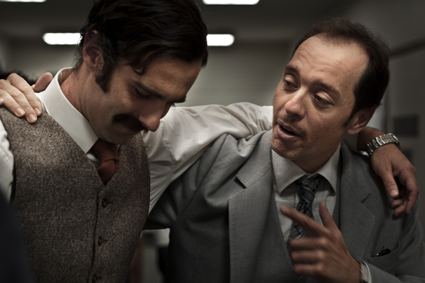
Cop Hard
OSCAR REDDING AND JONATHAN AUF DER HEIDE ARE ADAMANT. THE ONLY SOCIAL VALUE OF THEIR WORK IS AS A USEFUL CORRECTIVE. “AS FAR AS MAINSTREAM CONTENT GOES,” REDDING SAYS, “IT SEEMS THAT THERE’S A LOT OF THOUGHT GIVEN TO PRESENTING MATERIAL WHICH ISN’T OFFENSIVE. BUT I’D RATHER STAB MYSELF IN THE COCK WITH A SHARP FORK THAN SIT THROUGH ANOTHER PLAY BY JOANNA MURRAY-SMITH OR TONY MCNAMARA.”
Fresh from displaying his unstabbed member in Simon Stone’s production of Baal (RT103, p35), which made rather more headlines for the nudity of its cast than for its engagement with Brecht or the mastery of its stagecraft, Redding is playing down the suggestion that there is anything more to Cop Hard than bad accents and vulva jokes. He insists the 13-part web series he has co-produced with auf der Heide and starring a line-up of some of Australia’s most talented and psychologically unhinged young actors is actually less distasteful than a lot of what passes for entertainment in some other, more conservative circles.
“There’s actually a very large group of people who are fundamentally offended by this kind of ‘inoffensive’ theatre,” he continues. “Theatre, film and television that acts as some kind of counselling session, so that an audience can switch off or walk away from what they have witnessed with the comforting knowledge that they are living to the best of their ability and there’s no need for greater understanding or change, is offensive to a lot of people. So maybe producing an idiotic series like Cop Hard, where penises are allowed to float freely, kids are shot in the head and girlfriends make out with mothers, goes a little way to redressing the balance.”
While less vitriolic than his co-conspirator, auf der Heide nevertheless agrees. “I think we’re just producing work that we would want to see and wish there was more of,” he says. “We’re taking this opportunity to provoke our audience and have fun doing so.”
While Cop Hard is certainly provocative, it is arguable that the less perverse among us may find its producers’ sense of fun somewhat baffling. The series tells the story—and I use the world loosely—of mustachioed American detective Larry Hard who finds himself on the trail of a cop-killing clown after a number of his partners are murdered. In the meantime, he sleeps with everyone from a one-legged prostitute to the department’s resident shrink, watches approvingly as his parents copulate on the table during Christmas dinner and shows off his presumably fabled nipple to a group of cowboys sitting around a campfire. It is the last thing one would have expected from the pair whose last collaboration was Van Diemen’s Land (2009), the deadly serious feature film about Australia’s cannibalistic convict, Alexander Pearce, which was warmly received by critics even as it failed to make much of a showing at the box office.
“I felt that we told the story of Alexander Pearce the way it needed to be told,” says auf der Heide, who co-wrote and directed Van Diemen’s Land. “But just because I felt that the style we chose for that film was the best way to go doesn’t mean that I solely want to make contemplative art house films. Cop Hard was a reaction to that and probably an exaggerated one.”
“When you’re working on something like Van Diemen’s Land there’s such a serious nature to the story that the seriousness becomes a side effect of the way you approach the work,” Redding says. “We certainly had a great time making Van Diemen’s Land—a lot of good whiskey was put down in the evenings—but there was no escaping the challenge we faced and how hard we had to work to bring truth to the world and the story being told. Cop Hard seemed like a great opportunity to have a good laugh at ourselves.”
Consisting of 13 three- to seven-minute episodes, at least half of which bear no connection whatsoever to the series’ overarching narrative, the result is not only a pitch-perfect parody of 1970s police procedurals—Spike Jonze’s video for the Beastie Boys “Sabotage”, with its bad stick-on moustaches and I-have-come-to-clean-zee-pool swagger, is its closest relative—but also a masterpiece of ‘non-sequitural’ absurdity.
“Yeah, the series does seem to grab its influences from all over the shop,” Redding says. “One minute it’s Hill Street Blues or Dirty Harry,” auf der Heide continues, “and then it’s something from left field like Twin Peaks. It’s also a journey into a kind of American culture without boundaries, where ego and self-righteousness are without limits, much like Larry himself.”
“But the show digs its heels into Australian culture as well,” he says. “Our entertainment is so saturated by US content that I honestly believe Australians don’t like hearing their own accents on cinema screens. An Australian show shot in Melbourne with American accents is a great way to give the finger to the Americanisation of our culture.” “Although at the end of the day,” Redding adds, “it isn’t really making any cultural comment at all. Although cloaked in the stars and stripes, it’s much more preoccupied with provocation, using very familiar archetypes of pop culture and fucking with our expectations.”
While the pair is quick to dismiss any suggestion that the series might have some deeper meaning, or any thematic connection to their previous work, these dismissals nevertheless strike one as slightly disingenuous. If nothing else, Alexander Pearce and Larry Hard share a fairly obvious fascination with flesh and all things carnal. This obsession is one shared by many of the theatrical productions with which Redding and a number of the pair’s other collaborators have been involved with, as is the series’ depiction of sexuality and its fluid interpretation of masculinity. If James Bond is a man that men want to be and women want to be with, Larry Hard is a man that men want to be with, too.
In one particularly memorable scene, Larry goes undercover in prison where he has violent sex with a talkative inmate in order to uncover his next clue. The inmate in question is played by Thomas M Wright, who not only appeared in Van Diemen’s Land but also alongside Redding in Baal, as the pansexual titular character. Both Wright and Mark Winter, who plays Larry in Cop Hard, are Black Lung Theatre and Whaling Firm alumni.
Redding nevertheless believes that the similarities have little to do with a genuine thematic preoccupation and more to do with the nature of collaboration and the creative environment that these groups are working in. “It’s chicken-and-the-egg-type stuff,” he says. Auf der Heide is a little less circumspect. “I haven’t had any involvement with any of those theatre productions, but there’s definitely similarity in all those works and what was going on with Cop Hard,” he says. “But it’s probably just the result of a bunch of like-minded people banding together and fighting the good fight against conservative entertainment.”
“That said,” he adds, correcting me, “I don’t think Larry Hard and Alexander Pearce could be any more different. Pearce never drives the story of Van Diemen’s Land. I wanted him to be a victim of circumstance. Larry, on the other hand, has free rein to do whatever he wants. He drives the story to unpredictable places because he can do anything without consequence.”
As for the consequences of releasing the series online, with the audience free to donate via PayPal if they like what they see, the pair has found the break from feature film distribution enlightening. “We’d been financially crippled making Van Diemen’s Land,” auf der Heide says. “We wanted to cut out the middle-men—the distributors and exhibitors—by giving something directly to the audience.”
“We loved the freedom of doing a web series where you don’t have to cater for a mass demographic or satisfy a third party. With Cop Hard we could take risks because our aim was to purely indulge a niche audience who we know would love it. The donation system is working well and hopefully, as the show grows in popularity, it will cover its costs. Which is something we’ll never be able to say about Van Diemen’s Land.”
“We’re getting a lot random views out of places like Mexico, Brazil and Turkey,” Redding says, “though most of the interest is coming out of the States. A project like this will always start by finding its feet in and around the friends you have and any industry connections who might be interested, but your core fan base is always going to come from somewhere else. That’s the great thing about the web. As a distribution platform, it isn’t really the future anymore. It’s the present.”
NOTE: Footballer-turned-filmmaker Charles C Custer, the series’ US-based director, was hunting numerous species of animal at the time of this interview and was unavailable for comment. On the basis of his unprofessional, borderline-offensive interviews in other publications, this strikes the author as no real loss.
Cop Hard: http://cophard.tv/
RealTime issue #104 Aug-Sept 2011 pg. 30
© Matthew Clayfield; for permission to reproduce apply to realtime@realtimearts.net
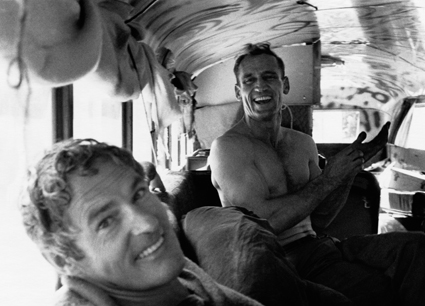
Magic Trip: Ken Kesey’s Search for a Kool Place
ALL TOO OFTEN IN AUSTRALIA DOCUMENTARY IS FORCED INTO THE STRAITJACKET OF BROADCASTER NEEDS, SLIMMED DOWN TO TV HALF-HOURS BEREFT OF CINEMATIC INNOVATION. YET THE SOLD-OUT SESSIONS FOR DOCUMENTARY FEATURES AT FILM FESTIVALS AROUND THE COUNTRY INDICATE A HUNGER FOR MORE IN OUR SCREEN CULTURE—A HUNGER DAVID ROKACH IS LOOKING TO SATISFY THIS OCTOBER WITH THE INAUGURAL ANTENNA INTERNATIONAL DOCUMENTARY FILM FESTIVAL.
“When I came to Australia I realised there was no documentary festival,” comments Rokach, an Israeli film and philosophy graduate who relocated to Sydney in 2008. “So I decided to create one. I saw the impact that Doc-Aviv had not just on the development of new audiences for documentary but also on the quality of the films being produced,” he adds, referring to five years of experience he clocked up working for Israel’s Doc-Aviv International Documentary Festival.
While Rokach acknowledges the international presence of local films like Molly and Mobarak (2003), Forbidden Lies (2007) and the recent Shut Up Little Man (2011), he believes there is a need in Australia for “more financial support for documentary filmmakers interested in developing work that is more cinematic and challenging, and whose approach intends to work beyond the frames of broadcasting.” Alongside support for production is the need for a film culture that can screen and appreciate challenging documentary work—which is where Antenna comes in.
“Antenna’s main objectives are to promote and support documentary film culture in Australia, providing screenings of documentaries that most likely will not be released in local cinemas,” explains Rokach. “The program will reflect what’s happening in the contemporary documentary cinema in Australia and around the world.”
For the inaugural festival, Rokach and his co-director Alejandra Canales, along with Julia Scott Stevenson, have assembled an ambitious program comprising more than two-dozen titles from nations as diverse as Russia, Mexico, Sweden and Japan. Rokach says that the long list of themes covered includes “politics, the environment, gender issues, music and art,” with an emphasis on films with “a very strong directorial approach.”
The festival’s breadth is evident in the range of sample titles RealTime was able to preview. Magic Trip: Ken Kesey’s Search for a Kool Place (directors Alex Gibney and Alison Ellwood) reconstructs Kesey’s legendary road trip across the US with his “merry pranksters” on a psychedelic bus in 1964, drawing on the many hours of colour footage shot by Kesey and others during the journey. Narration is provided by Kesey and the other pranksters via interviews from various periods, although some audio parts are reconstructed by actors from transcripts. Through these images from the time and the assemblage of audio testimony, Magic Trip pulls apart the legend from the inside, laying bare all the wonder, experimentation, naivety and foolishness of a crucial moment in modern American culture.
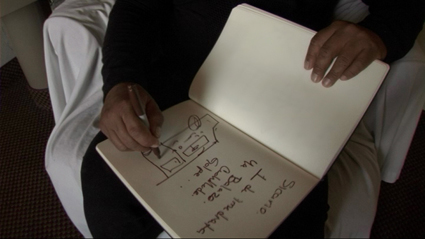
El Sicario, Room 164
At the other end of the spectrum, El Sicario, Room 164 (director Gianfranco Rosi) heads south of the border to contemporary Mexico, where the brutal slaughter of the Mexican drug wars is recounted in unsettling detail by a former “sicario”—one of the elite killers and torturers of the “cartel” that presides over Mexico’s cross-border drug trade. Hooded to protect his identity, the former hit man recounts a litany of horrors in a hotel room where he claims to have once tortured a victim. The power and reach of the organisation he describes is truly terrifying, involving the highest levels of the Mexican government, military and police force, as well as the US police and FBI. Rosi’s film is a model of simplicity that holds viewers in the grip of a claustrophobic horror, made all too real by the regular headlines detailing mass killings in Mexico’s border towns.
Into Eternity (director Michael Madsen) is a very different kind of horror film, taking us into the murky world of Onkalo, a vast underground city dug five kilometres into the Earth’s crust and designed to hold Finland’s nuclear waste for the next 100,000 years. The sheer scale and hubris behind the world’s first “permanent solution” to the nuclear waste issue is dissected with a cool, clinical tone that throws the utter irrationality of our ‘civilisation’ into sharp relief. Director Michael Madsen will be a guest at this year’s festival.
Alongside a strong international program are several Australian features and short documentaries, including an intriguing new 15-minute work from Dennis Tupicoff entitled The First Interview. Featuring a narration by the legendary Agnès Varda, this short brings to life an interview from 1886 between the Parisian photographer Nadar and the French scientist Chevreul.
Antenna will also feature a screening targeted specifically at high school students, a student film competition and various panels. There will be cash prizes for the best international, Australian and student titles. Clearly this is an event underpinned by an ambitious vision looking to carve a permanent place for Antenna in Australia’s festival calendar. Rokach says his team is already working on next year’s program, although he believes “we need to strengthen and grow in Sydney before we initiate a presence in other capital cities.”
It remains to be seen if Rokach and his team can realise their aspirations over the longer-term, but the 2011 program suggests a promising start. Since the demise of Real: Life on Film, Australia has been without a dedicated documentary festival, and the increasing conservatism of our broadcasters and film distributors means an event like Antenna is sorely needed (SBS is to be commended for participating as a major sponsor of the festival). For local documentarians it will be a chance to engage with global currents, be inspired and measure their work against the best other countries have to offer. For Sydney audiences it’s an opportunity to become immersed in all the wonder, joy, horror and provocation the best documentaries can offer.
Antenna International Documentary Festival, directors David Rokach, Alejandra Canales, Chauvel Cinema, Sydney, Oct 5-9, www.antennafestival.org
RealTime issue #104 Aug-Sept 2011 pg. 32
© Daniel Edwards; for permission to reproduce apply to realtime@realtimearts.net
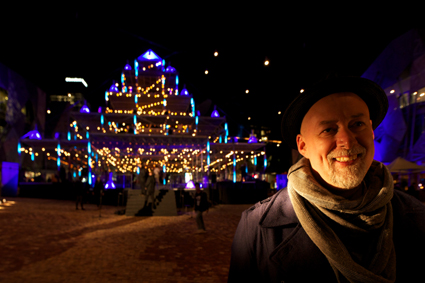
Bruce Ramus, Light Hearts, Light in Winter Festival
photo Jason South
Bruce Ramus, Light Hearts, Light in Winter Festival
NOW IN ITS FOURTH YEAR, MELBOURNE’S ROBYN ARCHER-DIRECTED ANNUAL LIGHT IN WINTER FESTIVAL HELD AT FEDERATION SQUARE HAS GROWN INTO A MULTI-FACETED EVENT IN WHICH LARGE-SCALE PUBLIC ART COMMISSIONS SHARE THE STAGE WITH A PLETHORA OF COMMUNITY-BASED INITIATIVES. FOLLOWING THE WORLD PREMIERE OF RAFAEL LOZANO-HEMMER’S SOLAR EQUATION IN 2010 (RT97, P23), THE CENTRAL WORK THIS YEAR WAS LIGHT HEARTS BY FELLOW CANADIAN, NOW MELBOURNE RESIDENT, BRUCE RAMUS.
Ramus is best known for his pioneering work as a lighting director for leading rock bands, including a 15-year stint with U2. More recently, he has turned his talents to urban design projects, including art installations. Light Hearts is a 13-metre-high pyramid-shaped platform, festooned with more than 2,000 bulbs, video screens and multi-hued strip lights. But its most notable feature is its open invitation to other artists and members of the public to contribute to the work. I spoke to Bruce Ramus a few days after Light Hearts opened.
How did you begin working with light?
My mum was an amateur actress, so I spent a lot of my youth hanging around community theatres and just kind of watching that process of how light affects how I feel about what I’m watching. The process is, I think, really visceral, really in our bodies. That’s where we really get it…it’s not something that happens cerebrally.
It seems to me that there was a big change in the music industry through the early and mid-90s with the integration of video into the stadium rock event in tours like the Rolling Stones’ Wheels of Steel and U2’s Zoo TV.
For me, certainly, the tour was Zoo TV. Prior to that, video had been a peripheral part of large-scale rock concerts. It largely sat on the outskirts of the stage. Zoo TV is when we took the screens and the imagery and moved it all to the centre of the stage. We made five large video walls and had about 200 televisions dotted around the set in groups of twos and threes, making one large, albeit fractured, canvas. The whole idea was a media barrage.
What difference did it make to your role as the lighting director with so much ambient light coming off a large bank of screens?
It allowed the lighting system to do less, so that I could turn it off and let the screens run. I learned to lay back and let the video do the work. And that was really beautiful, because when I did join in, it had a much stronger effect. As it is in any medium, the less you use it, the more powerful it is.
It would have been a few years after ZooTV, I guess, that LED started to become a viable video format?
In 1996, we wanted to develop a new type of video system. At the time, there existed a red and a light green LED, like we see on little power switches on our amps and our microwaves. So we asked Saco in Montreal if they could build blue and a full spectrum green LEDs, which they did. We then took that to Innovative Designs in Belgium and they made the prototype module which became the first ever LED video screen. Then we toured it in 1996-97 on the PopMart tour, which was the largest video screen yet built. It was about 70 metres wide and about 25 metres tall.
On that tour we did 130 shows for over two years, all outdoors. And I watched every audience walk out of there slack-jawed and stunned. Which was not my experience on Zoo TV, where they were vibrant, engaged. It really made me think about why this was happening. I noticed myself that I was watching the screen more than the band. So, there was a problem there.
Since then I have learned that when there is a higher resolution, there’s very little gap in the pixels, so the brain of the viewer does nothing to understand the image. The image just floods in. It’s a very passive experience. But when you start to separate the pixels, the brain automatically has to make up the gap. So it becomes a much more active experience for the viewer. Where on PopMart it was a bit like a music video. You know, we’re cutting to this, cutting to that on the beat, on the guitar solo, you see the strings of the guitar…no energy, a bit numbing.
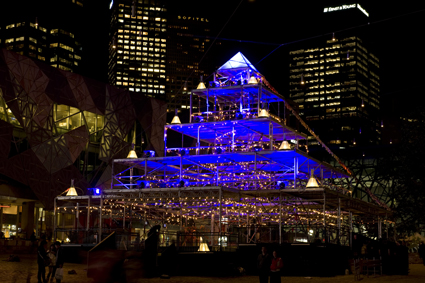
Light Hearts, Light in Winter Festival
photo Fred Kroh
Light Hearts, Light in Winter Festival
Walking through Light Hearts just now I was struck by a strong sense of ritual. That seems like a connection for me to the rock shows, which are a ritual event for a lot of people.
That’s great. Yeah, you get it. The ritual for me is indeed a part of how I design anything…in terms of the history of theatre and how that began as a ritual of transformation. For me, those ceremonies and rituals are why we attend these events, because we all somewhere believe that there’s a potential, however small, for personal transformation. So, that’s how I began thinking about this.
I was asked to come up with an idea to unify the festival. I did want to build a framework for activities and for people to gather in the day, so that it just wasn’t something that sat there and came alive at night and had no role in the day. And so I started to consider a structure and immediately the pyramid came to mind.
You know, the word ‘pyramid’ has many translations, but the one that resonated for me was from the Greek ‘pyra,’ as in pyre, meaning a measurement of fire or light. And then I started to look deeper into why the pyramids were built, the great pyramids in Egypt, and found a lot of consensus on the building of them as an energetic healing symbol. This just kept deepening my connection to this shape and this structure. And a further aim was to make it light-hearted so that anybody could come and respond to this. Anyone could come and build a lantern or tie a piece of fabric on it or, there are so many ways to address it.
Every Saturday we build lanterns with children. It’s just fantastic to see. And then you start to see the other side of light, the light in the child’s eyes when they get to create something, leave their mark on an urban landscape, become part of something bigger.
How would you compare the work here with the way in which an audience participates in a rock event?
In a large stadium or in any show, you know, the audience is very controlled. They aren’t necessarily aware of that, but as the ones who push the buttons with the lights and the video, we have a level of influence on where everyone looks, how they will feel at any given time. With this, it’s much less controlled and it feels really interesting to have that…You know I’ve contacted artists like the Yarn Bombers. Today, I’ve spoken with a graffiti artist who’s coming tomorrow to begin painting some of the bits. And I don’t really know what they are doing and I’m just letting that happen.
How does that work for you? Because as a lighting director you’ve usually got to be really in control.
Yeah, it’s true. There are elements of this that I have controlled quite tightly. There is a lighting system installed on the pyramid, and we programmed it so it has a set of scenes or cues that it runs every night. And it runs through those from 5pm to midnight and then goes into its resting state, its breathing state, which is just one breathing cue that goes to 6am. So that part of it is quite strictly controlled. But then there is this whole interactive element to it. And the one thing that I’m finding more and more important in all of my installations is this interactive element. People do it with their bodies. It’s not something that you have to think about necessarily. You just go in, you can do something with your hands and put it on the structure. That was really important for me, to be able to let control go, give it to the people who wish to engage with it and let them do what they wish.
It will be interesting to see how people just appropriate the space themselves.
Yeah and I’ve seen that happen at night, when there’s no set agenda. The jazz festival was on and there were about 25 young people and they were all dancing around the bottom level of the pyramid…holding hands and swinging and running around the central core…magic. I just loved to see it.
Federation Square’s The Light in Winter, Melbourne, June 2-July 3
RealTime issue #104 Aug-Sept 2011 pg. 33
© Scott McQuire; for permission to reproduce apply to realtime@realtimearts.net
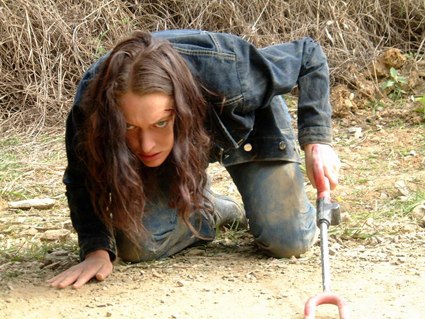
Felicity Mason, The Undead
THIS ARTICLE CONTINUES TO EXAMINE THE CHARACTER OF NOTABLE FILMS FROM AUSTRALIA’S RECENT HORROR BOOM. PART ONE, IN REALTIME 103, FOCUSED ON SAW, WOLF CREEK, BLACK WATER AND INSIDIOUS. HERE I TURN TO OTHER FILMS THAT VARIOUSLY ENGAGE WITH AUSTRALIAN CHARACTER, LANDSCAPE, ACCENT AND MUSIC WHILE COMMITTING TO OR SUBVERTING GENRE FORMULA, OR BOTH.
undead
Like Saw creators James Wan and Leigh Whannell, the Spierig brothers are a young filmmaking duo whose hard work and hands-on commitment to the horror genre has paid off in terms of international success. Brisbane twins Michael and Peter Spierig, graduates in graphic design and film respectively, made about 20 short films together before pooling their savings to make Undead (2003).
Their interestingly flawed first feature displays visual flair, an eye for detail and an obvious love of genre film. The plot is generalised horror/sci-fi—a pastiche of spoof, zombie apocalypse, alien invasion, Western and heroic fantasy. The setting, however, sleepy fishing town Berkeley, is unabashedly Australian. Much attention is devoted to the creation of bucolic local colour. “Welcome to Berkeley,” reads a sign, “Come drop a line.” Protagonist René (Felicity Mason) has recently won the “Miss Catch of the Day” beauty pageant. There are shots of kids fishing, a local cricket match, agricultural life. The local fruit shop bears the legend, “Elvis Parsley’s Grapelands. Berkeley Fruit—Fit For the King.”
The local colour is extended to colourful locals, with a distinct ocker element that’s particularly embodied in the character of Harrison, a cop. This is amusingly juxtaposed with the film’s paranormal subject matter: “When I was a kid, we fuckin’ respected our parents,” Harrison barks, “we didn’t eat ‘em!” René, with whom the audience identifies, is the only character to escape caricature.
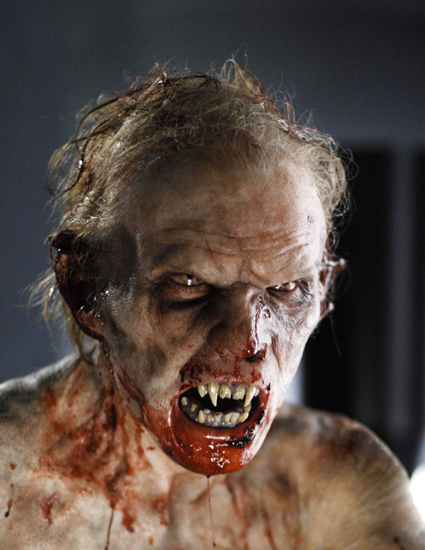
Daybreakers
courtesy Lionsgate Films
Daybreakers
daybreakers
Like Undead, Daybreakers (2009), the Spierigs’ more sophisticated (and bigger-budget) follow-up is visually adept, beginning with its introductory montage that sets the scene for a bleakly futuristic scenario. The brothers have once more turned to genre horror with a vampire film, but this one turns the tables: in the wake of an international plague, vampires have become the majority, the norm, while humans are a dwindling minority hunted down and harvested for their blood.
The vampires’ world is portrayed with elements of sci-fi noir à la Blade Runner (1982). The 1940s costume styling, moody lighting and cool blue tones contrast with the daytime world of the human survivors, whose warmth has a correspondingly bright, colour scheme that is recognisably Australian. Despite the cool stylisation, there’s some expertly timed gore, as when a vampire soldier testing a blood substitute explodes spectacularly. The film’s ultimate thrust is heroic, however, with a phoenix used to symbolise the resurgence of the human race.
Apart from Ethan Hawke and Willem Dafoe (playing an ethical vampire and human resistance fighter respectively) the cast is made up of well-known Antipodeans: Sam Neill, Claudia Karvan, Vince Colosimo, Isabel Lucas, Jay Laga’aia. But it seems that one of the vampire plague’s side effects is the acquisition of an American accent, for all that we appear to be on Australian territory. As Michael Spierig explained at a Popcorn Taxi Screening (www.popcorntaxi.tv/events/past/daybreakers-with-the-spierig-brothers/) this is the result of perceived financial necessity, where recouping a large budget means appealing to a ‘universal’ audience. Arguably, the film’s confused national identity makes its fantasy less convincing, especially to a local audience.
dying breed
Jody Dwyer’s 2008 film Dying Breed cannot be said to suffer from any such lack. Any discussion of recent Australian horror is incomplete without mention of this film, which bends over backwards to incorporate Australian history and Australian signifiers. As we follow four protagonists into the Tasmanian wilderness, we encounter spectacular scenery, Australian convict and cannibal history, meat pies (these last two not unrelated) and the tiger itself. Further Australian horror credentials are established with the casting of Saw’s Leigh Whannell and Wolf Creek’s Nathan Phillips in lead roles.
Despite the pronounced Aussie flavouring, the film follows the tenets of a certain American horror sub-genre which can roughly be described as ‘don’t mess with the locals,’ where holidaying urbanised outsiders fall prey to an insular, inbred community, as in Wes Craven’s The Hills Have Eyes (1977), Rob Zombie’s House of 1000 Corpses (2003) and the recent Resurrection County (2008). Such films often feature two young heterosexual couples driving into a natural location that is unfamiliar to them. In Dying Breed, Irish zoology student Nina (Mirrah Foulkes) is accompanied by Australian boyfriend Matt (Whannell), Matt’s crass mate Jack (Phillips) and the latter’s girlfriend Rebecca (Melanie Vallejo) in the search for the Tasmanian tiger that Nina’s sister was involved in at the time of her mysterious death. In keeping with the formula, the group encounters a ‘quaint’ community with a suspicious attitude towards outsiders. Over the course of the film, this will escalate into a bloodbath. Gender roles in this sub-genre are usually traditionally defined, with women tending towards hysteria while men take action.
Thus, Dying Breed follows a conventional overarching narrative, but remains enthusiastically Australian in its particulars. Though appearing appropriately dark and gothic, the wilderness is not imbued with menace in itself—the real threat resides in the community it harbours. The film’s horror comes out of this community’s adherence to tradition (a constantly reiterated theme) to family customs rooted in Tasmania’s dark history. Shackles and convict portraits are displayed in the primitive pub where the travellers find themselves. This community, we are about to discover, is descended from escaped convict-turned-cannibal Alexander Pearce, known as the “Pieman.” “The pies have hung on,” explains publican Harvey (Bille Brown) as the tourists dig into the local delicacy, “it’s important to us, tradition.”
Towards the end of the film, a clear analogy is drawn between the elusive Tasmanian Tiger and Pearce’s descendants: “Things have to stay hidden—to survive,” Harvey explains.
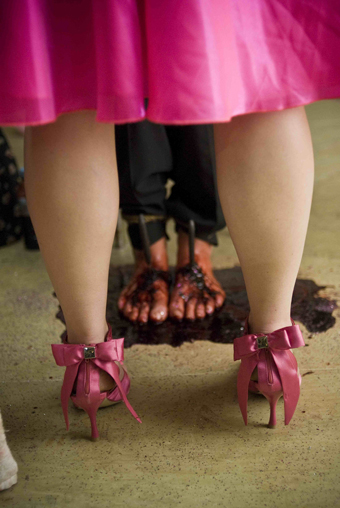
The Loved Ones
courtesy of Koch Media
The Loved Ones
the loved ones
Writer-director Sean Byrne’s first feature, The Loved Ones (2009), feels as authentically Australian as Dying Breed, but for different reasons. Despite its many American cinematic influences, notably Misery (1990), Carrie (1976) and Dazed and Confused (1993), Byrne’s approach to characterisation, his use of landscape and soundtrack all contribute to a sense of Australian identity. The film starts off in teen territory with a rejection in the lead-up to a country high-school dance. Recently bereaved Brent (Xavier Samuel) turns down quiet girl Lola’s invitation to the event. The latter, aided by her father, exacts a sadistic and prolonged revenge.
The exaggerated characters of Lola (Robin McLeavy) and ‘Daddy’ (John Brumpton) are reminiscent of the ‘quirky’ strain of well-known 90s Australian films: Strictly Ballroom (1992), Love Serenade (1996) and Priscilla: Queen of the Desert (1994). McLeavy’s impressive portrayal of Lola has affinities with Muriel in Muriel’s Wedding (1994): childishness, a girlish obsession with romance and weddings, outsider status and an exaggerated manner that’s endearing in Muriel; grotesque in Lola. The use of Kasey Chambers’ plaintive ditty “Am I Not Pretty Enough” as Lola’s theme is another Australian association. Underlining the motifs of adolescent unrequited love and the feminine fear of not measuring up physically, the song is played three times over the course of the film.
In her final scene, a bloodied Lola makes her steady, murderous way along a deserted road, singing Chambers’ song. Centre screen, she’s framed by the landscape, which accentuates her alienation and monstrosity. This image is an inversion of the similarly memorable scene from Greg McLean’s Wolf Creek (2005) where an injured Kristy attempts to escape along a deserted outback road. It’s one of The Loved Ones’ emblematic moments, encapsulating key narrative themes of loneliness, loss, warped femininity, violence and obsession.
enter the audience
While the Spierig brothers move into potential blockbuster territory with a 3D remake of The Dark Crystal (1982), two new Australian horror films are breaking ground by involving audiences in the filmmaking process via the internet. The Tunnel (2011) raised its modest 135K budget by pre-selling each of the film’s frames over the internet and on completion was released for free online. Upcoming office horror film Redd Inc. created a large online community by encouraging internet submissions of material—from performances to artwork—for inclusion onscreen. Interestingly, these two films also signal a shift away from the natural landscape towards an urbanised Australian horror, though it seems a safe bet that our open spaces will always have their place in the darker Australian cinematic consciousness.
RealTime issue #104 Aug-Sept 2011 pg. 34
© Katerina Sakkas; for permission to reproduce apply to realtime@realtimearts.net
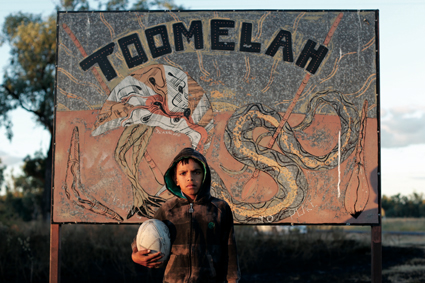
Daniel Connors, Toomelah
TOOMELAH IS A SPECK ON THE MAP BETWEEN MOREE AND GOONDIWINDI IN NORTH-WESTERN NEW SOUTH WALES. A FORMER MISSION, ITS HISTORY REFLECTS THAT OF AUSTRALIAN BLACK/WHITE RELATIONS IN EERIE SYNECDOCHE: POLICIES OF ASSIMILATION, CHURCH INTERVENTION AND THE STOLEN GENERATION; RECOGNITION OF LEGAL RIGHTS, CULTURAL AMNESIA AND THE SOCIAL CORROSION WROUGHT BY DRUGS AND ALCOHOL; POLITICAL APATHY AND INEPTITUDE, INTERRUPTED SERVICES AND DECAYING INFRASTRUCTURE.
Toomelah came to national attention in 1987 when it was visited by Marcus Einfield, then President of the Human Rights and Equal Opportunities Commission, to see first-hand its appalling living conditions, then again in 2008 when its District Nurse resigned, exhausted by 20 years of bearing witness to endemic neglect and abuse. It’s also where director Ivan Sen’s (Beneath Clouds, 2002, Dreamland, 2010) mother grew up. His third feature is a quietly gripping portrait of the community and paean to childhood. The film opens with a young boy, Daniel (Daniel Connors), waking to an empty house—and fridge. His mother spends her days in a haze of marijuana smoke, while his grandmother sits quietly in the sun, alone with her memories. Free to fend for himself, Daniel wags school, dreaming of becoming the boxer that his father (Michael Connors) was before alcohol claimed him, or a ‘gangsta’ like Linden (Christopher Edwards), the local dope dealer and default father-figure to Daniel.
The film unfolds gently, what plot there is arising from the sluggish rhythms of daily life in the settlement. Daniel’s Great-Aunt Cindy returns for a visit, decades after having been stolen from her family; Daniel valiantly pretends he doesn’t care whether 10-year-old Tanitia (Danieka Connors) likes him or not, while nursing a grudge against another child, Tupac; and Linden struggles to maintain control of the local drug trade when Bruce (Dean Daley-Jones) is released from prison and returns to town.
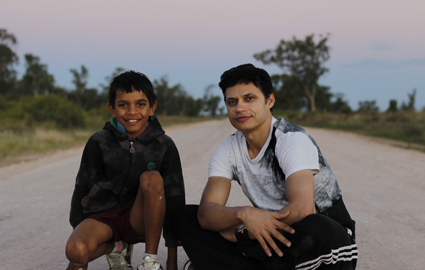
Daniel Connors, Ivan Sen, Toomelah
Connors is excellent as the mischievous Daniel, a wide-eyed observer in an adult world, discovering its limits with thoughtful curiosity. It is at times a brutal world however, and Sen is unflinching in his depiction of the community’s degraded circumstances—some may be turned off immediately by some extremely coarse language—while simultaneously showing tremendous compassion towards his subjects: the elderly, burdened with a history of dispossession and cultural destruction; their addiction-ravaged offspring; and the new generation who seemingly face a bleak future of stunted opportunities and more of the same.
Sen wrote the film after visiting for several months, his observations of daily life and transcriptions of local conversation providing the raw grist for his script. Despite the spectacular natural beauty of the surrounding country, monumental landscape shots are few and far between; Sen instead shoots his script using a handheld Panasonic 3700 in a rough and ready naturalistic style that suits the material. In this respect, the film employs techniques Sen explored in his experimental second feature film, Dreamland, allowing the story to develop to some extent as the film was shot. Although he doesn’t strive for the kind of visual poetry achieved in Beneath Clouds, Toomelah brims with unobtrusively observed visual detail: black and white photos of people in traditional garb hanging on the school library wall; late afternoon sunshine cutting across kids playing footy in the dusk; a broken exercise bike lying discarded amongst rusted car bodies.
Some may feel the film’s technical limitations detract from its overall impact, however the benefits gleaned outweigh the advantages of a full production unit. Sen’s approach is personal and direct, allowing a level of community engagement that would otherwise have been impossible. Most roles are played by local non-professional actors, their efforts bringing an immense sense of authenticity to the film. That said, the acting, although generally effective, occasionally sags, a fact not helped by Sen cramming historical information into dialogue, to the detriment of the film’s otherwise mesmerising realism. Also, at 106 minutes, it goes for a quarter hour longer than necessary, its pleasing messiness sprawling into flab.
Ivan Sen has remarked that the film should “not be seen as political finger pointing”, and indeed it stands on its artistic merits. However, once the reality represented in Toomelah is accepted, politics must inevitably intrude. “What are you going to do with yourself?” Daniel is asked. “I dunno—what can I do?” is the ingenuous reply. Answering such a question is impossible for Daniel without having any perception of the realities of his circumstance—it is to Sen and the people of Toomelah’s credit that the beginnings of such an understanding might be gleaned from this wonderfully ragged film.
Toomelah was screened at 2011 Cannes International Film Festival in the Un Certain Regard Official Selection and at the 2011 Sydney Film Festival. Australian cinema release date to be announced.
Toomelah, writer, director, Ivan Sen, producer David Jowsey/Bunya Productions, www.toomelahthemovie.com
RealTime issue #104 Aug-Sept 2011 pg. 35
© Oliver Downes; for permission to reproduce apply to realtime@realtimearts.net
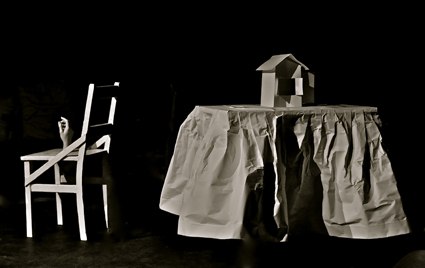
Home, Margi Brown-Ash, Free Range 2011
photo Bev Jensen
Home, Margi Brown-Ash, Free Range 2011
FREE RANGE AT METRO ARTS HAS BEEN DESCRIBED AS A FOUR-WEEK LONG CREATIVE DEVELOPMENT BOOT CAMP, AND THE METRO TEAM’S RESOLVE TO NURTURE PROCESS OVER PRODUCT MAKES IT A UNIQUE AND CRUCIAL INCUBATOR OF PERFORMANCE IN BRISBANE. IF THE AIM IS TO FOSTER NEW WORKS OUTSIDE DISTINCT ARTFORM PARAMETERS, FREE RANGE 2011 ALSO PROVIDED OPPORTUNITIES FOR AUDIENCES TO GAIN INSIGHTS INTO THE PROCESSES OF FAMILIAR, WELL-LOVED ARTISTS WHO HAVE BEEN WORKING INDEPENDENTLY ALONG THESE LINES FOR, WELL, A LONG TIME, IN ADDITION TO NEW AND EMERGING ARTISTS.
While ‘beautiful’ aesthetics were mainly on call (even the whimsical comedy of Neridah Waters trying to convince us she was ‘Dodgy’), I was drawn to works that were raw and seemed to emerge out of the corner of a frenetic eye, out of relatively unexplored emotional areas of the human psyche. These unexpected works weren’t age-related nor seeking to brand themselves. Circus artists Skye Gellmann and Ivan Smith in Something with Sabotage spelled out the nature of “attention seeking ego-driven self-indulgence (a performance).” On the surface, and this was true of the enthusiastic audience response to this piece of theatre larrikinism—they were a pair of likely lads. The show itself was hung on the bones of the tale of “Sinbad the Sailor and the Old Man of the Sea” from the Arabian Nights with Smith impersonating Sinbad as one of the great epic heroes “like Rambo and Rocky.” Gellmann, as the anti-hero and the old man basically perched on his head and shoulders strangling his performance. In the first act the audience was intimately on stage with the performers facing an alternative audience of balloon heads in the seats and gratefully escaping the attentions of the old man. However, there was a steely idea behind all this, as Gellmann notes, “Do I always feel the gaze (as a performer) even when I’m alone in the room? Does my shadow mock and reflection judge me?”
After an interval, when we were required to return through a different door, the second act conventionally distanced the audience and performers but witnessed the two performers in a meltdown deconstruction of the previous act, incorporating bizarre and disturbing imagery of male relations. Smith performed an immaculate juggling act in reverse that lost six balls while retaining one singing like a canary on his shoulder, while Gellmann, upside down, nude and utterly transfixing, like a creature from an Heironymous Bosch painting, inscribed hieroglyphics with his body around the walls of the theatre. More sabotage.
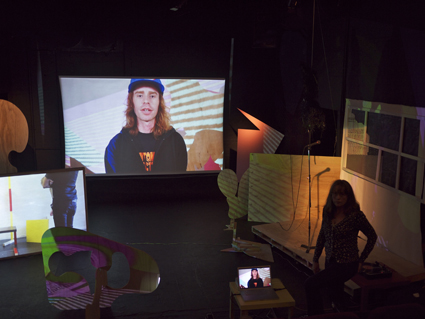
Artist’s Gamble with Time A portrait of Clint (An Expanded Portrait of Everyone)
When I met visual and installation artist David M Thomas he went for the chin by quoting Morrissey: “I don’t perform. Seals perform.” He stressed that his hybrid work, Artists Gamble with Time/ Portrait of Clint, An expanded portrait of Everyone was an enactment not a representation, putting it, of course, into the live art category; but nomenclature doesn’t go far enough to describe a work that was so refreshing and resonantly witty, seamlessly playing off elements of performance, music, photography, painting, installation and video like a form of free style jazz, “in order to explore the construction and maintenance of one’s self.”
Continuous video of a man and a woman constructing and deconstructing abstract, geometric assemblages of coloured blocks of wood evidenced the ecstasy of creative play as opposed to fetishism of the object. Plywood cut-outs evoking the abstract art of the early 20th century painter and poet Jean (Hans) Arp were surfaces for kinetic, op-art projections in vibrant pastels. Arp represented opposition at the time to the proscription of abstract art by both Stalinist Russia and Nazi Germany. He sat on the editorial board of Abstraction-Creation which made the statement in Cahiers no. 2, 1933: “…free thought is being fiercely contested, in many ways, on all levels, in some countries more successfully than in others, but everywhere.”
There was a mini stage above which hung, like a stalactite or nest of night creatures, what turned out to be a ridiculously tall black wig with Gothic connotations when worn by Archie Moore, an urban Indigenous artist and lead singer in Egg Vein, accompanied by Thomas in a leather jump suit on guitar. Unfortunately what I interpreted from the look as ‘horror country’ lyrics about life on the Darling Downs were indecipherable due to sound quality. These seemingly diverse elements framed and commented on what was not so much a portrait but an evocation that amounted to an abstract, almost sculptural assemblage through consciously distancing effects—Clint conceived of as an absence. A second film featured young people speaking fragments of Doyle and Thomas’ email dialogues Godard-style direct to camera within clever re-arrangements of the Arp shapes and projections mirroring the play with blocks. In case you’re thinking all this sounds like a spoof, it was—of 80s video clips, for one—but it wonderfully caught the essence of art as process, a ‘doing,’ and Thomas’ notion that all art is performance art. Loved it.
The Process Project involved Margi Brown Ash, Nikki Heywood and Brian Lucas in a year-long colloquy and exploration of performance hybridity from their perspectives as mature artists and from meetings with a community landscape designer, a restaurateur and a Buddhist terminal care worker. In a summary report on their experiences to a Free Range audience, they created an elegant three-fold schemata of the artistic journey given vivid immediacy by the shapes of Lucas’ sand mandalas and embodied by the journeyman, the villager and a desperate wanderer negotiating the wasteland. It was striking that art and life skills (techne) shared in common with others in the community seemed to be equally compounded by grace, as the Greeks would have it, not just productive efficiency. In an age when the arts are marginalised and grace is considered an option the economy cannot afford, theirs provided a civilised and reassuring conclusion.
This mutual involvement also enabled Brown Ash, as a self-admitted “senior artist” shortly turning 60, to re-imagine (with long time collaborator Leah Mercer) her life as an artist, wife and mother in it for the long haul in Home presented by The Nest 4 Change. Brown Ash it was who famously announced at the presentation of The Process Project that “IF I should ever die…” she would prefer to do so under Buddhist palliative care. Brown Ash has always been a performer who constantly surprises you with her strengths, and is also a skilled art therapist and counsellor. Superficially, Home resembled a form of drama therapy, but it was soon clear that this was no unexamined life. We were caught up in the headlong rush of Brown Ash’s artfully fragmented myth and storytelling—dashing back and forth from teenage years to young womanhood to middle-age; spinning out into the cosmos on the wings of the Egyptian gods Isis and Osiris; capturing members of the audience as her surrogates in different times and places as she roamed round the space with fierce, prowling energy. She was everyone’s bohemian mother (or the one you wanted), feeding you tea and biscuits—and home truths—with an unsentimental pellucidity that reminded me of the English poet Stevie Smith. Spawner of unusual progeny, one of whom went to Palestine to learn Arabic and another who went to Israel to learn Hebrew, Brown Ash’s new work is similarly prodigious in scope and potential. It was not intimate theatre but epic theatre about intimacy.
Free Range 2011: Something with Sabotage, Ivan Smith, Skye Gellmann; Home, Margi Brown Ash, Travis Ash, Bev Jensen, Leah Mercer; Artists Gamble with Time/ Portrait of Clint, an expanded portrait of Everyone, David M Thomas, Archie Moore, Suzanne Howard; The Process Project, Margi Brown Ash, Nikki Heywood, Brian Lucas’ Metro Arts Brisbane June 3-28
RealTime issue #104 Aug-Sept 2011 pg. 14
© Douglas Leonard; for permission to reproduce apply to realtime@realtimearts.net


![[Xuan] Spring, Ngoc Nguyen](https://www.realtime.org.au/wp-content/uploads/art/48/4854_priest_spring.gif)




































































